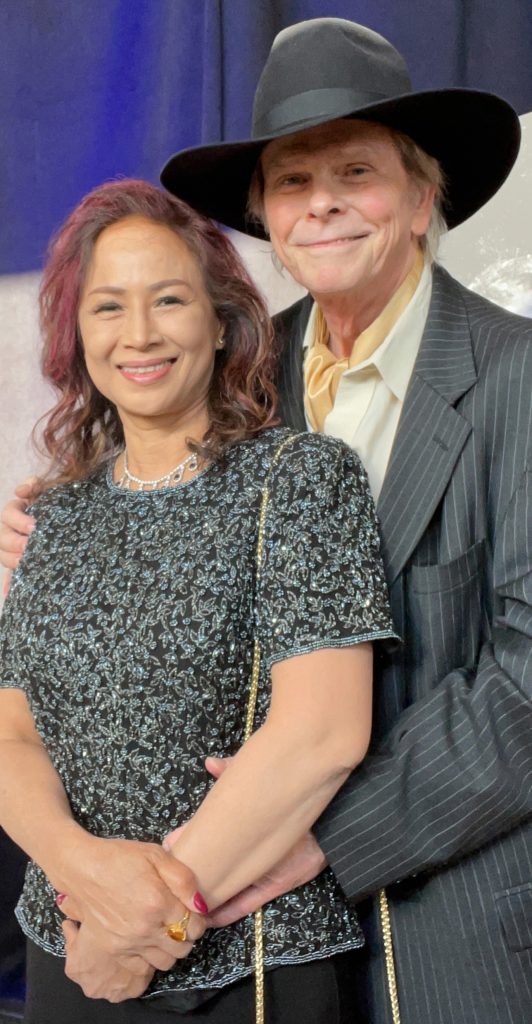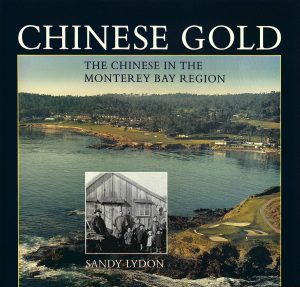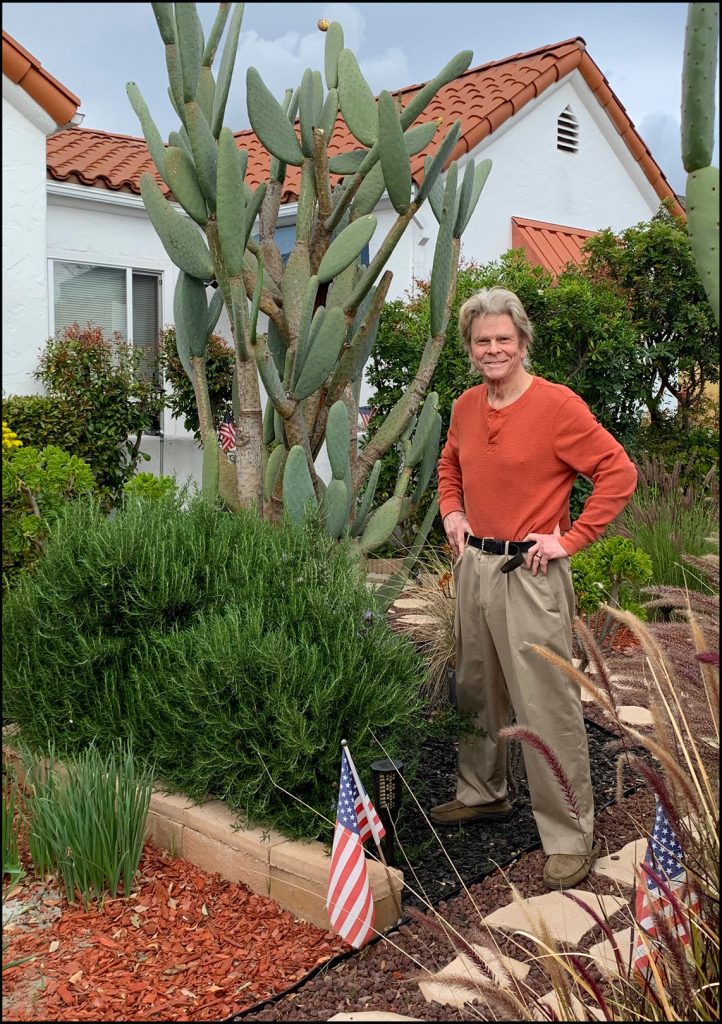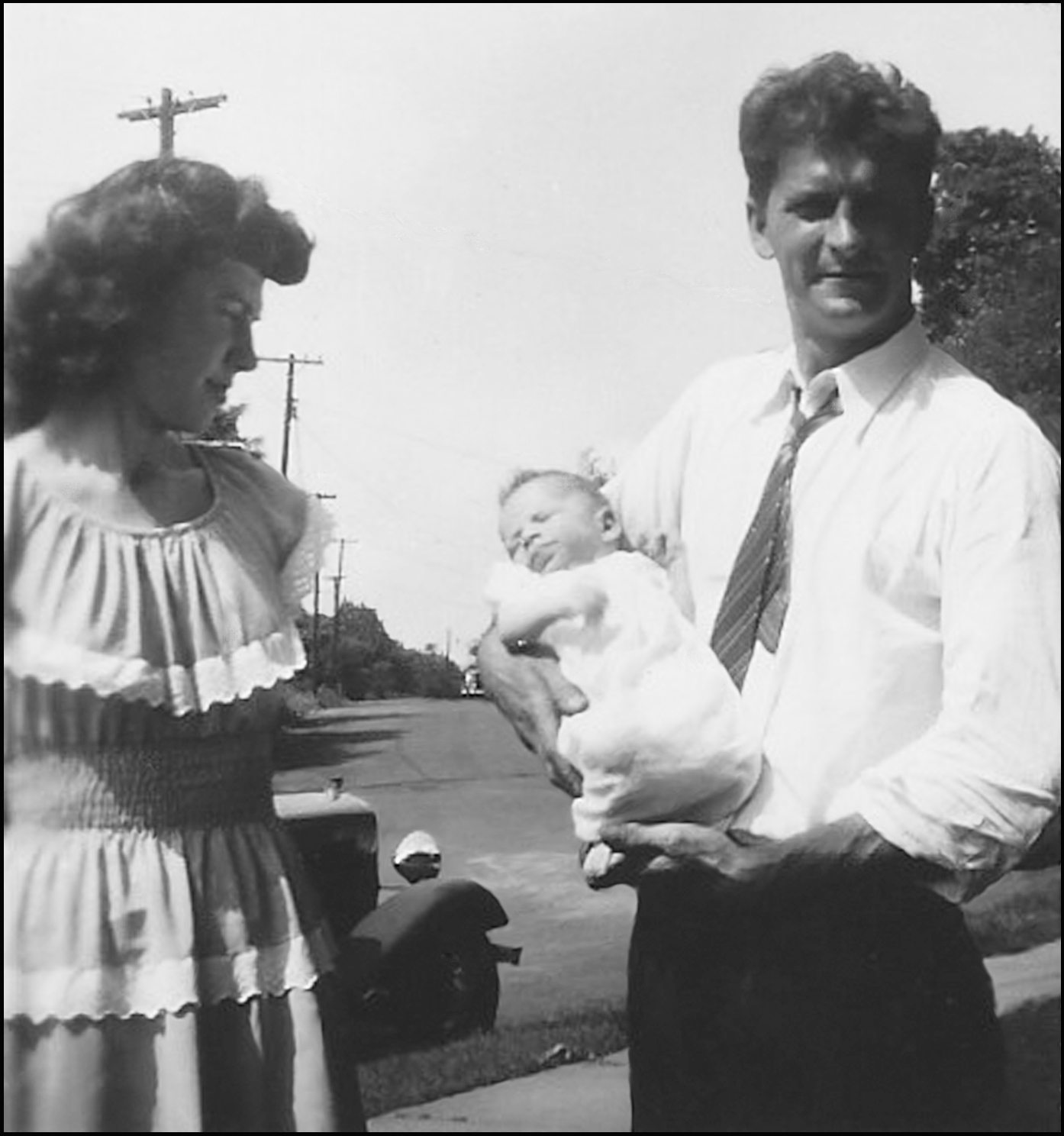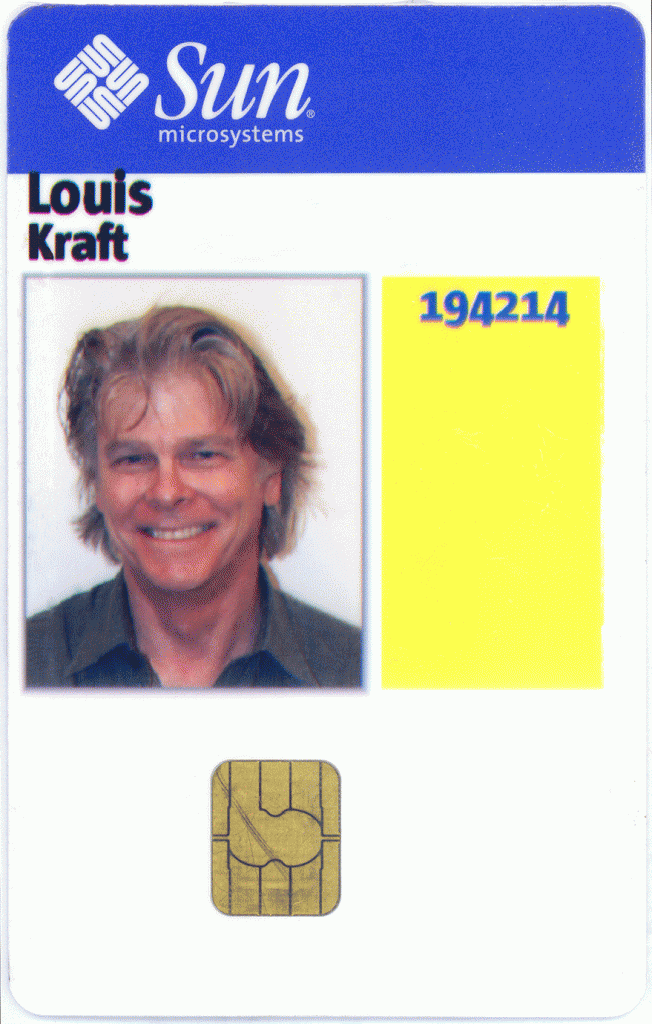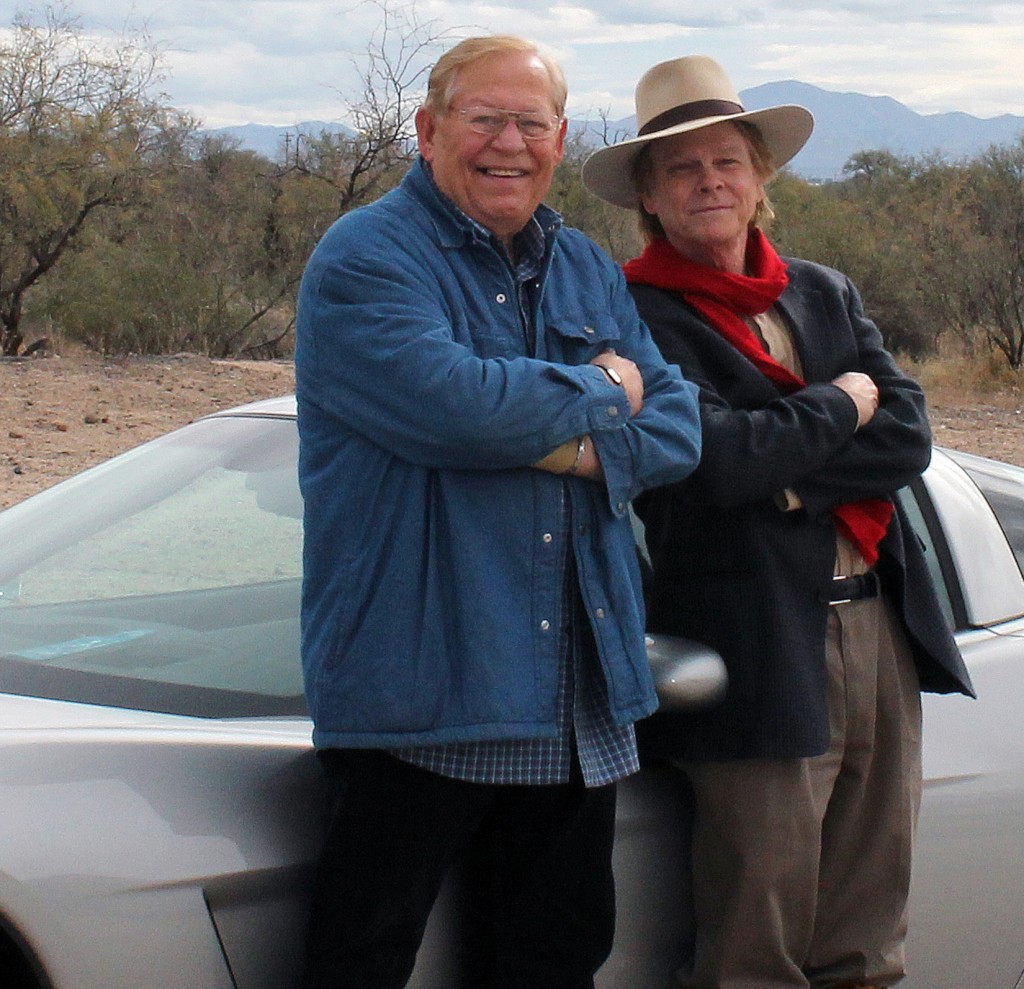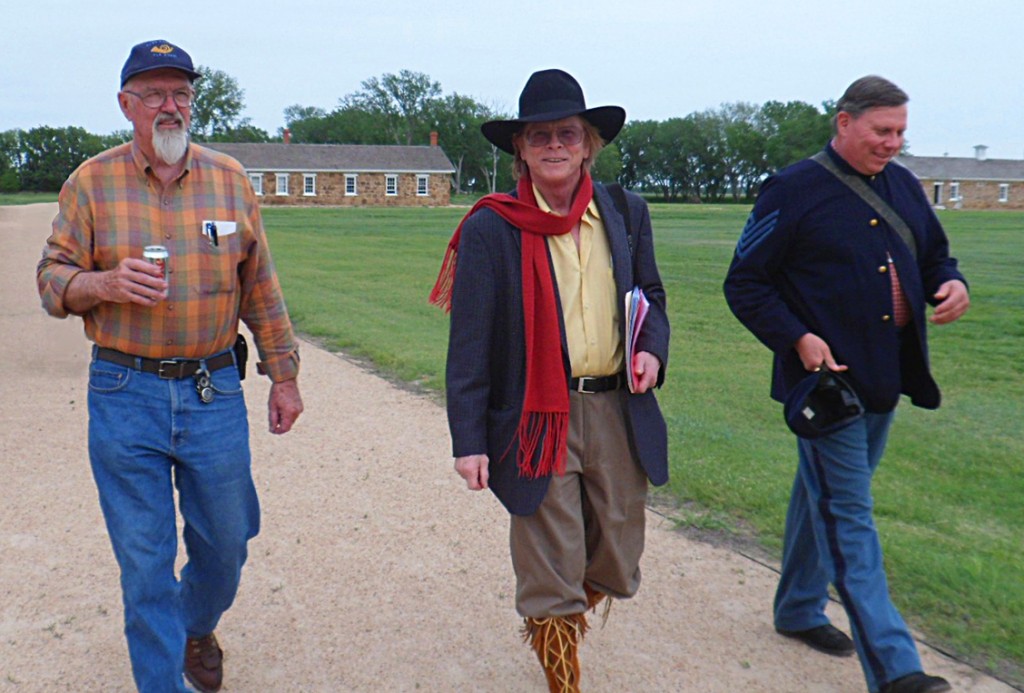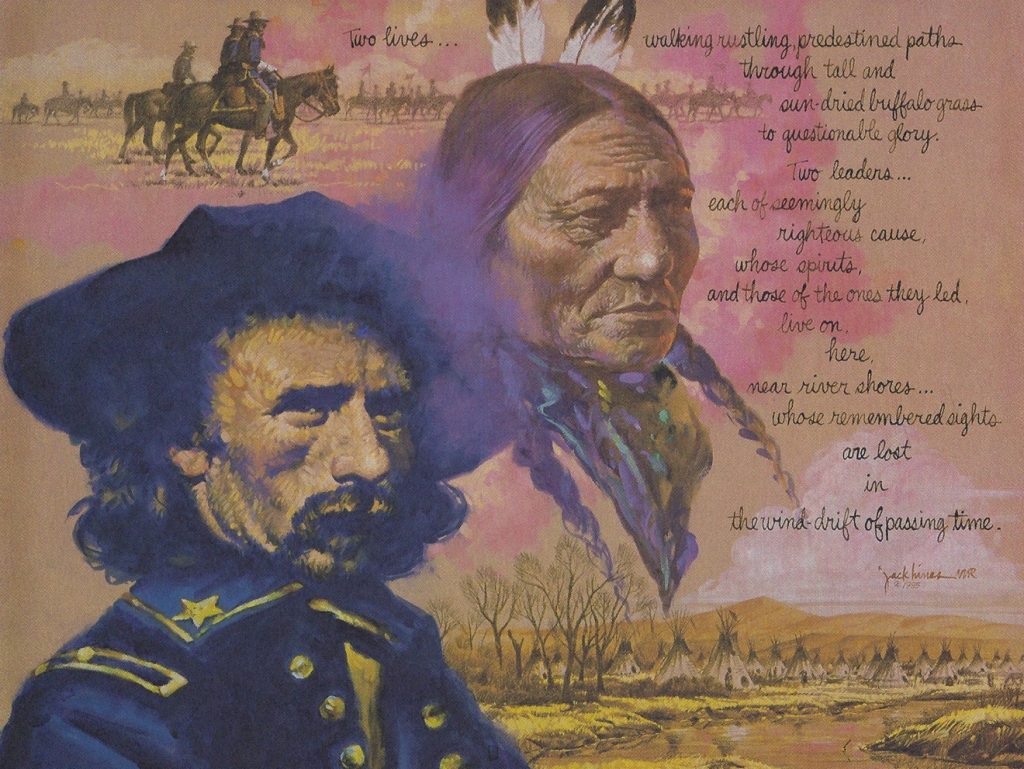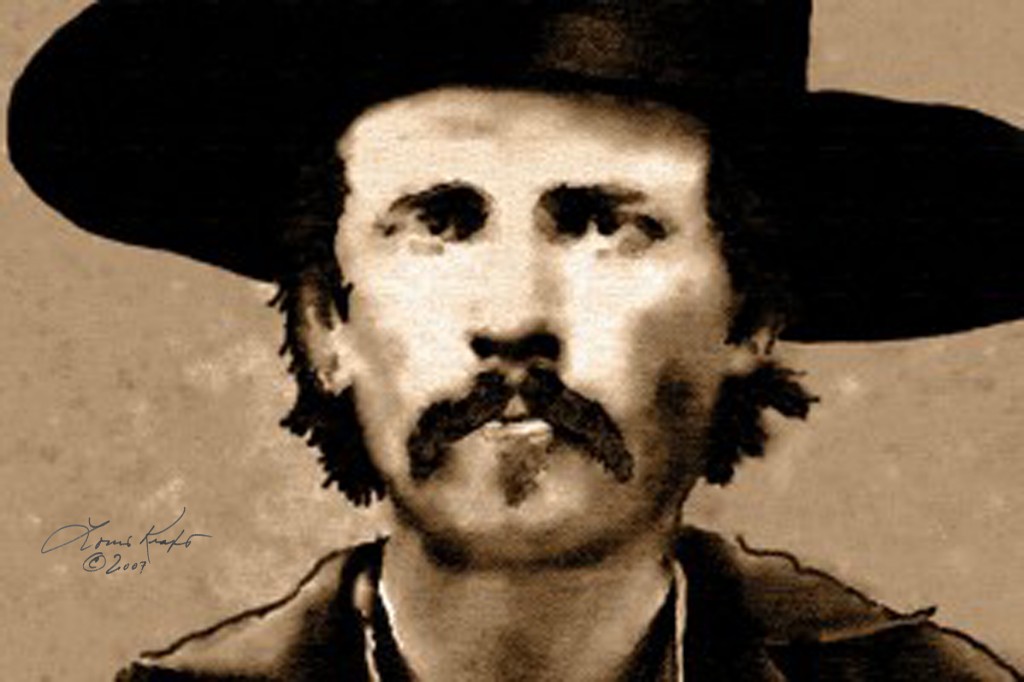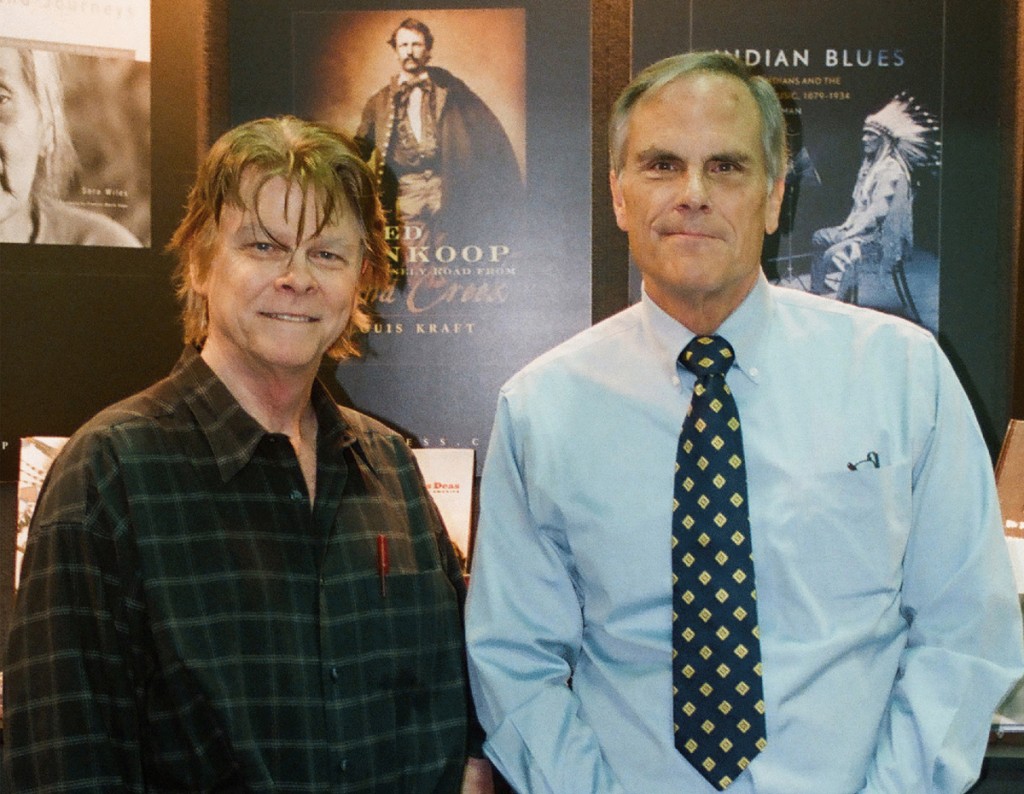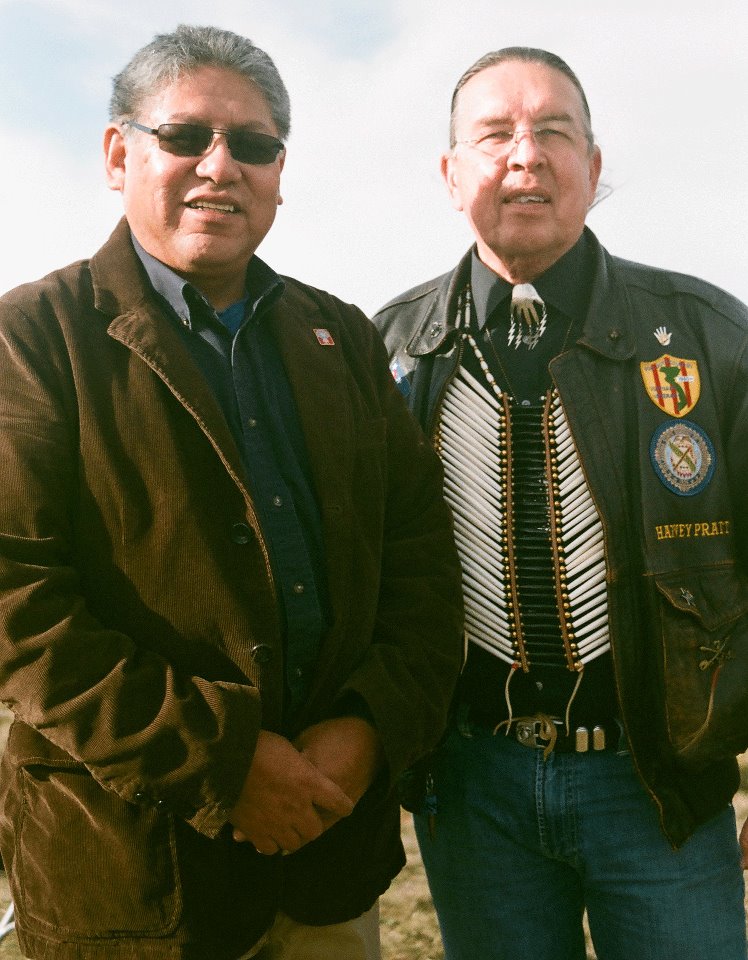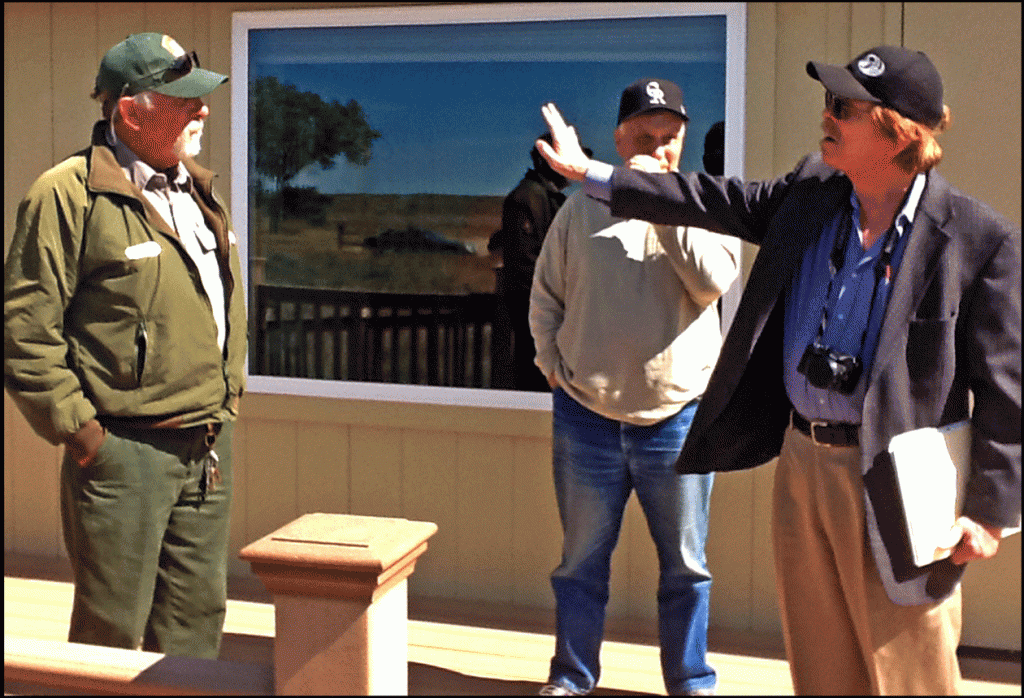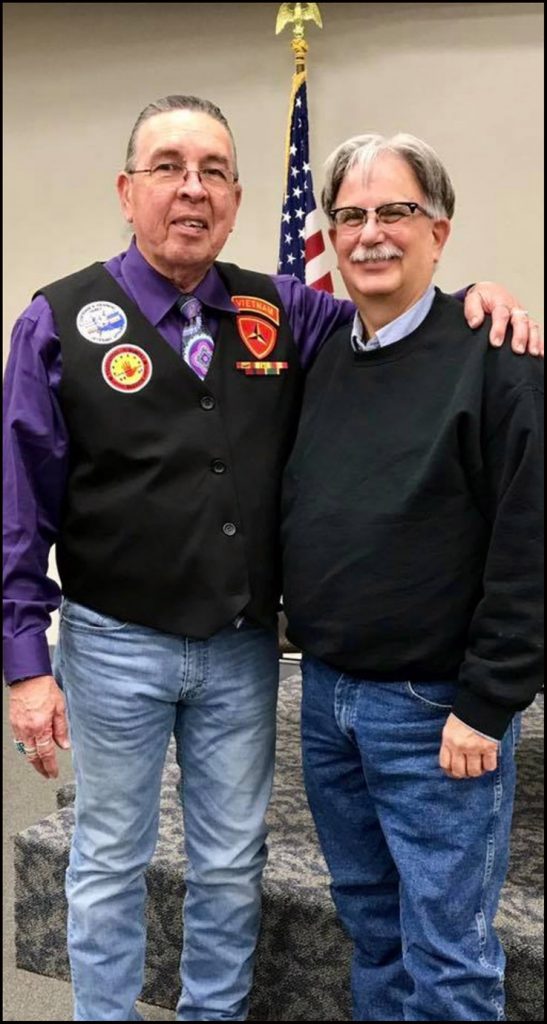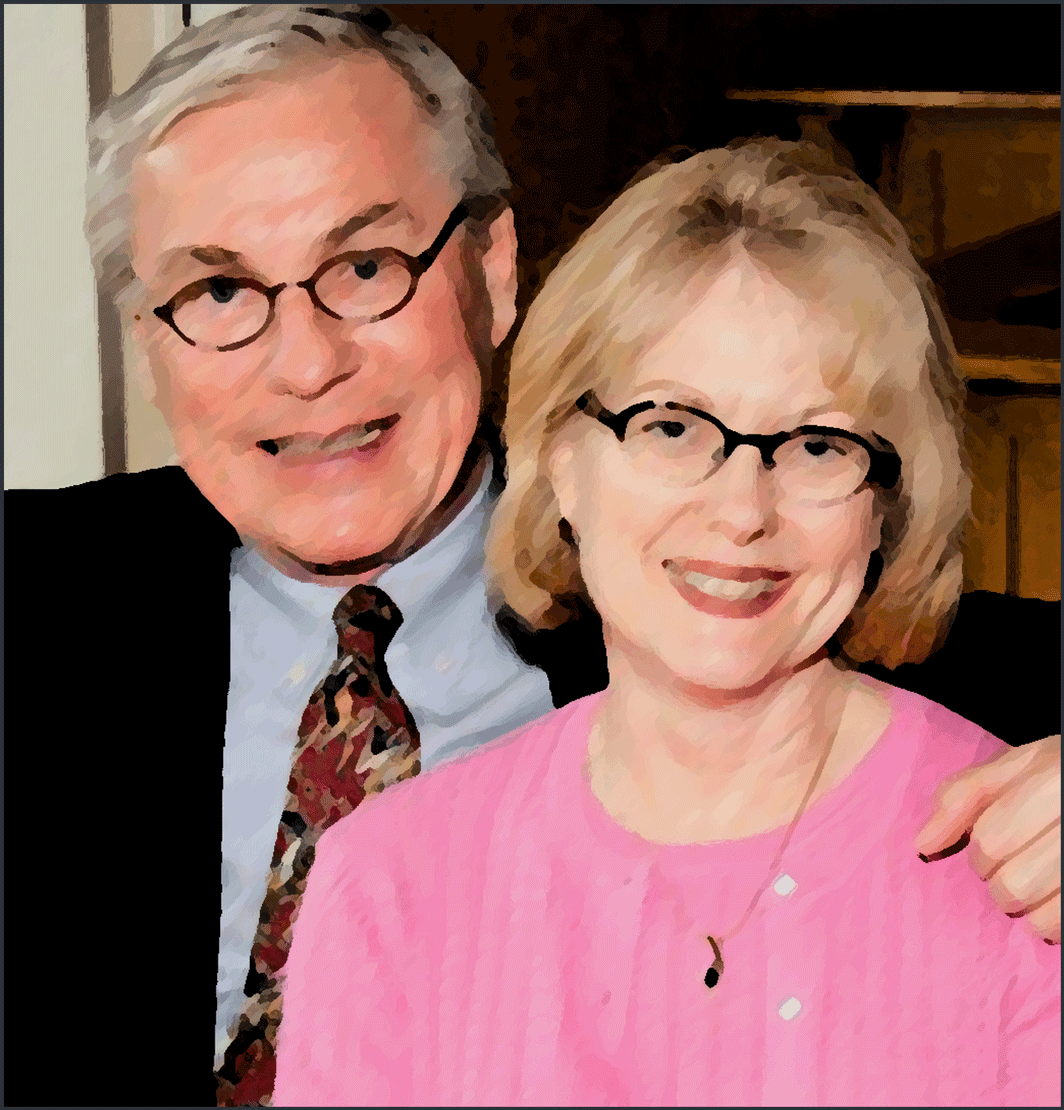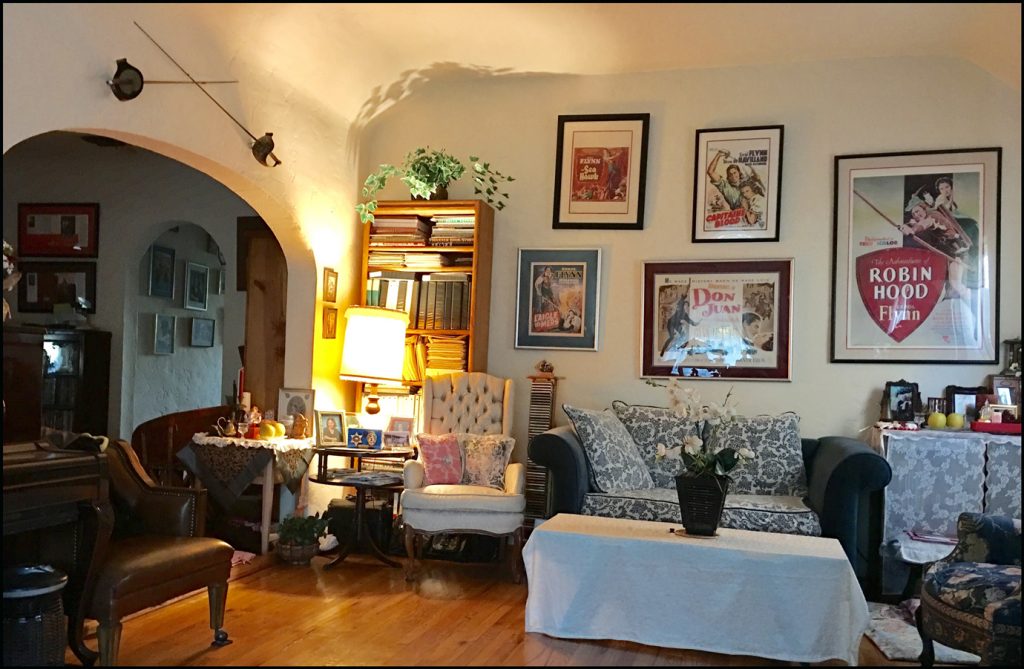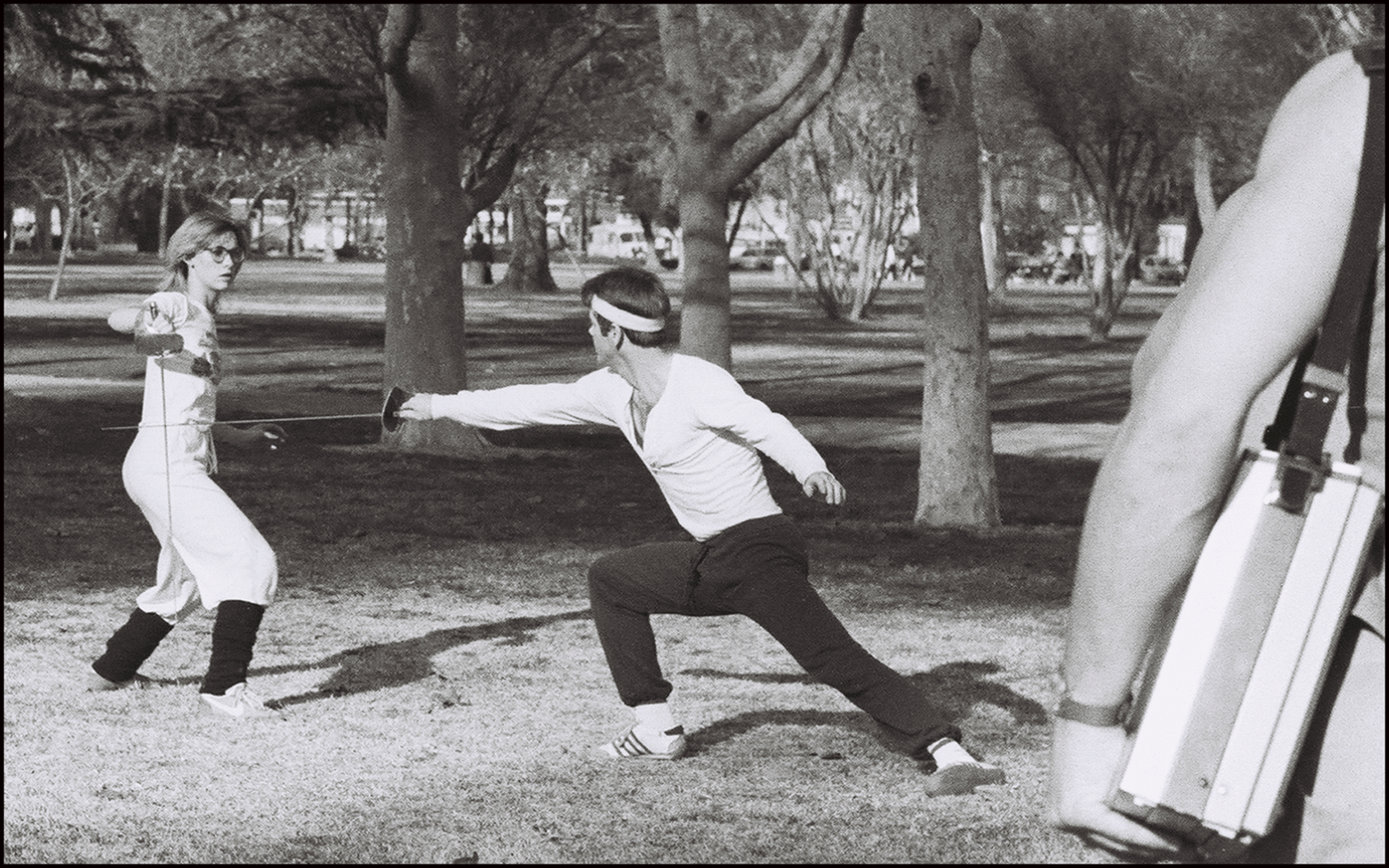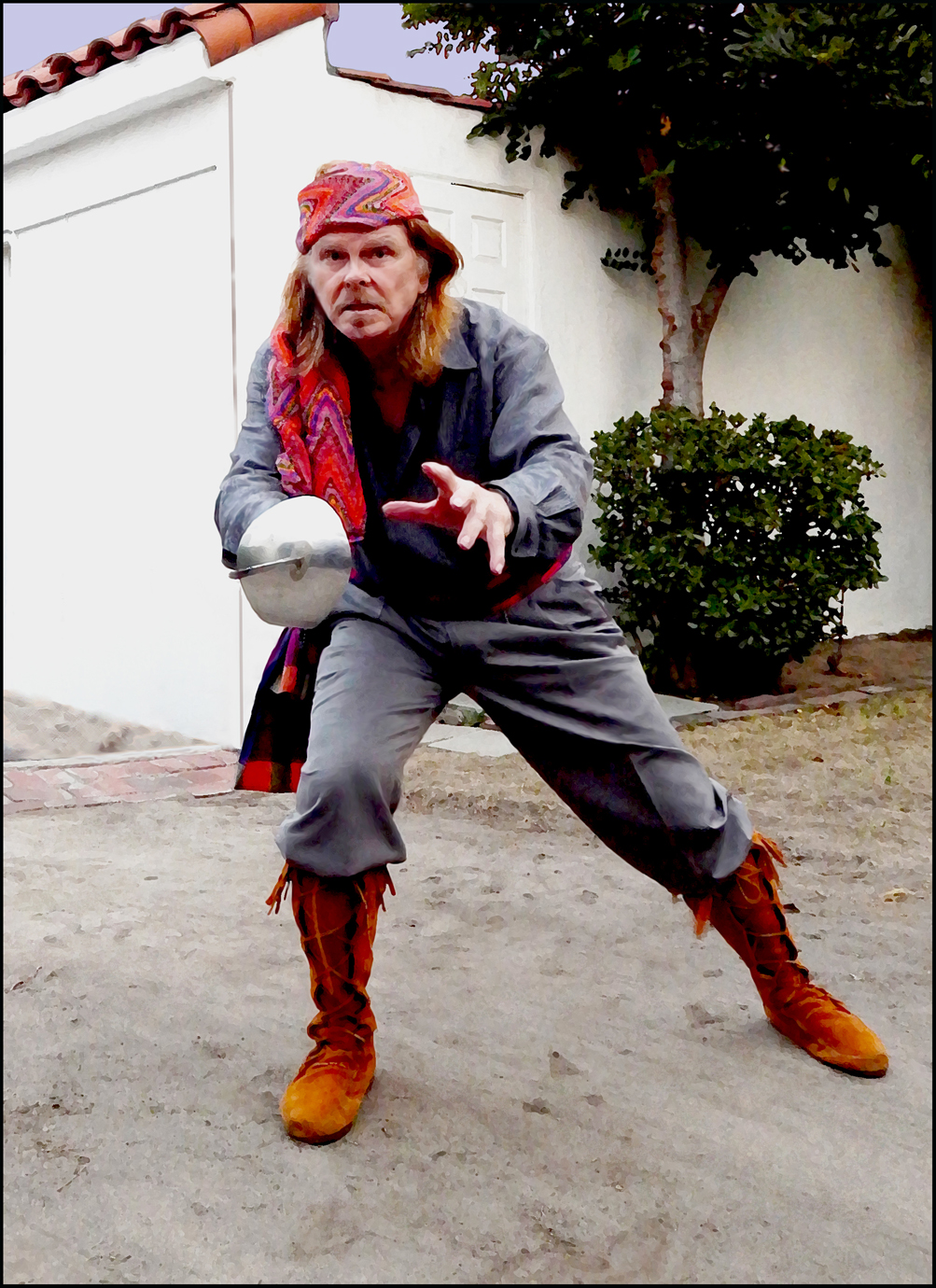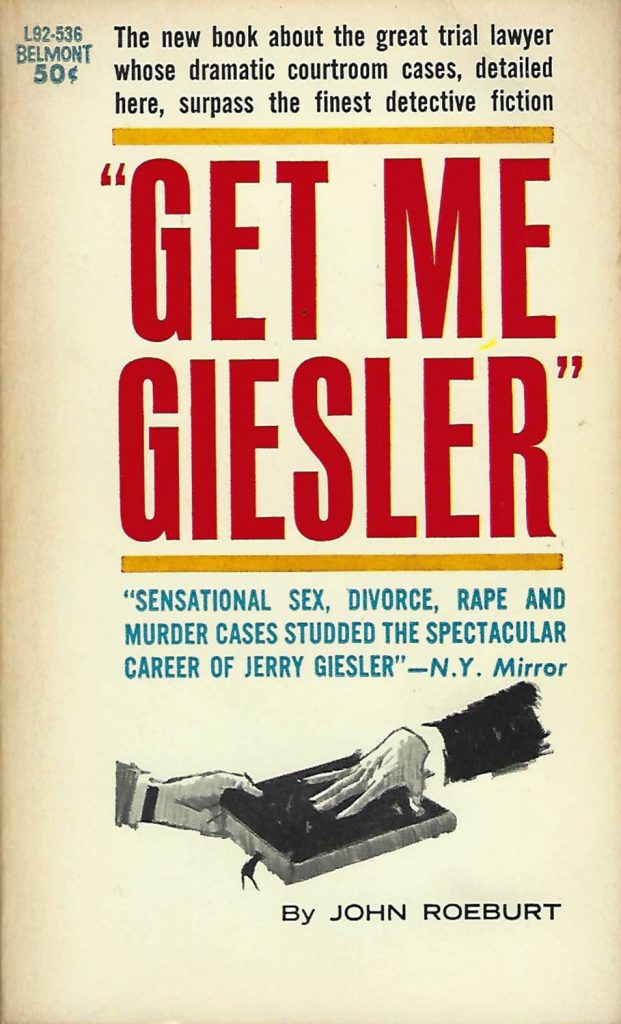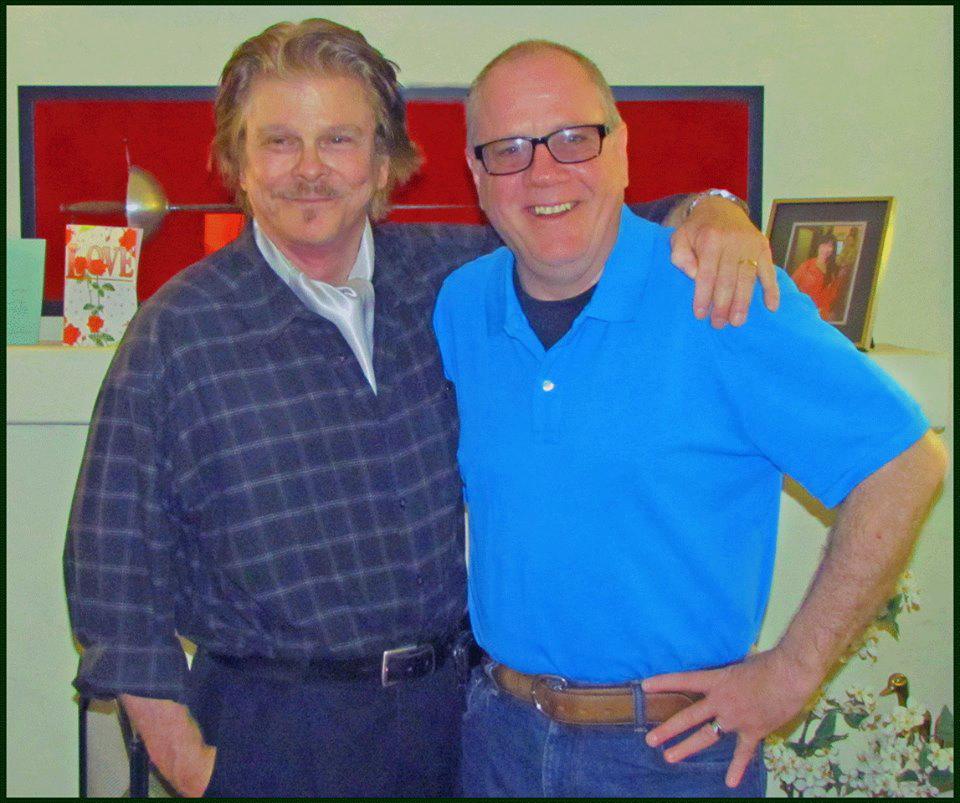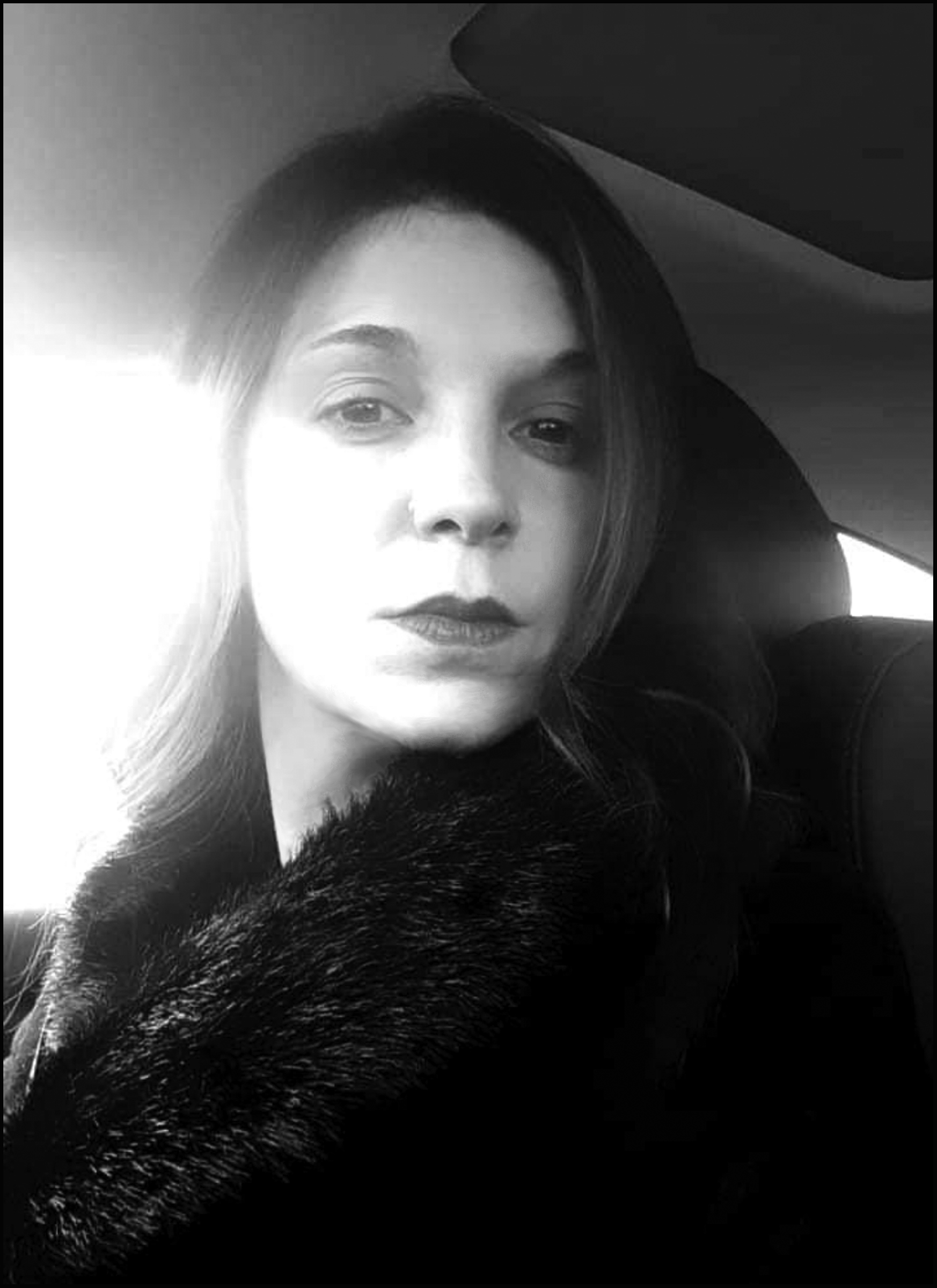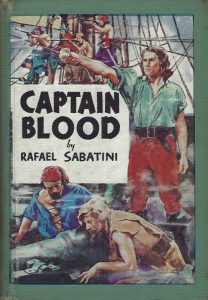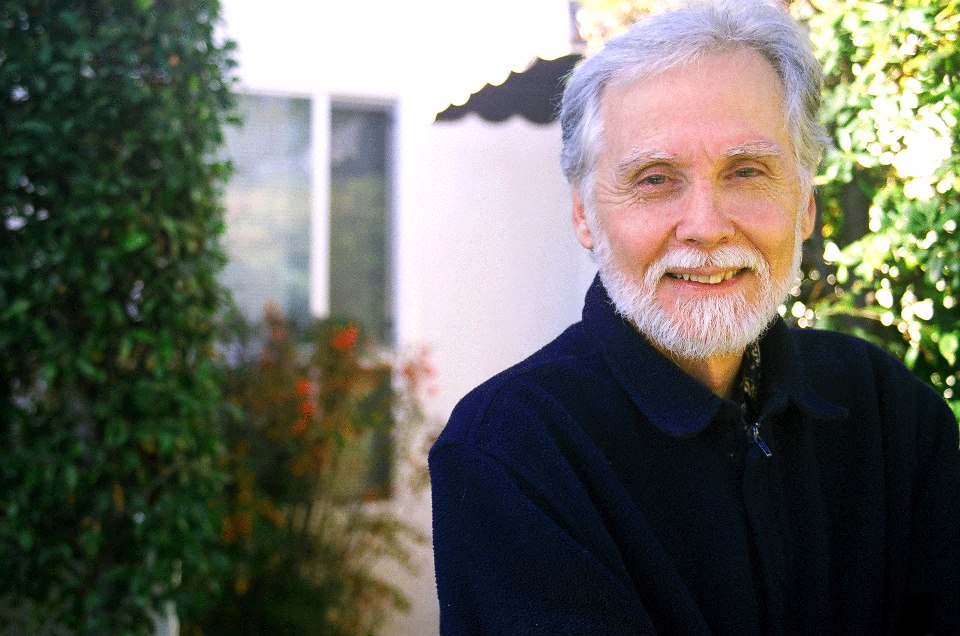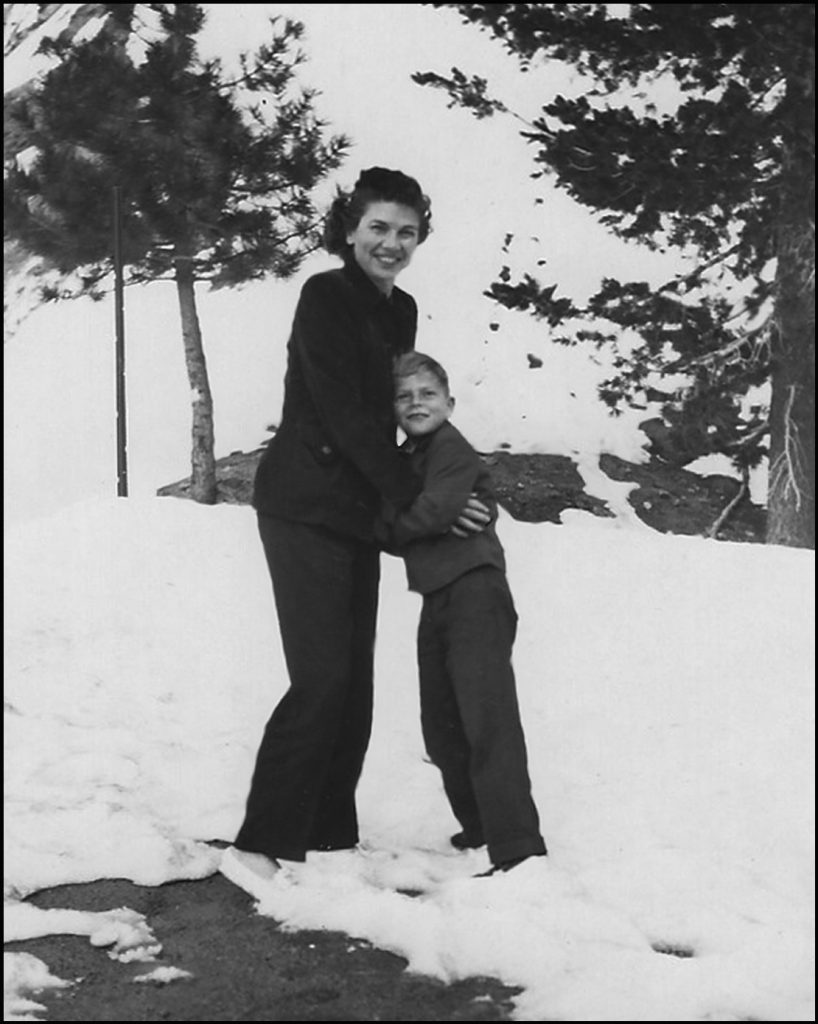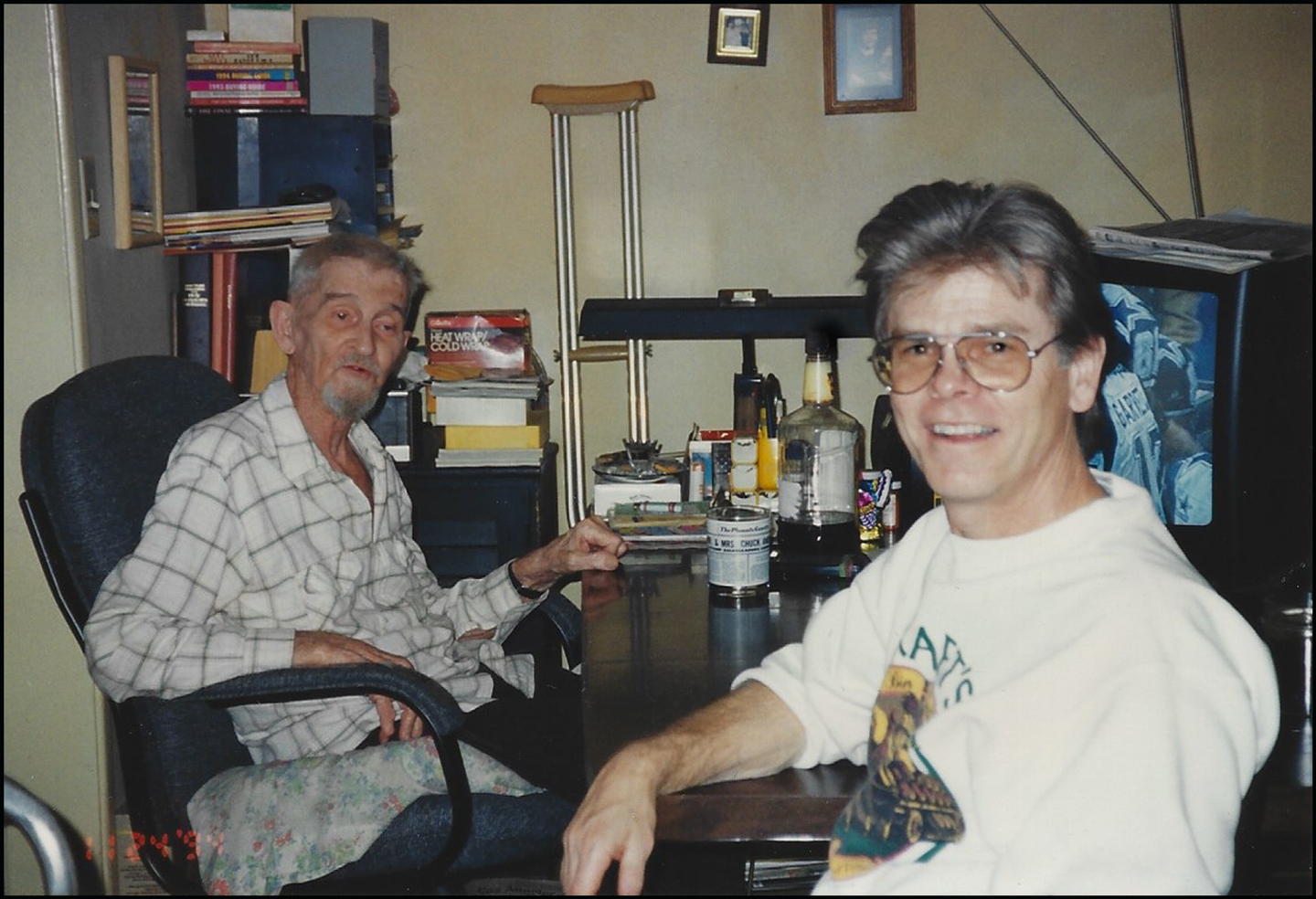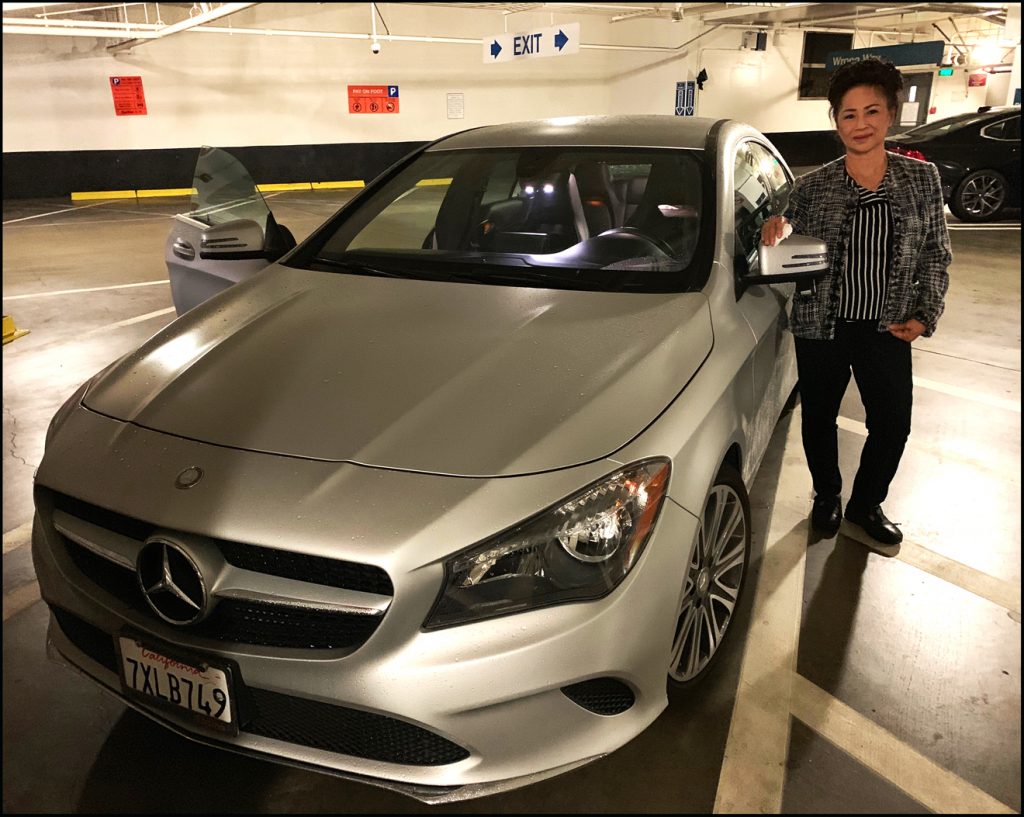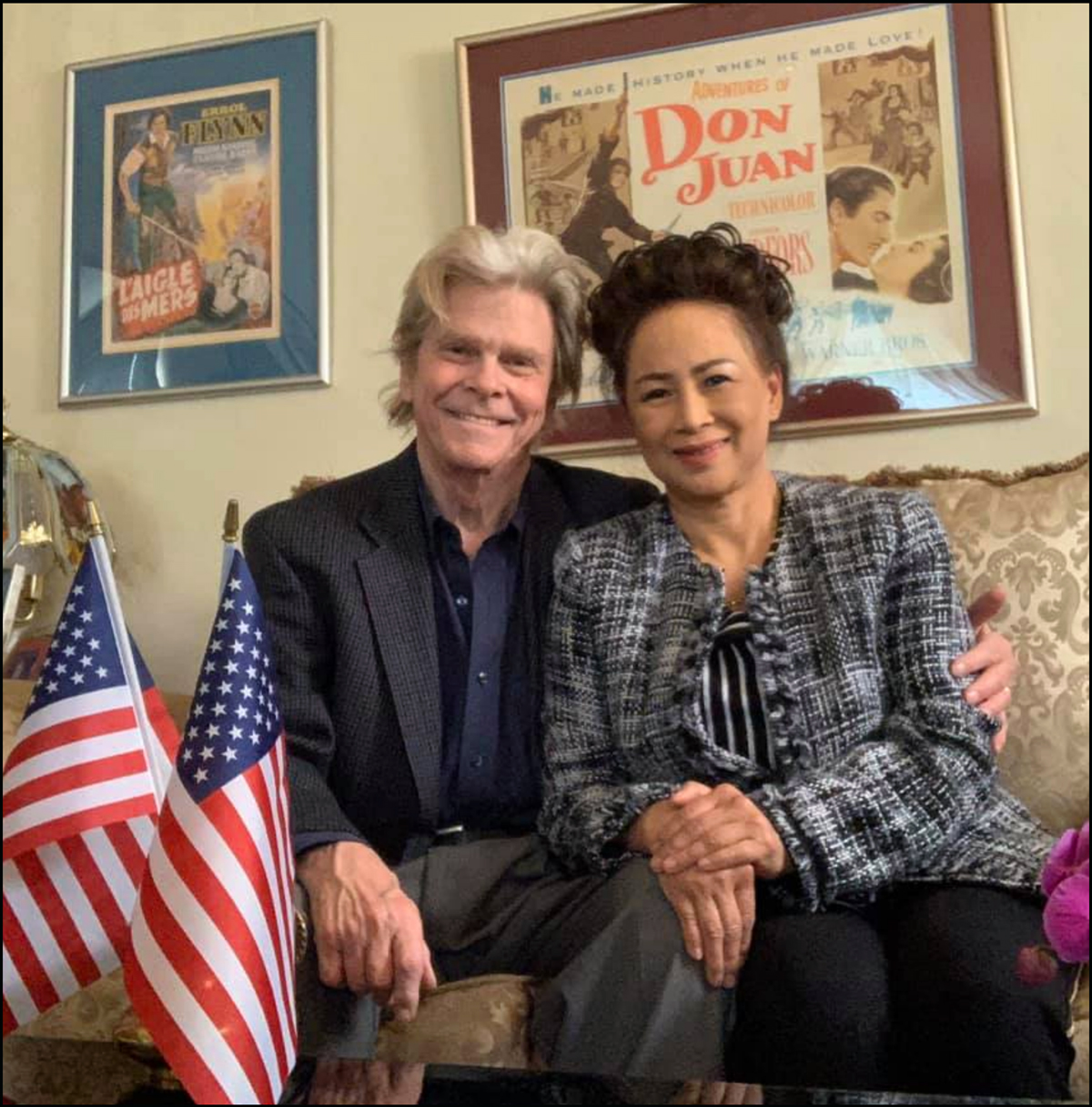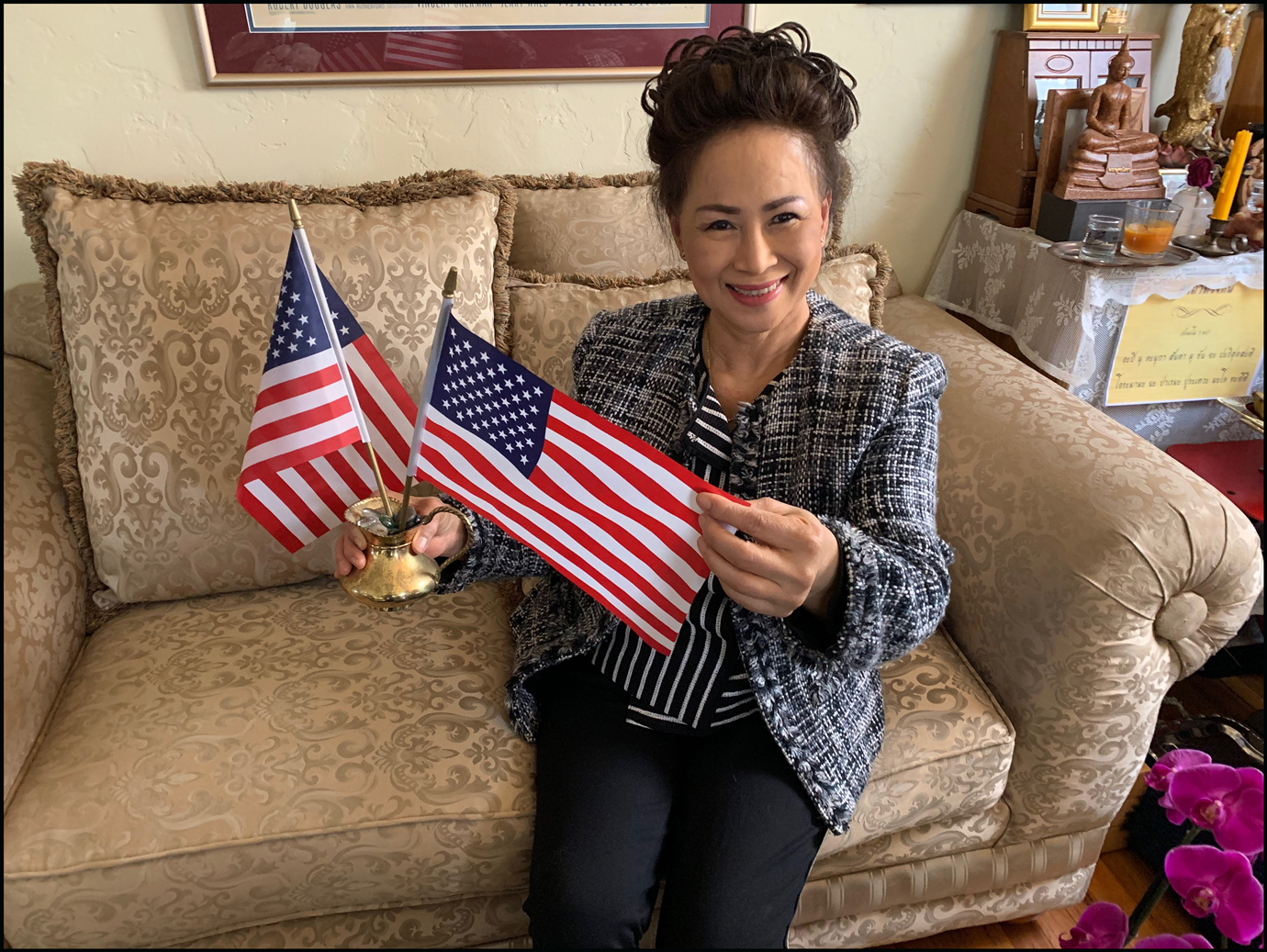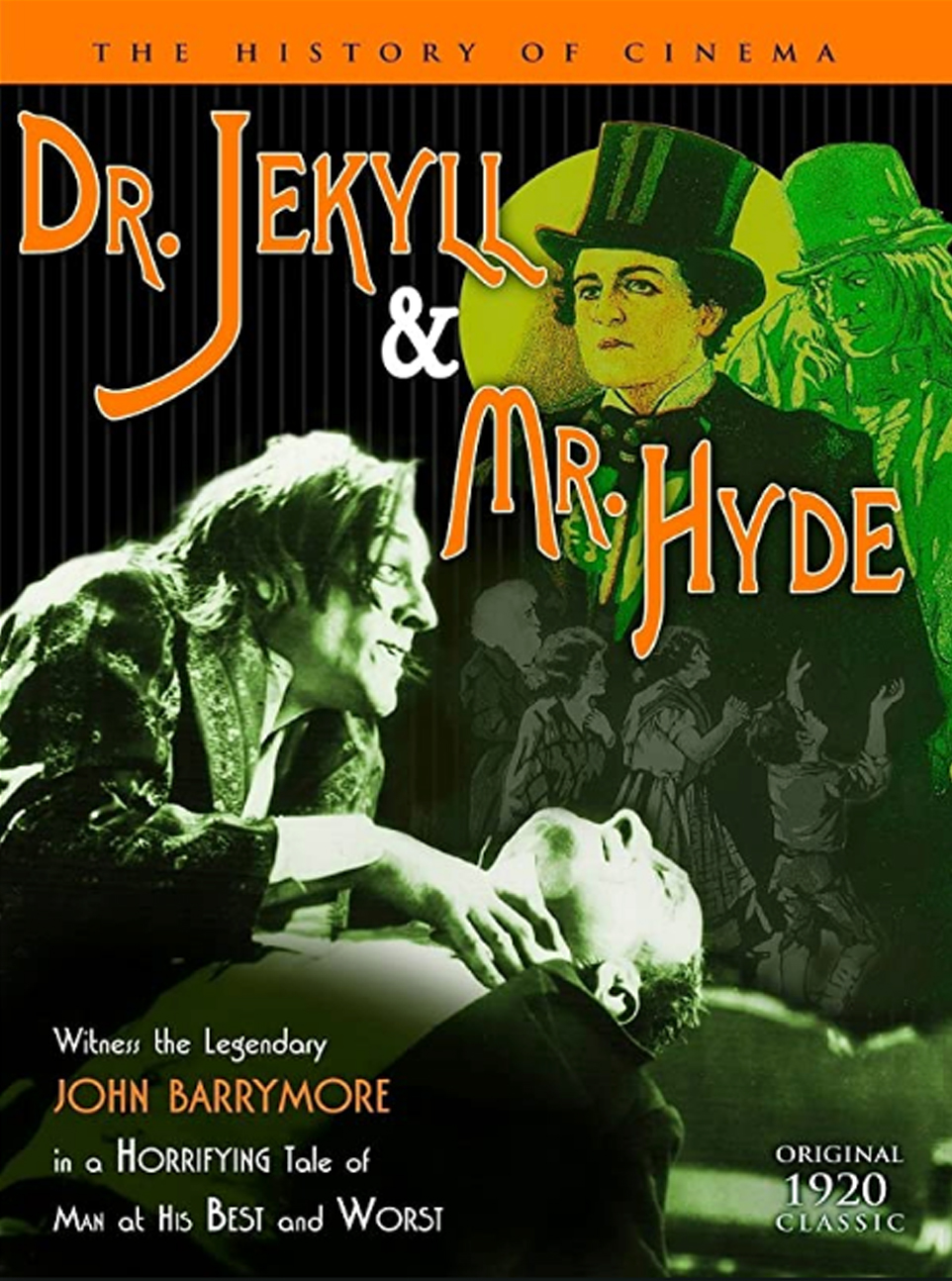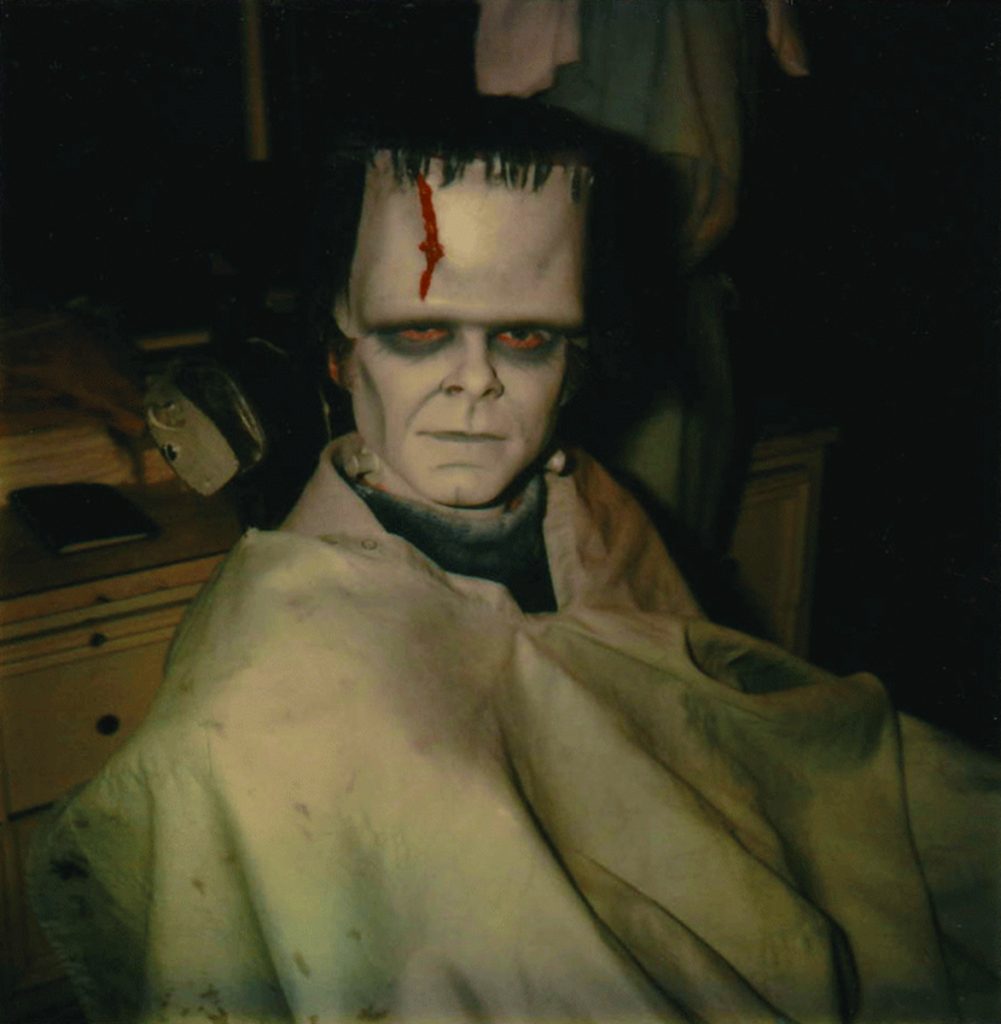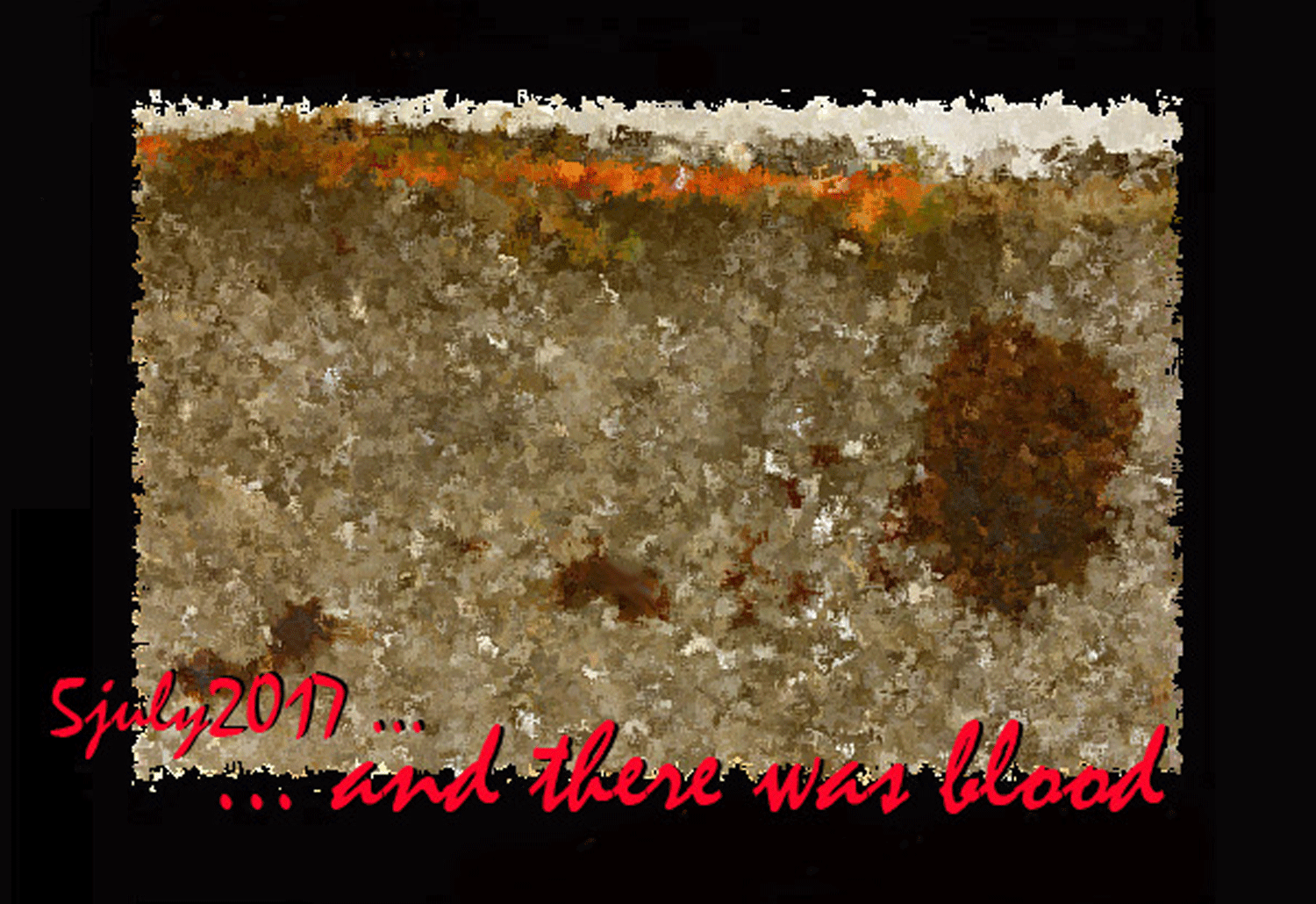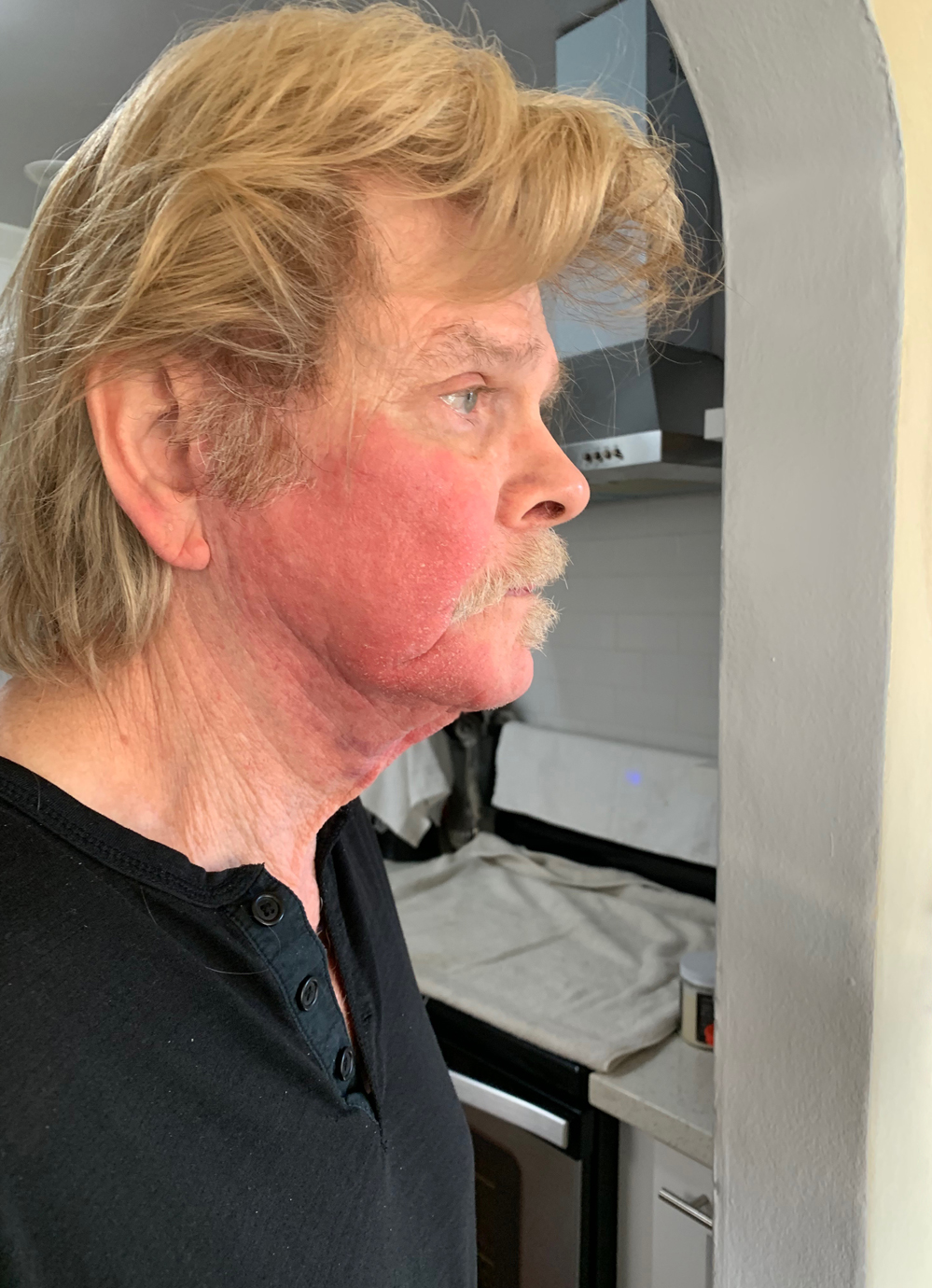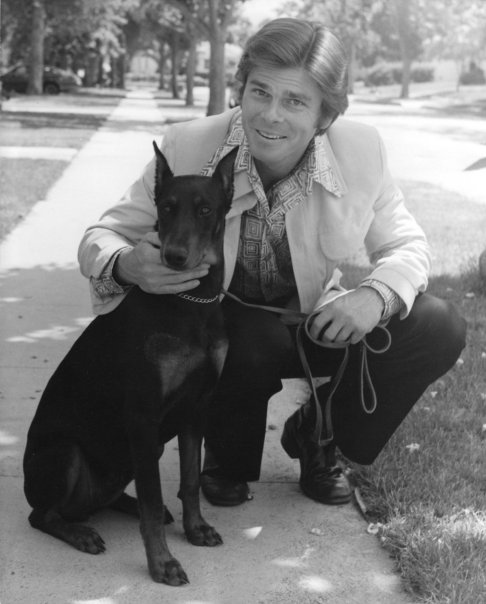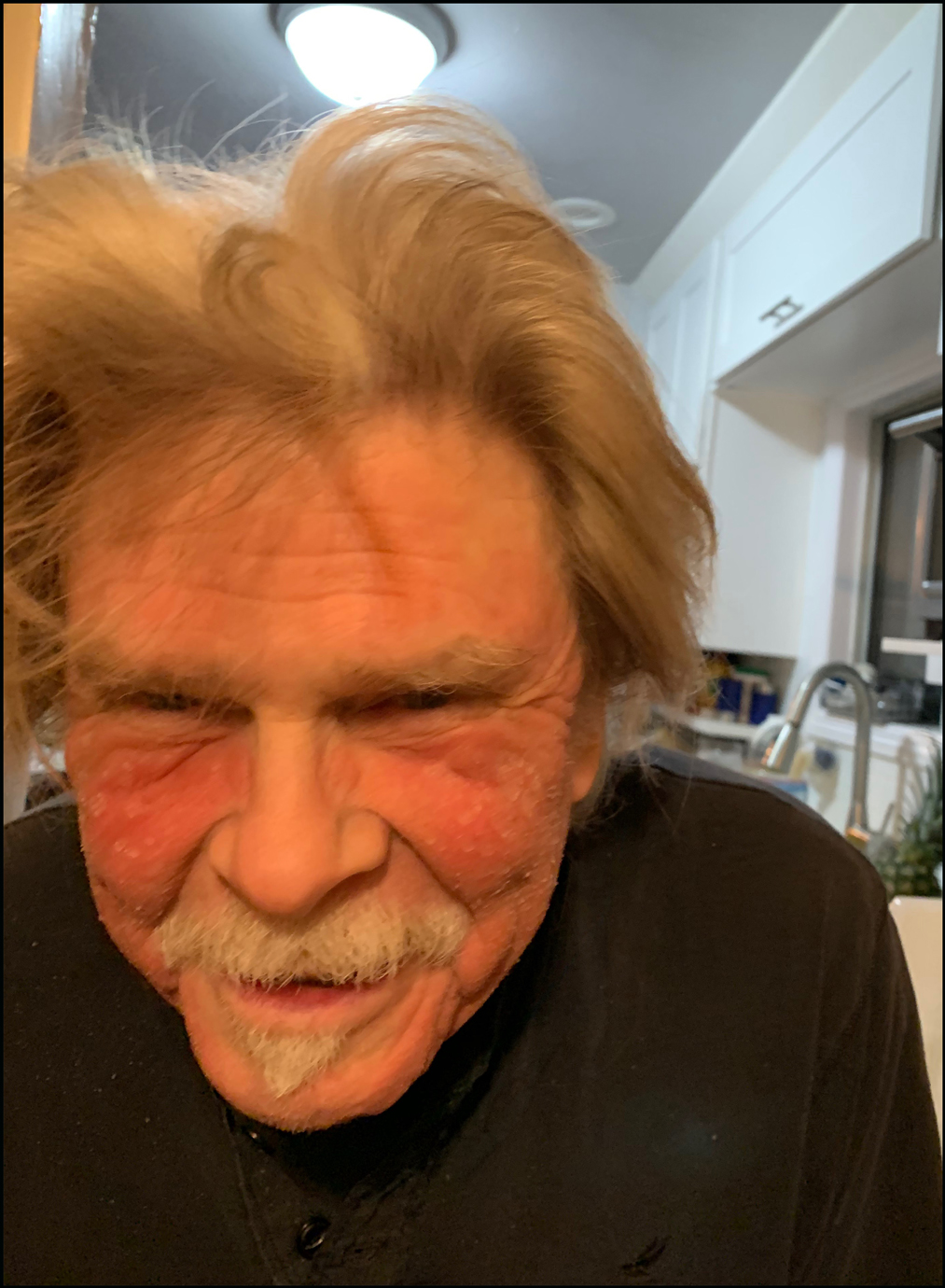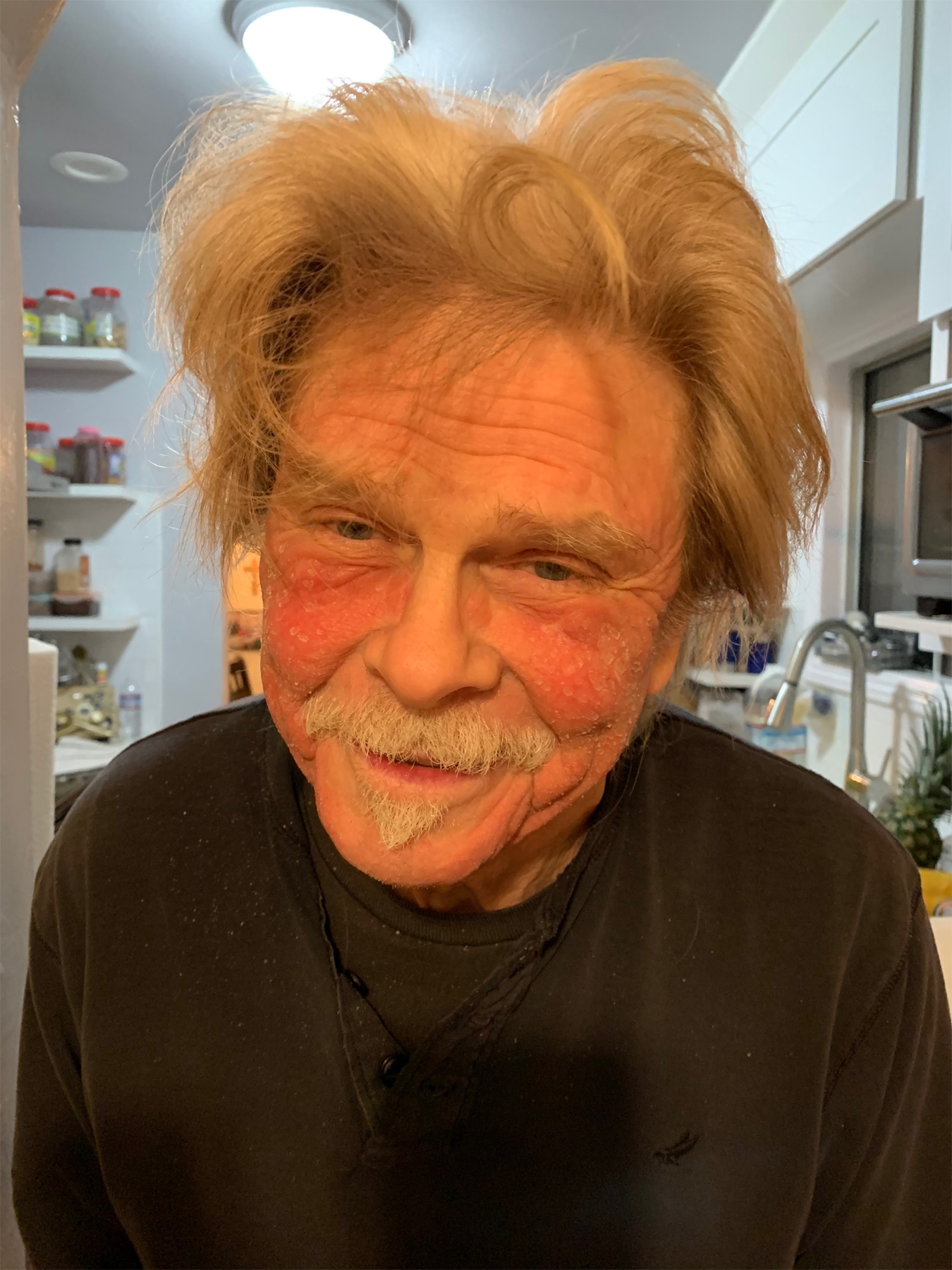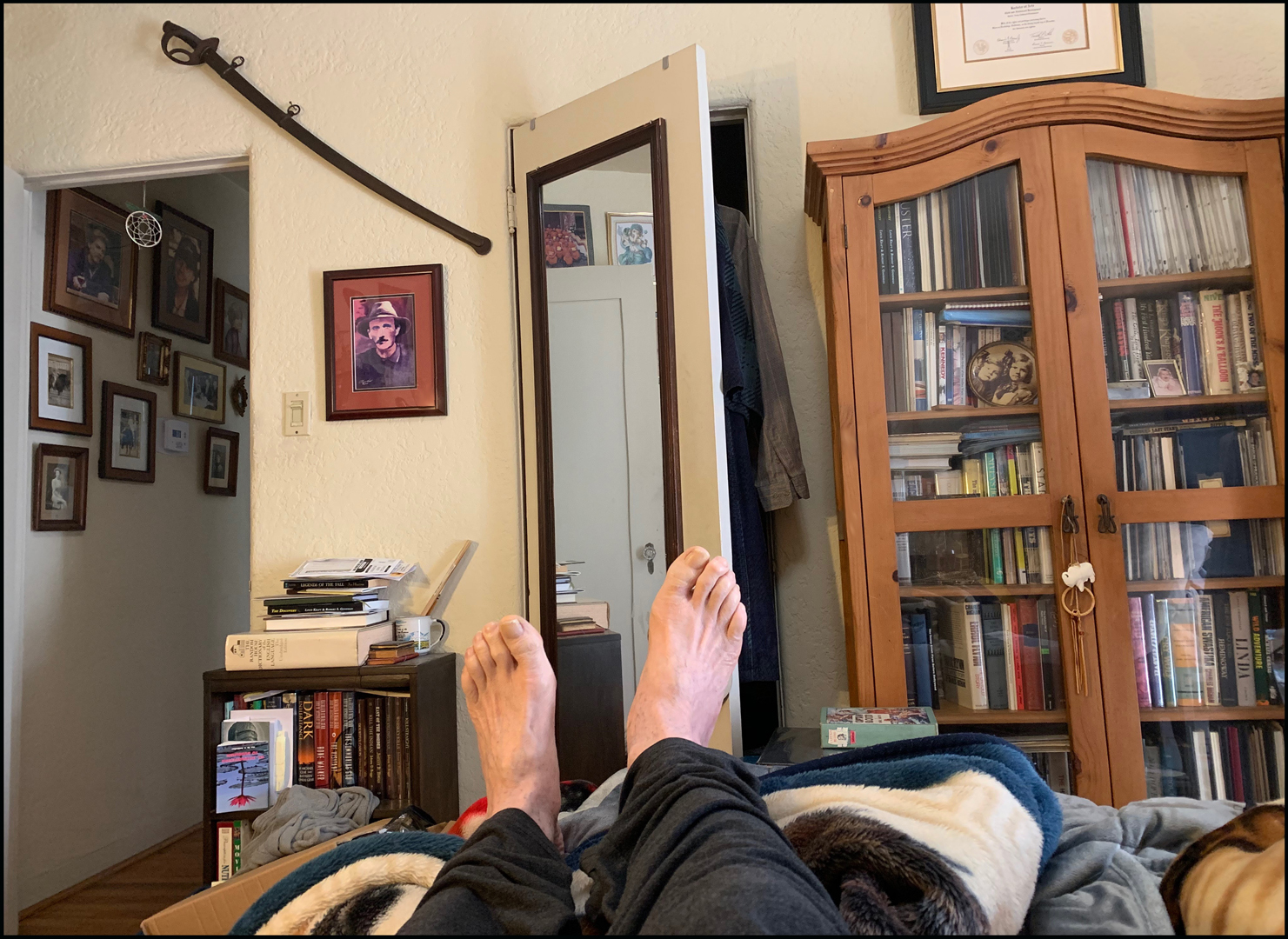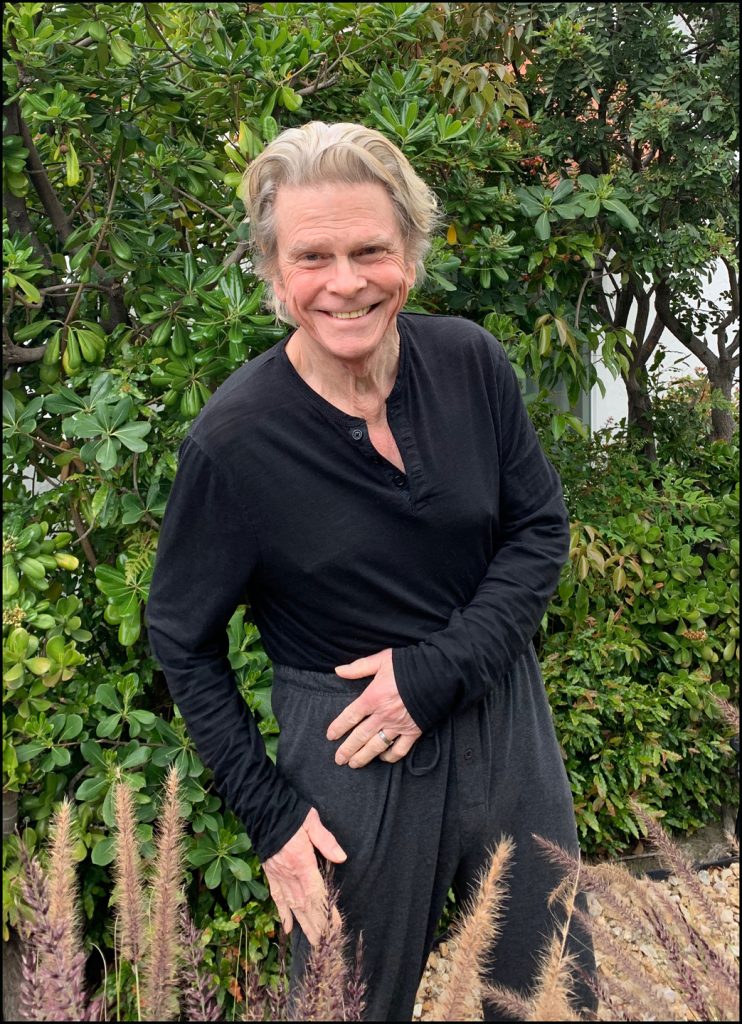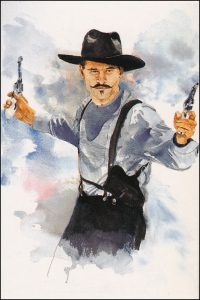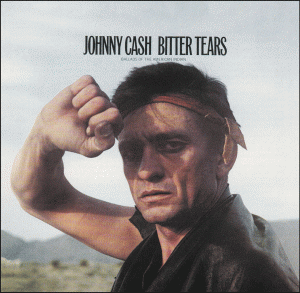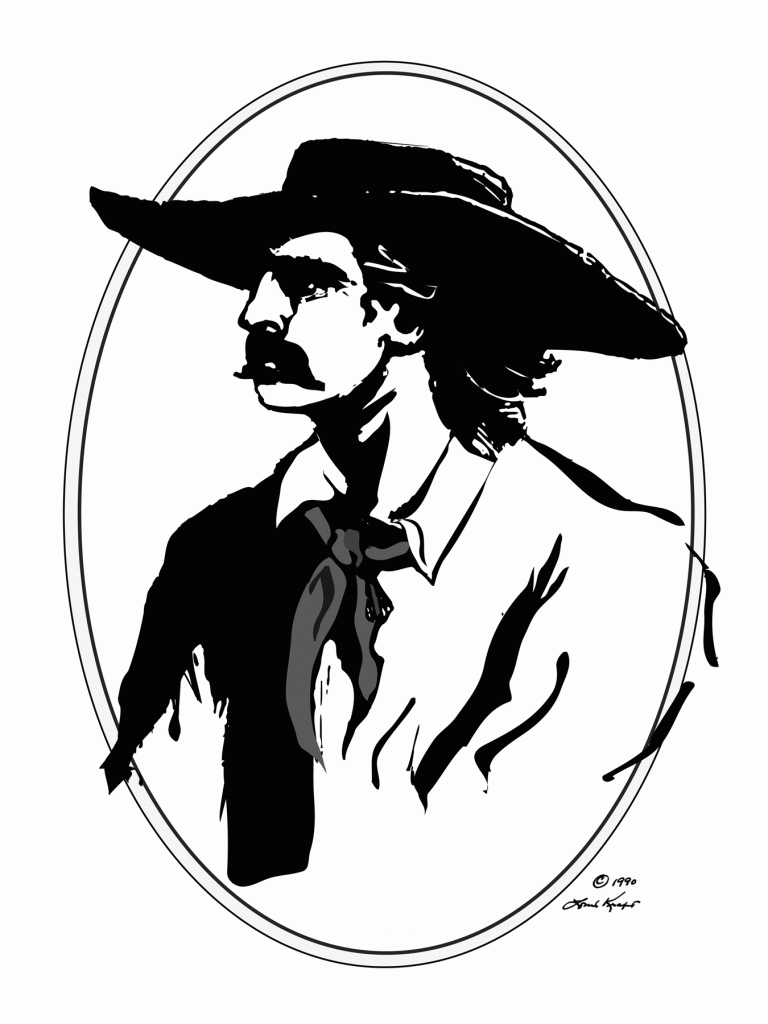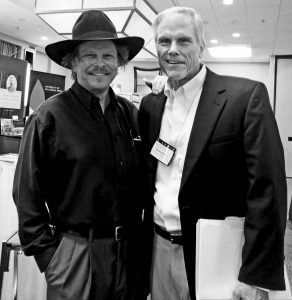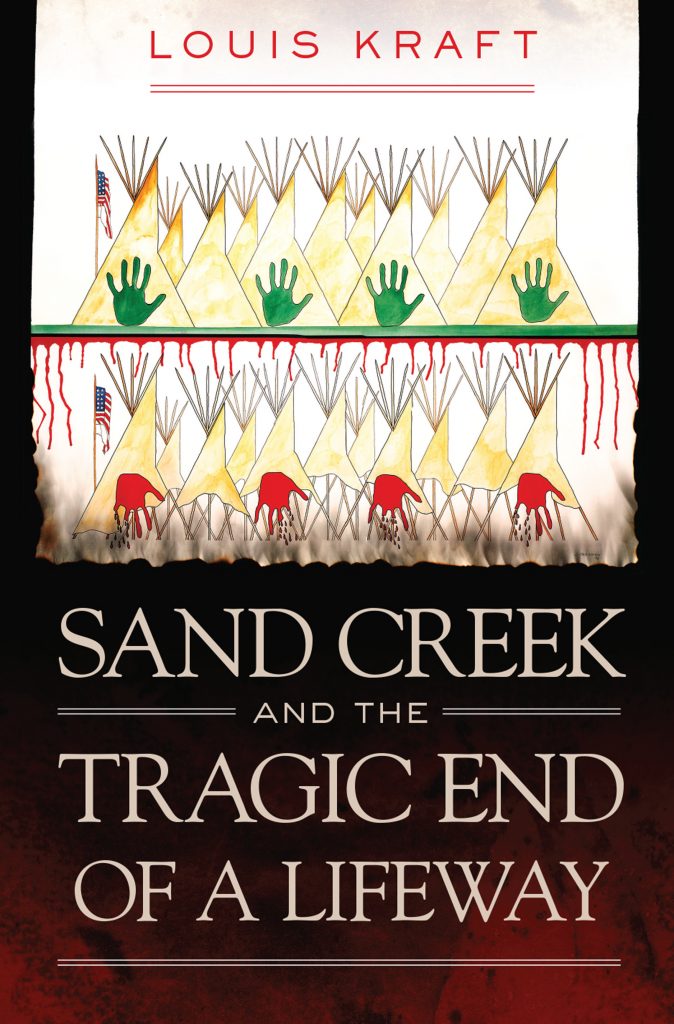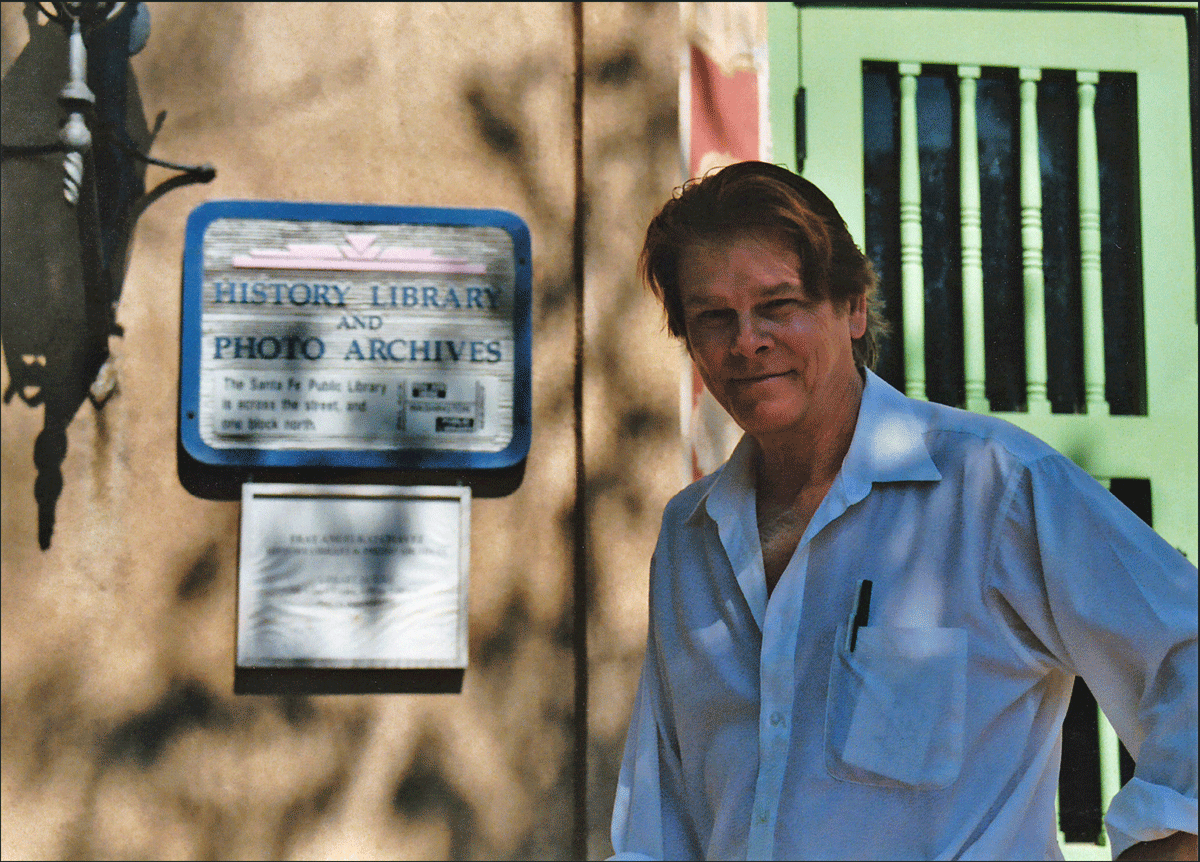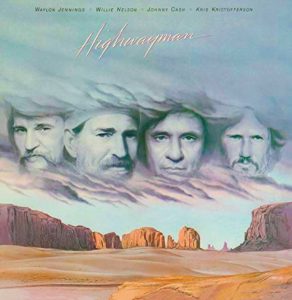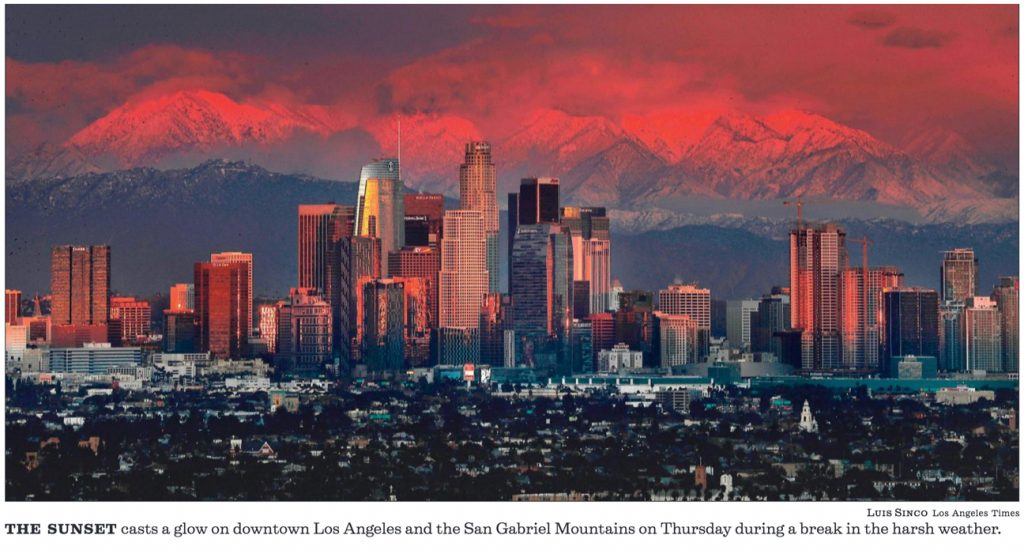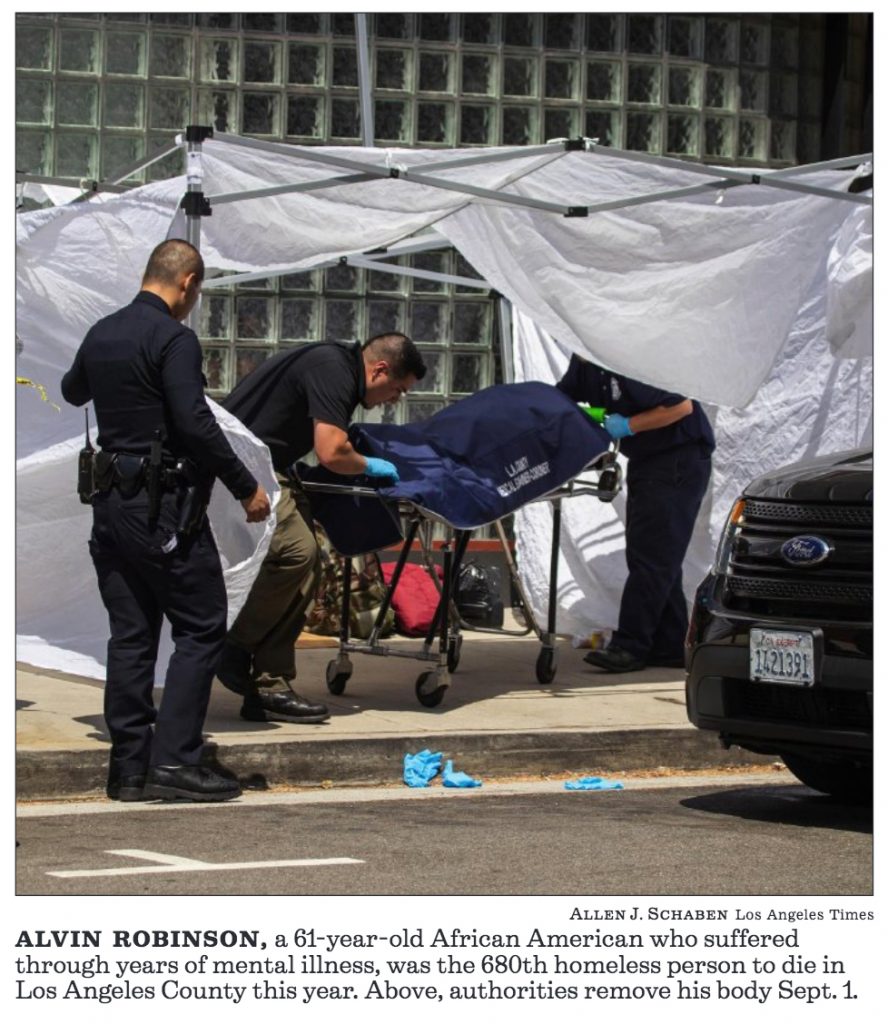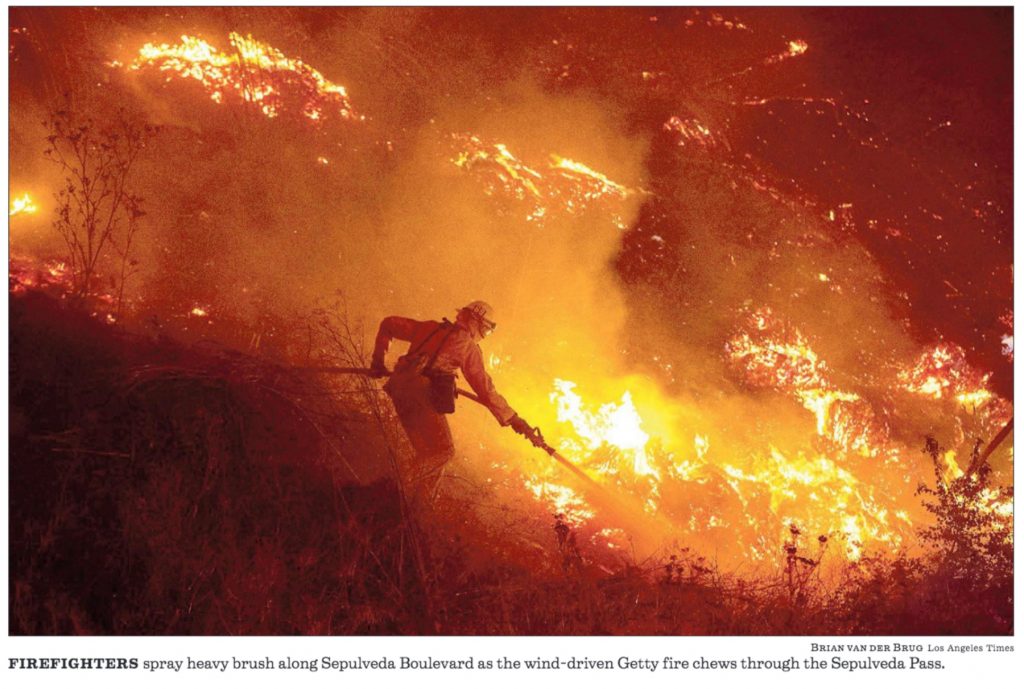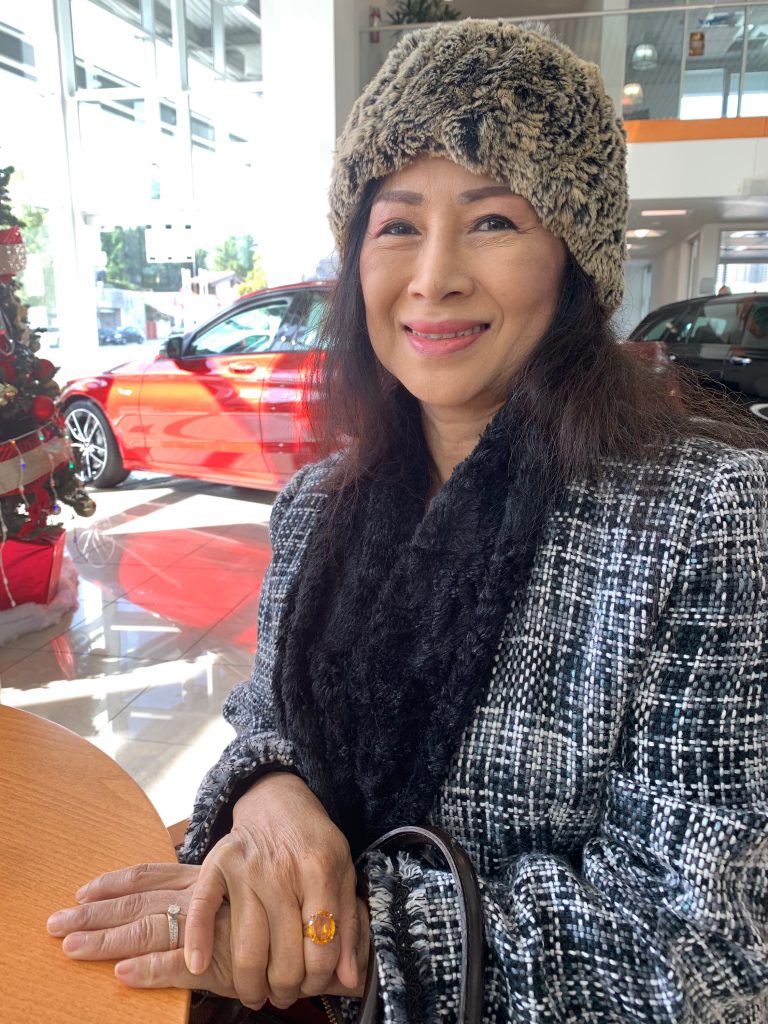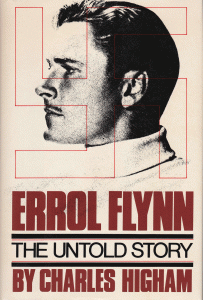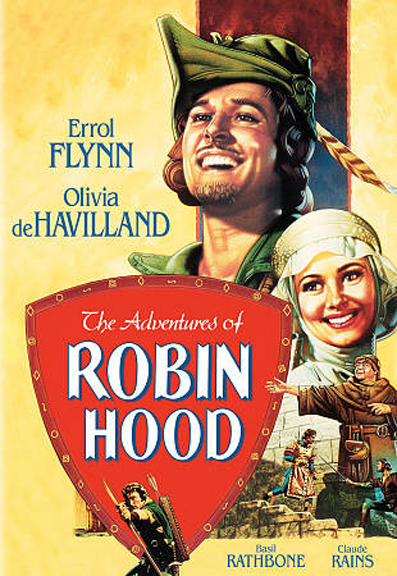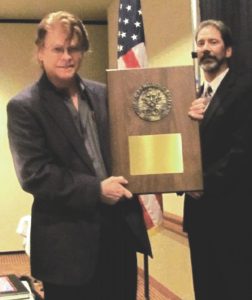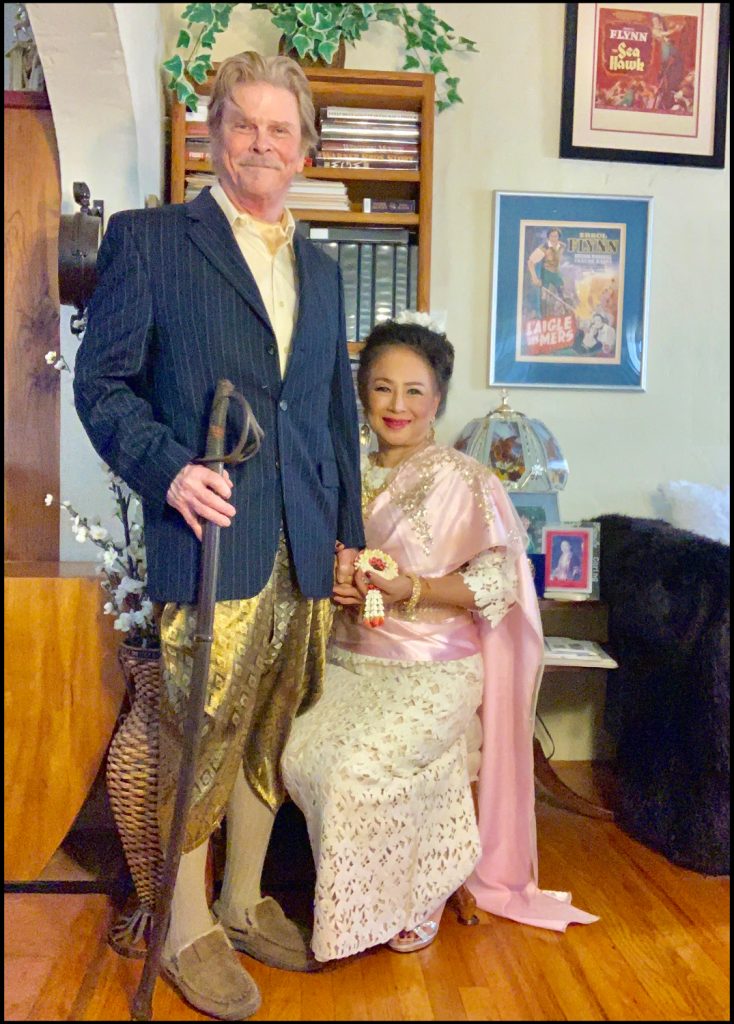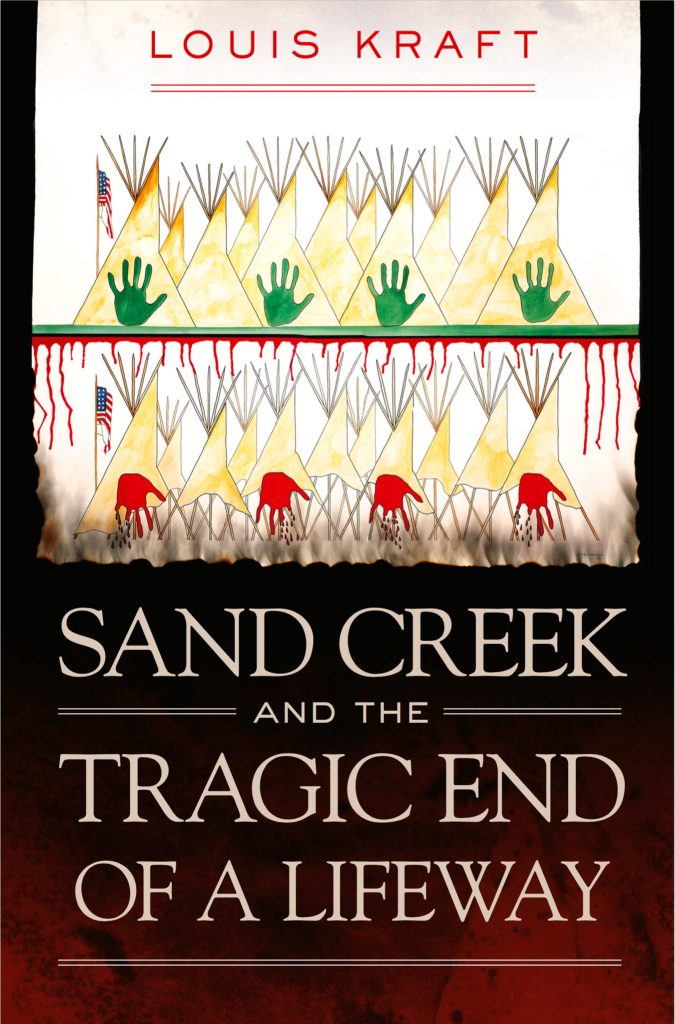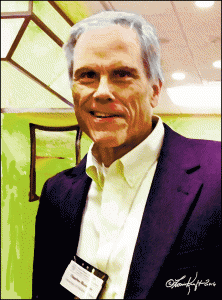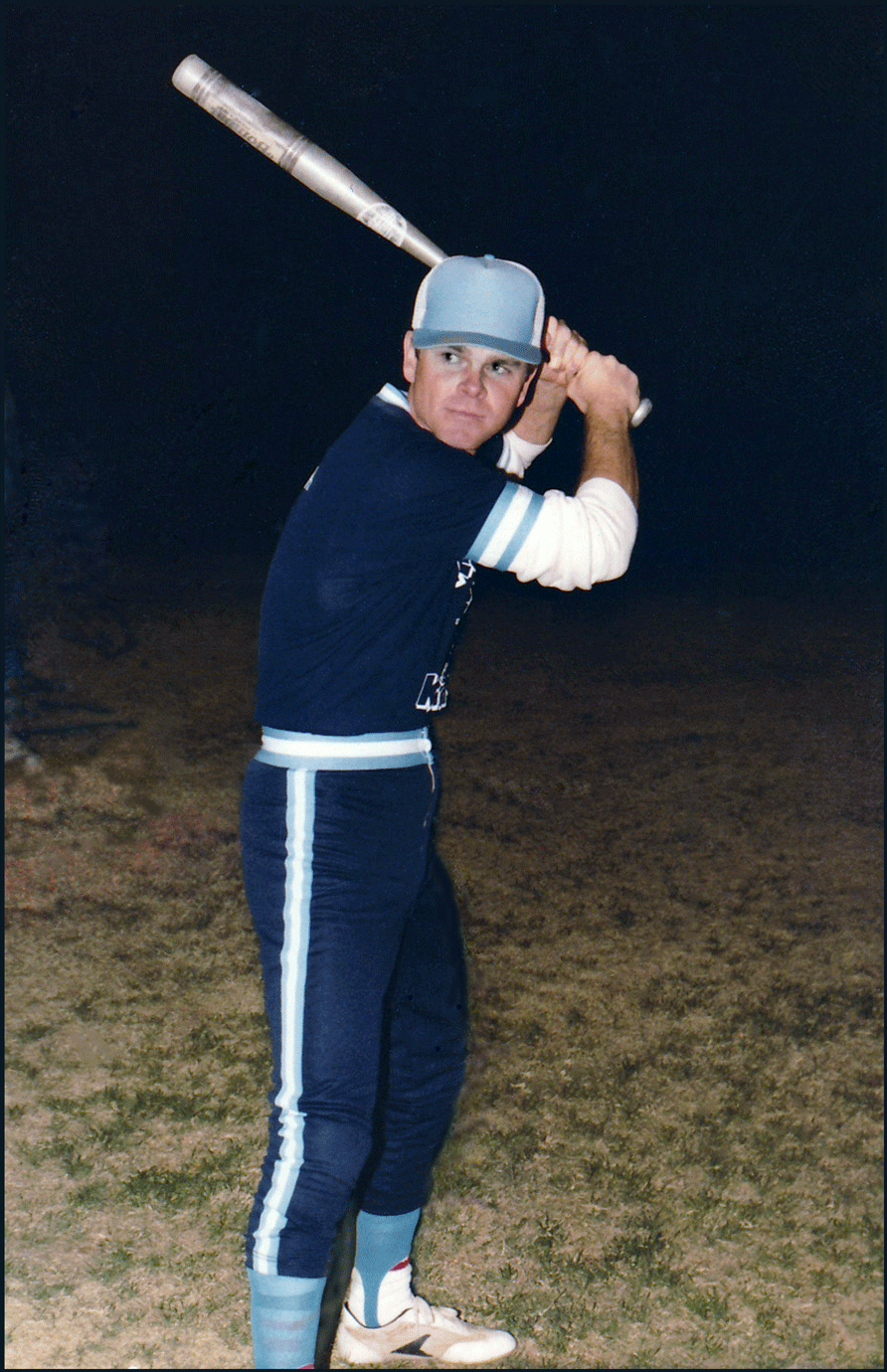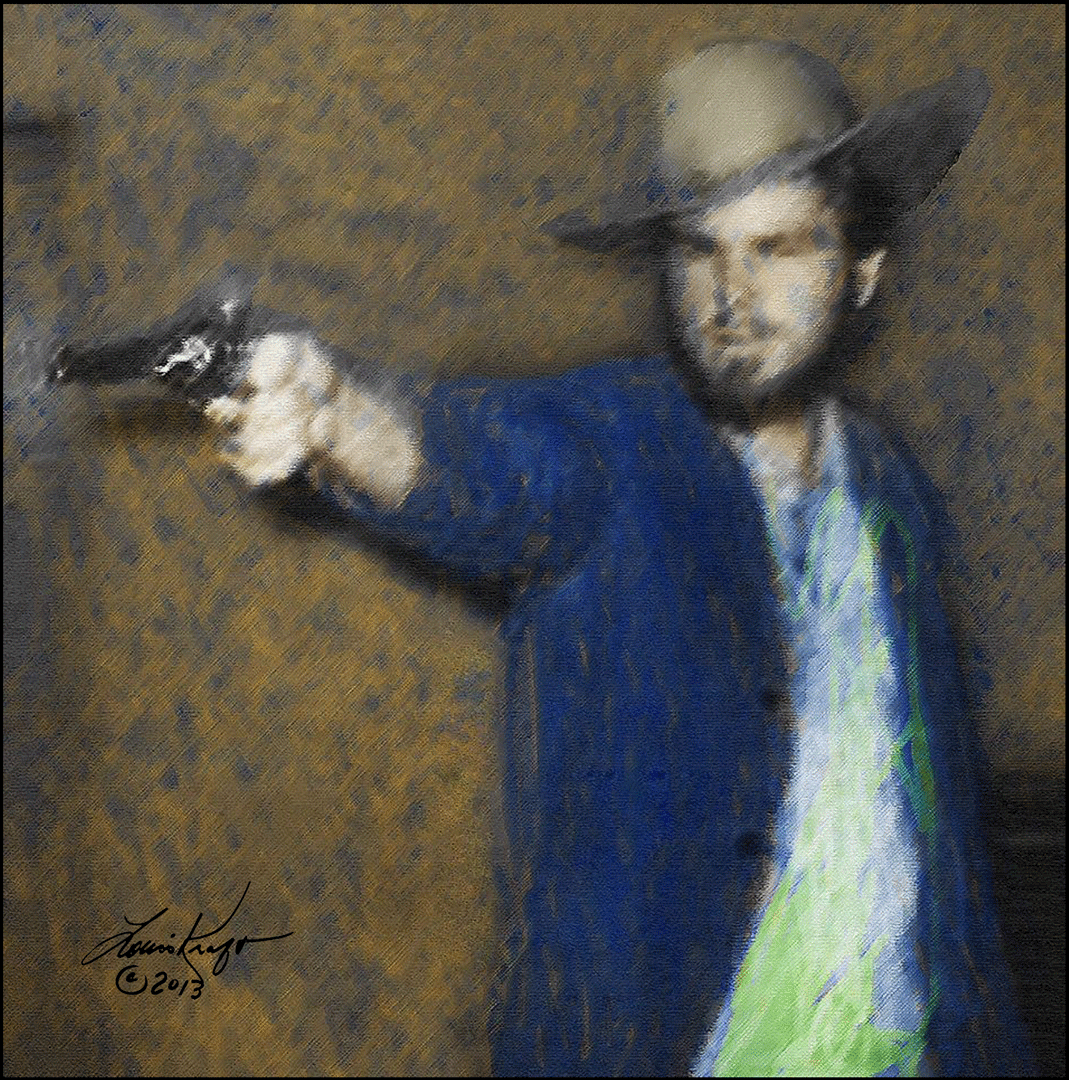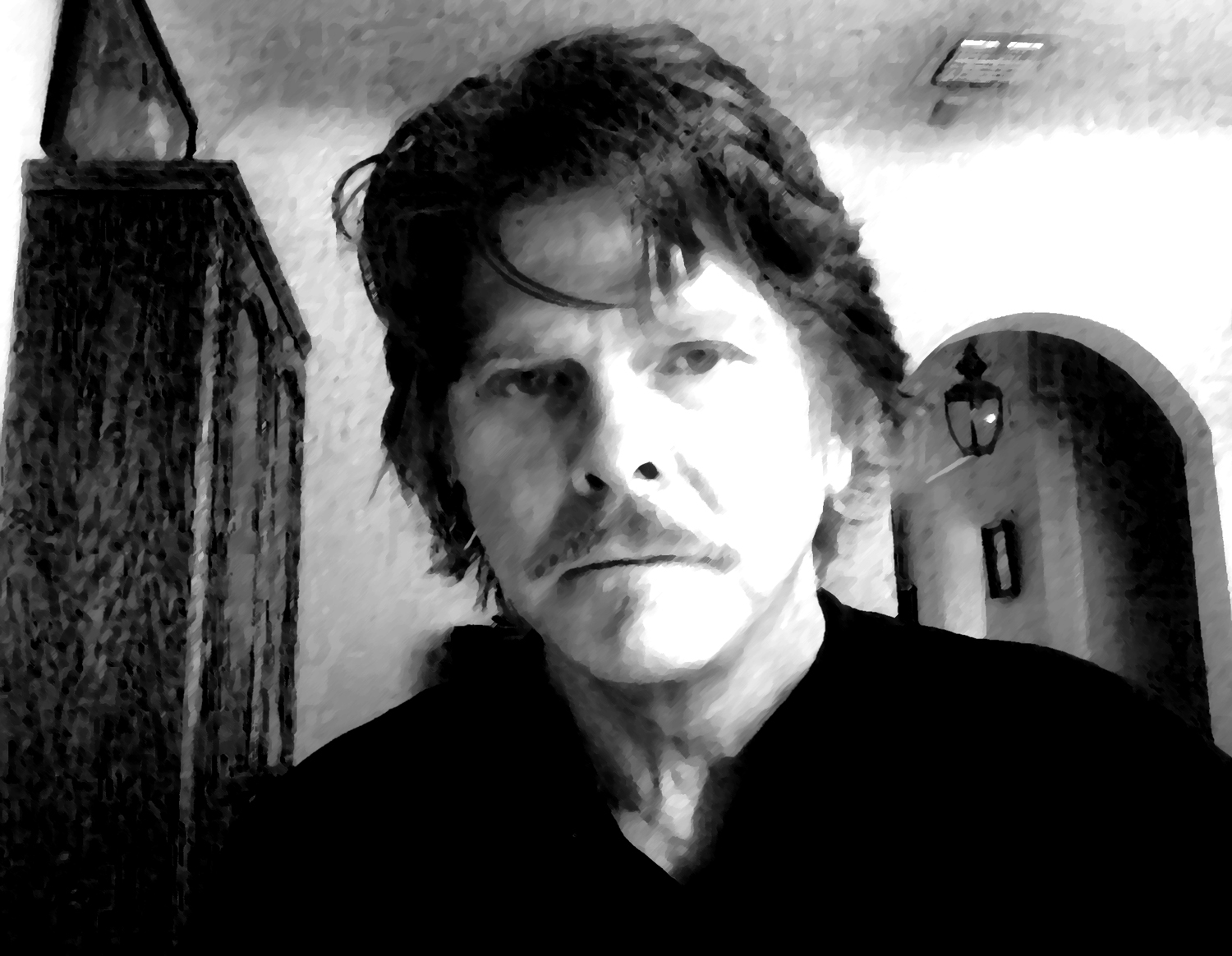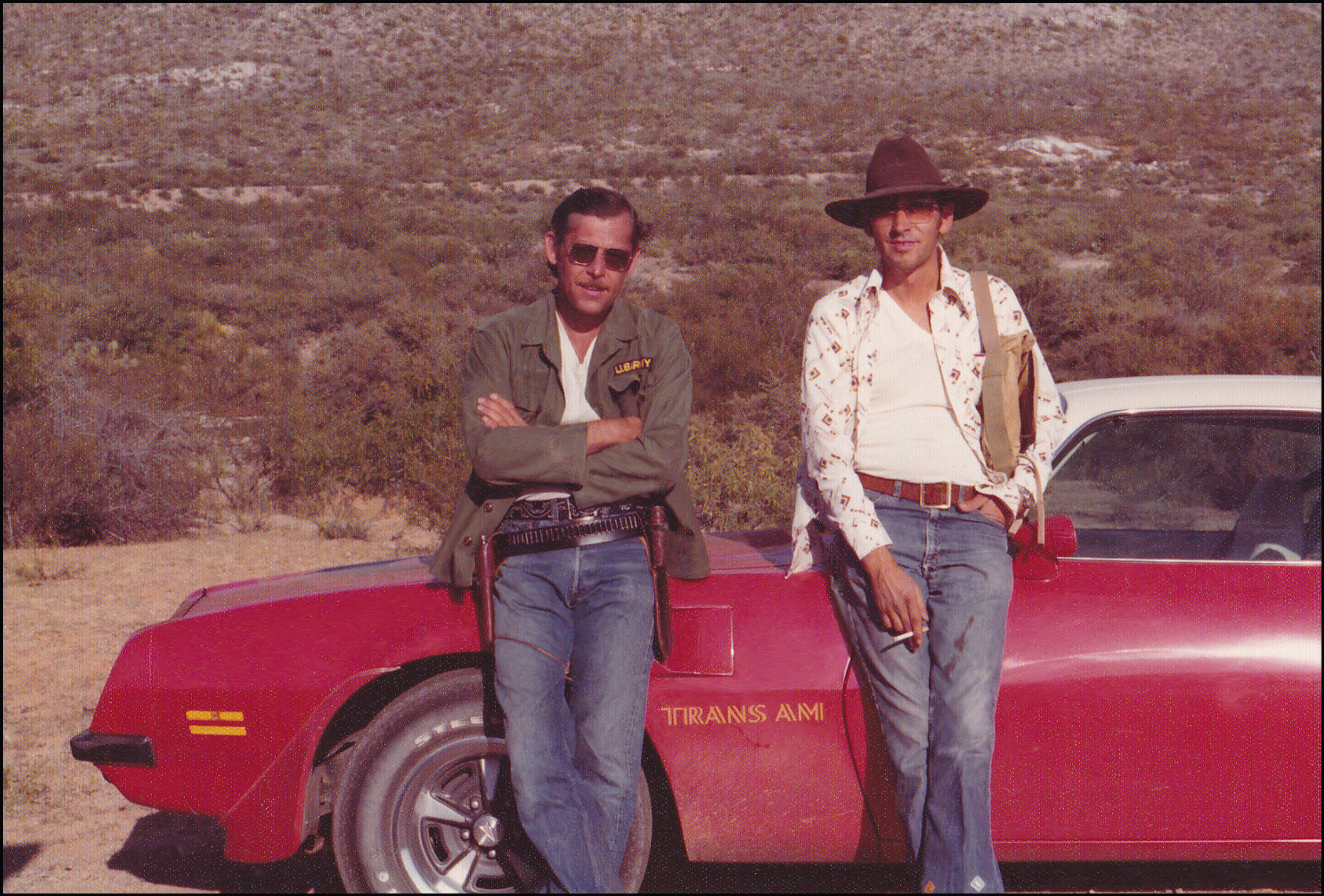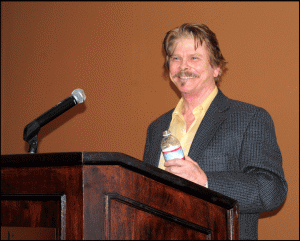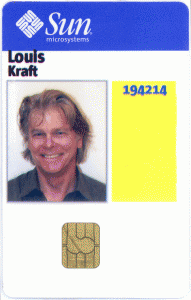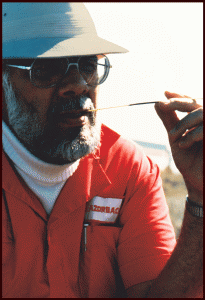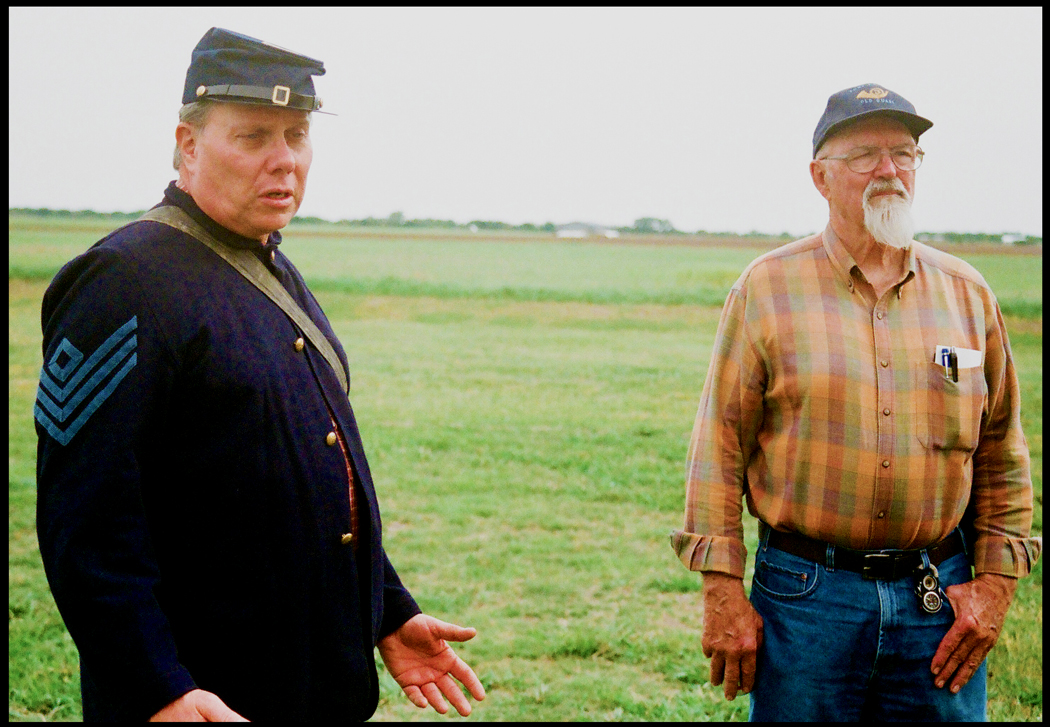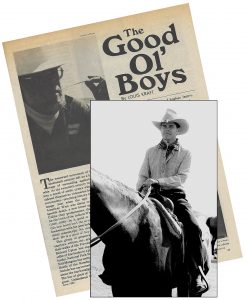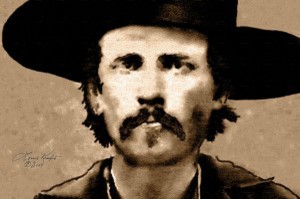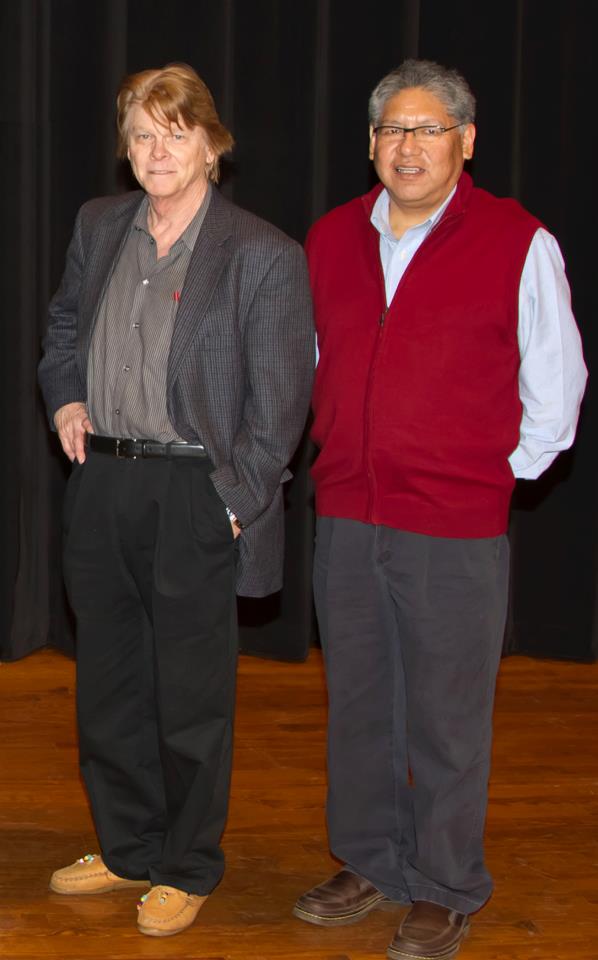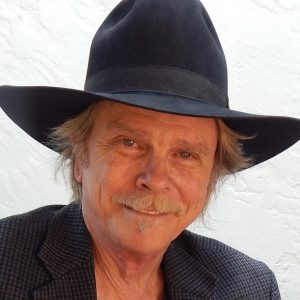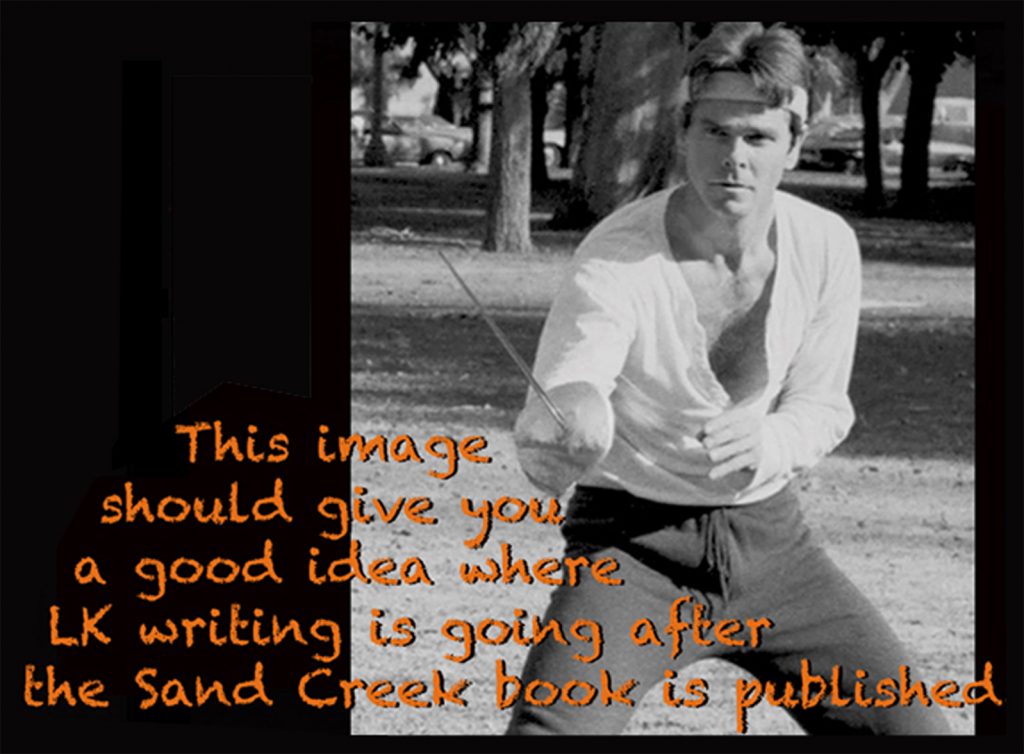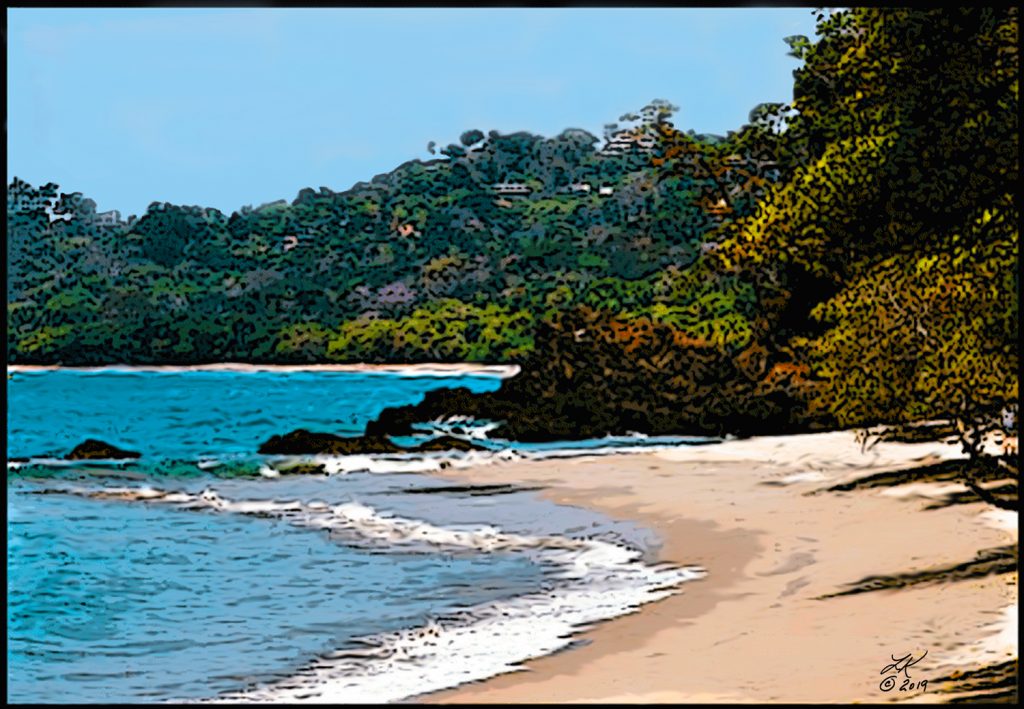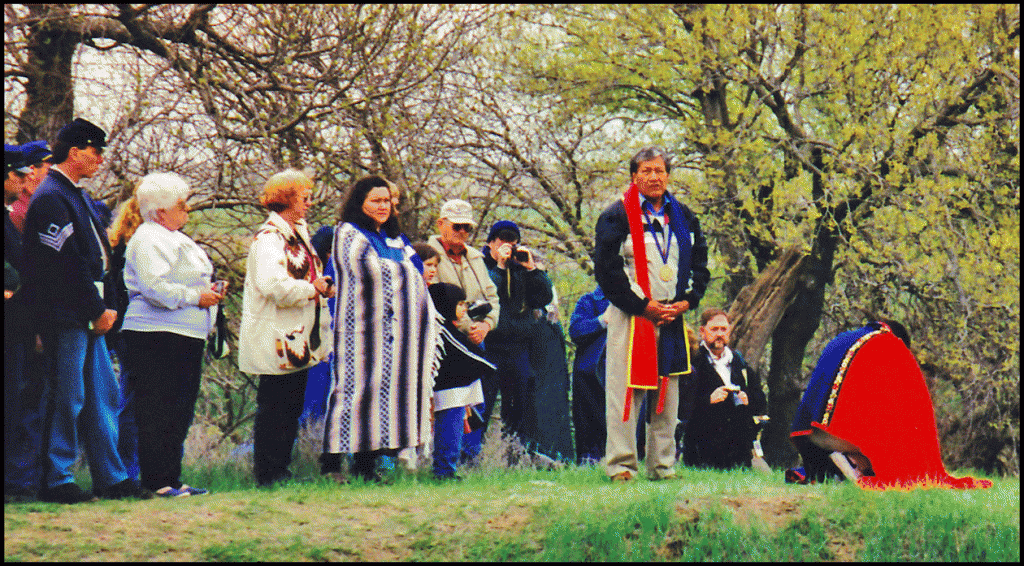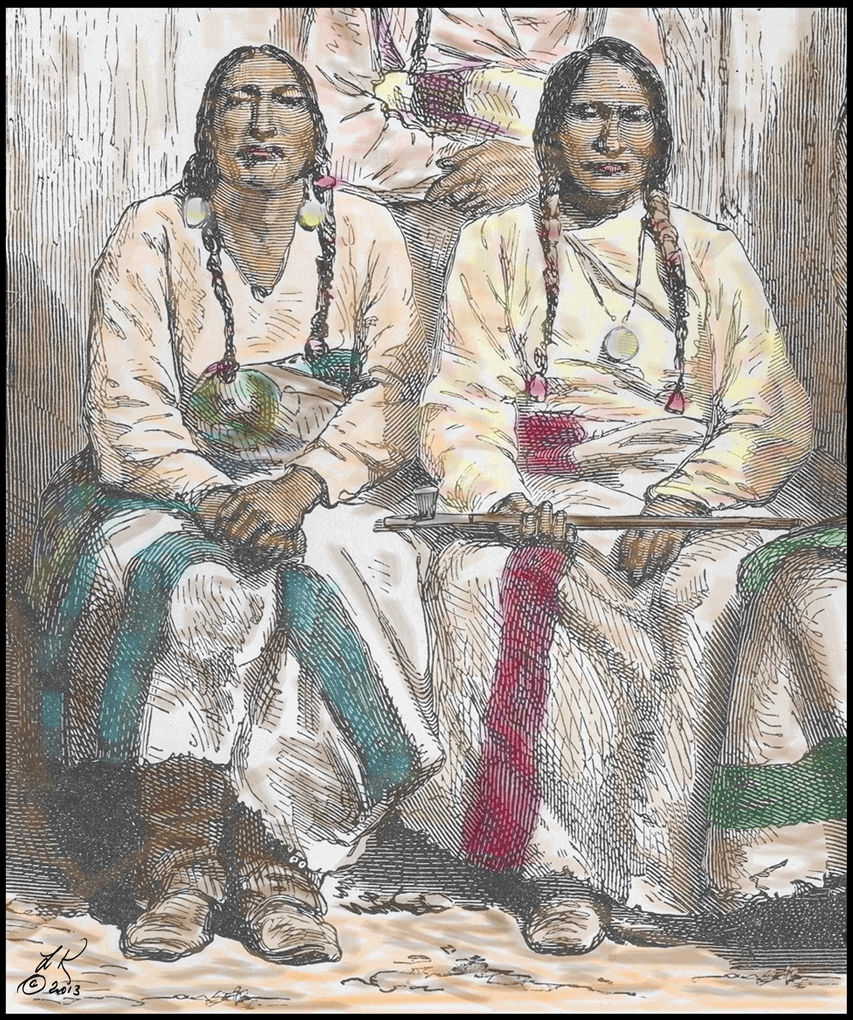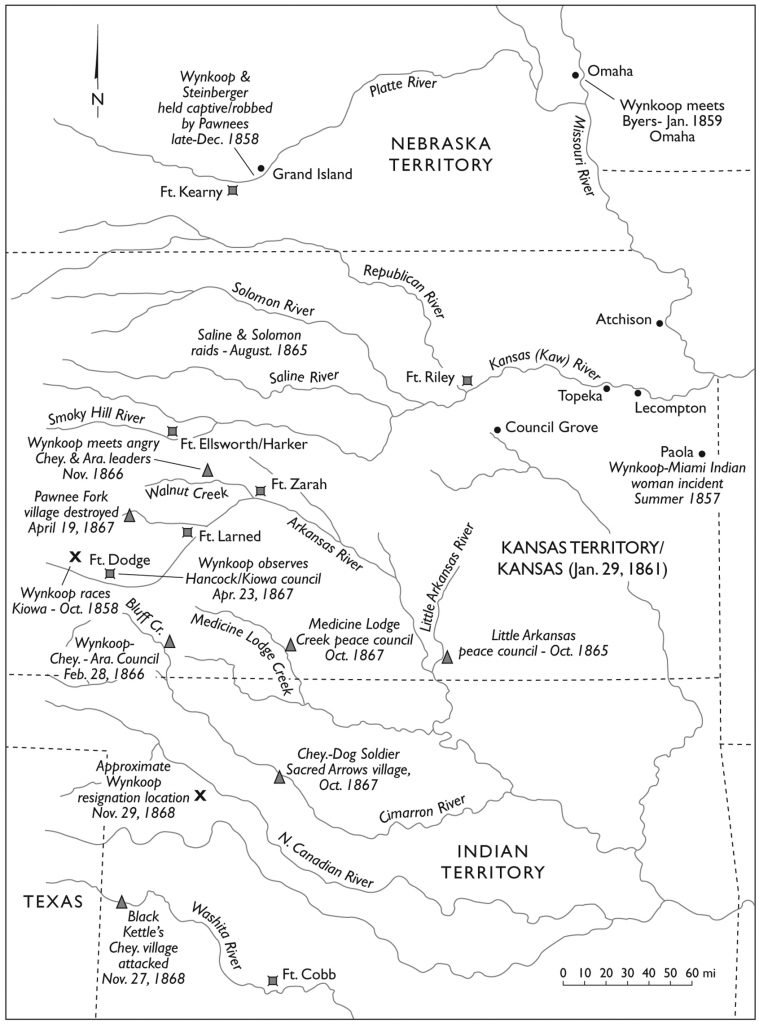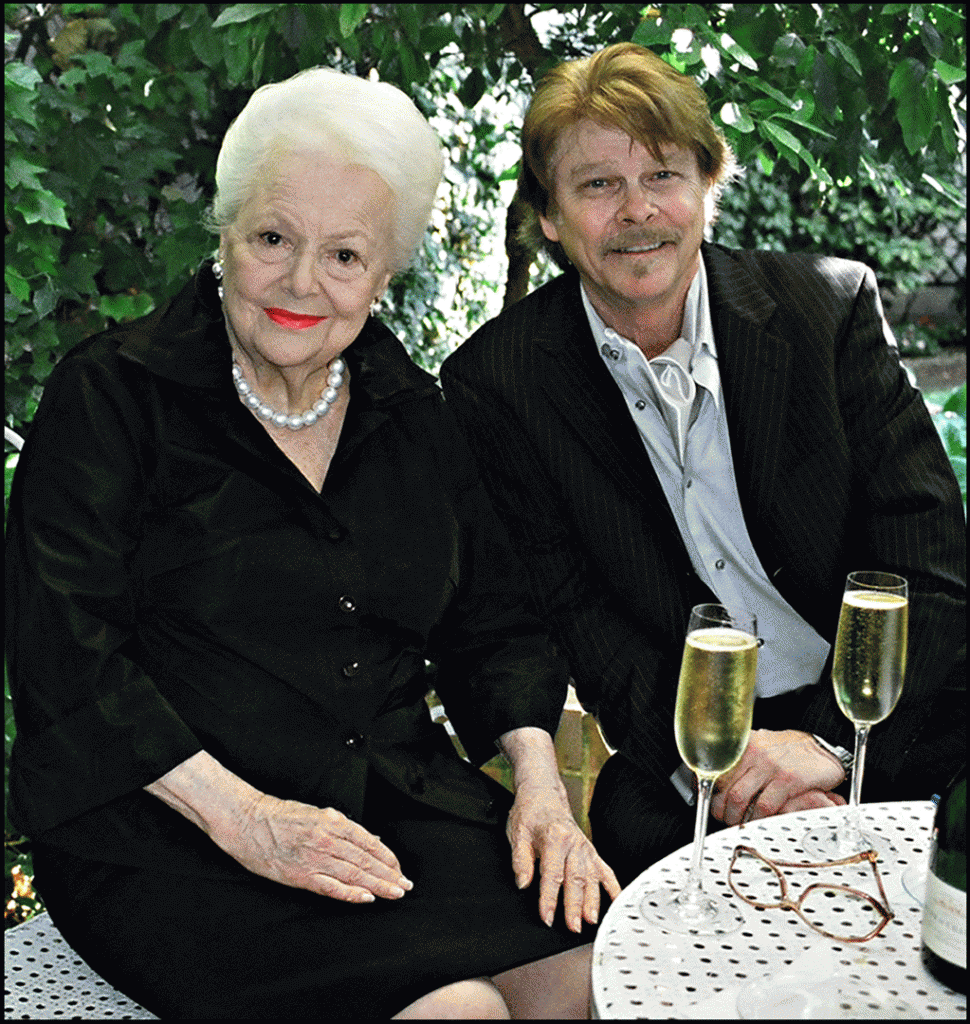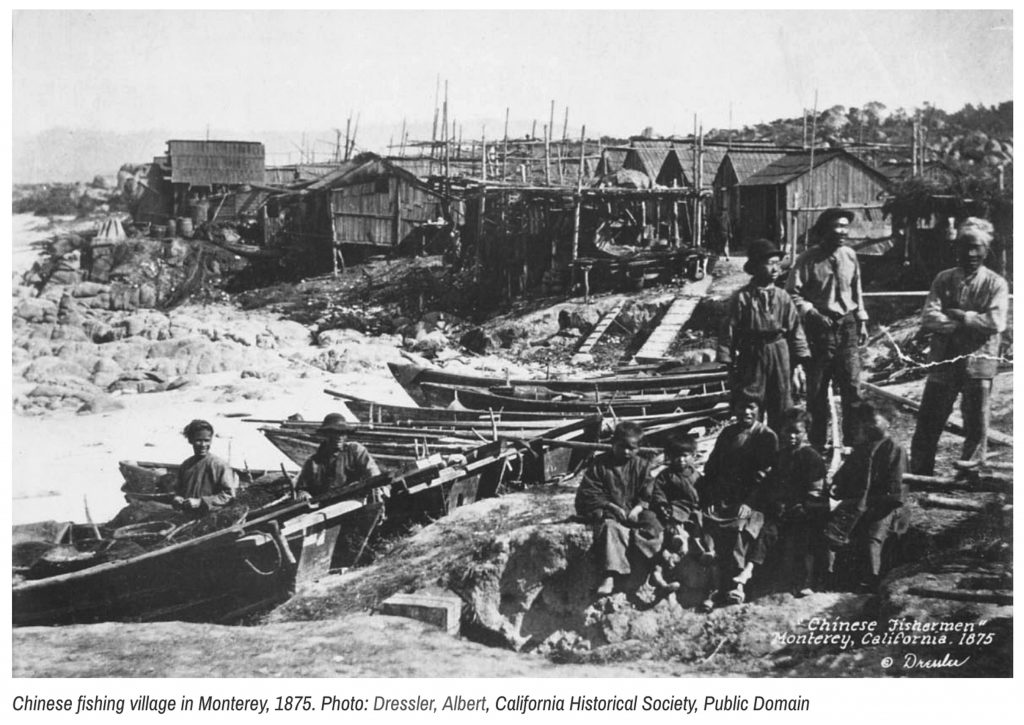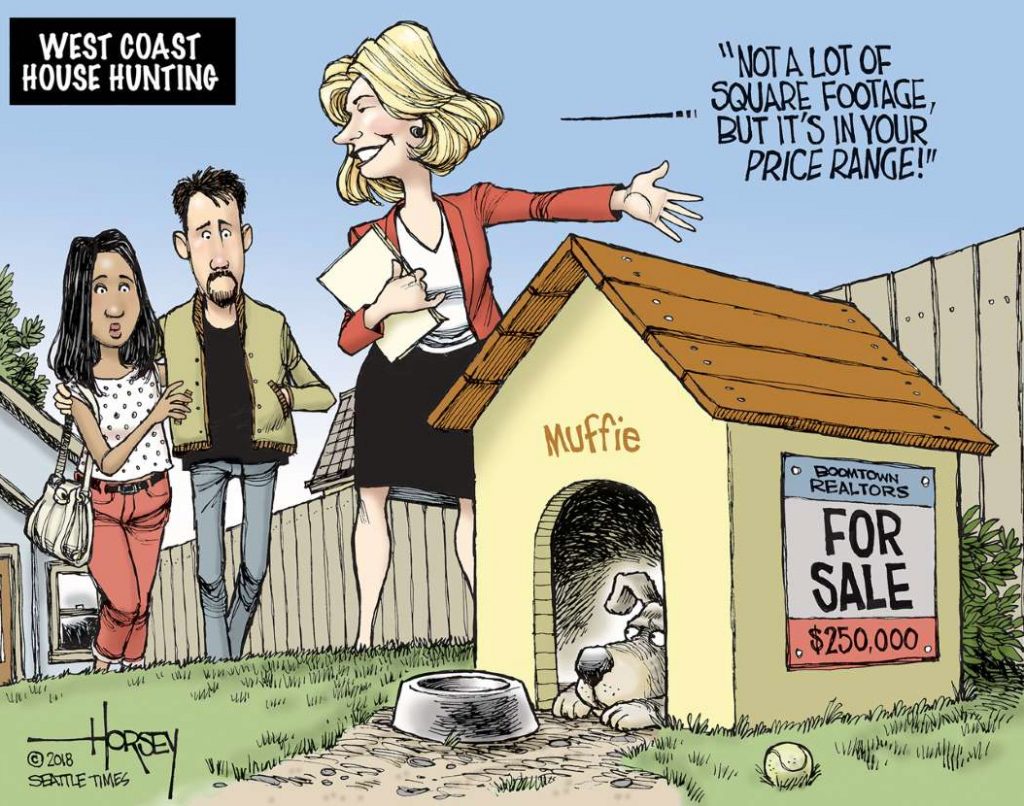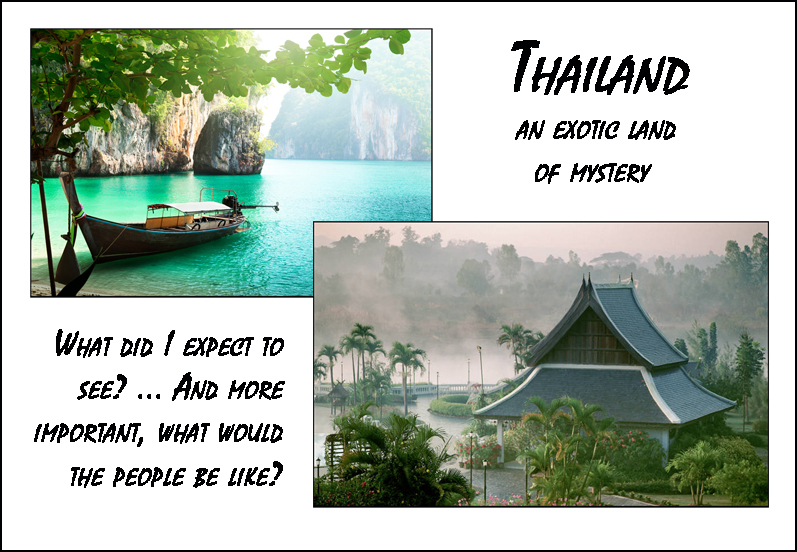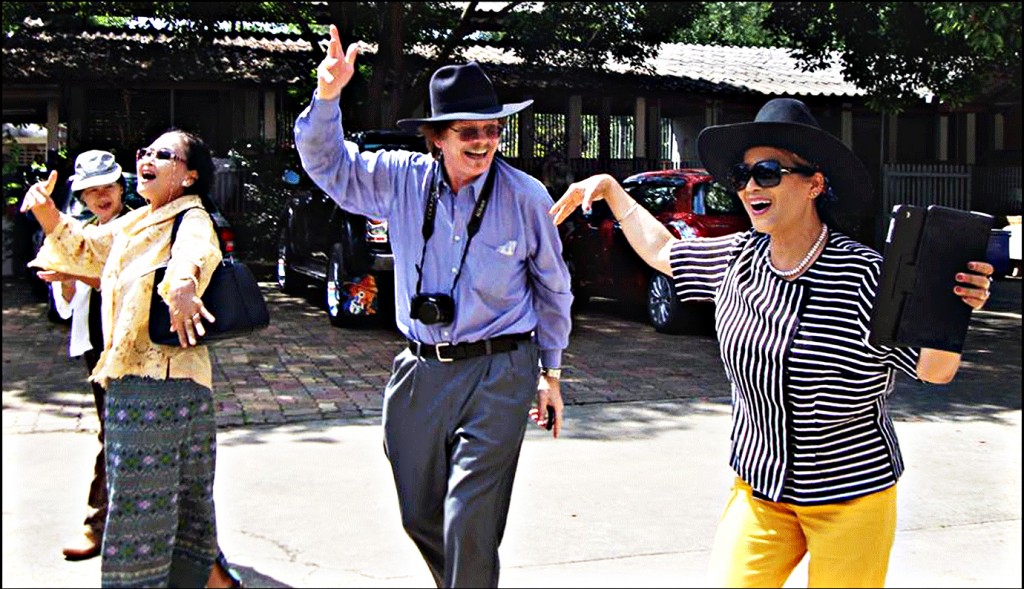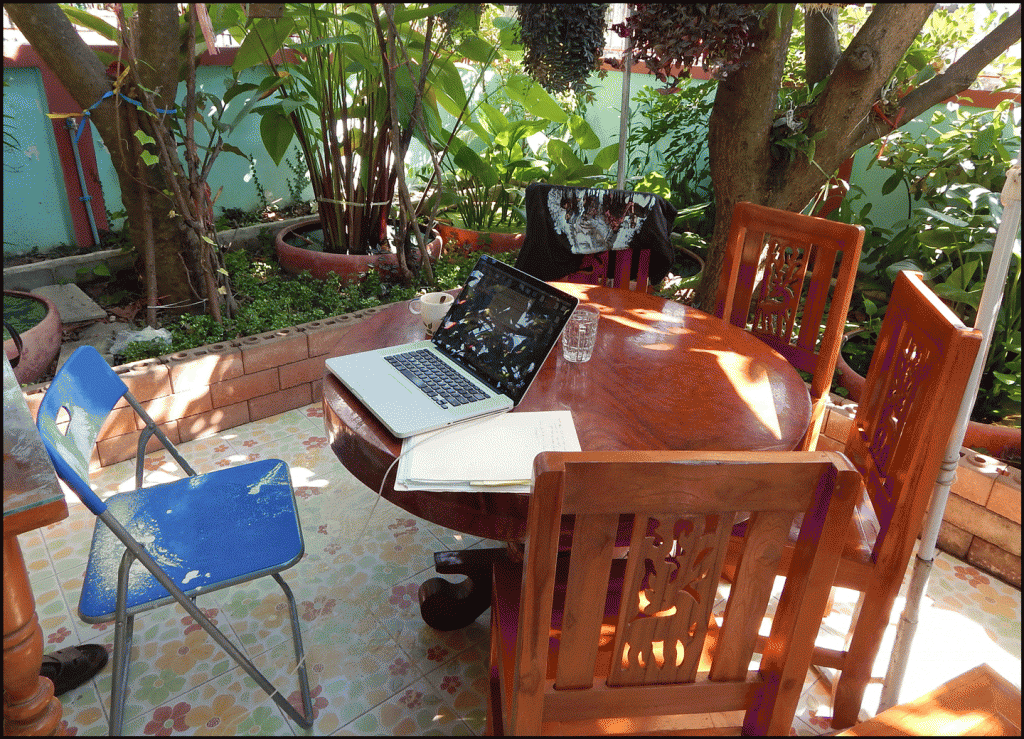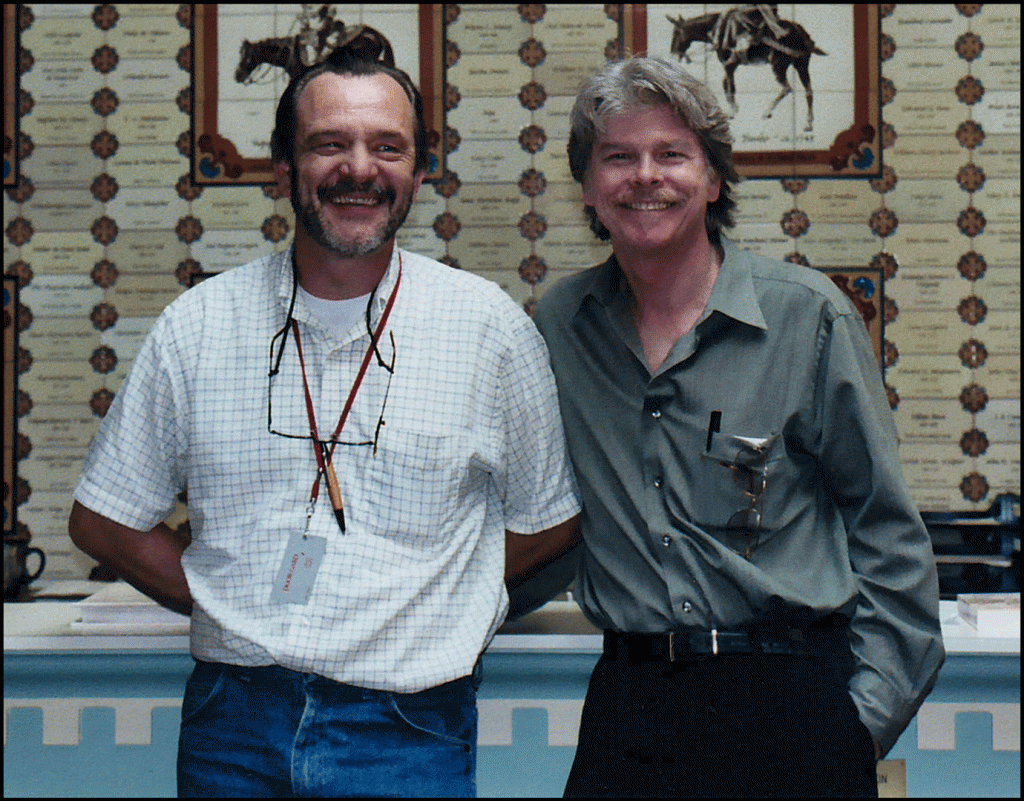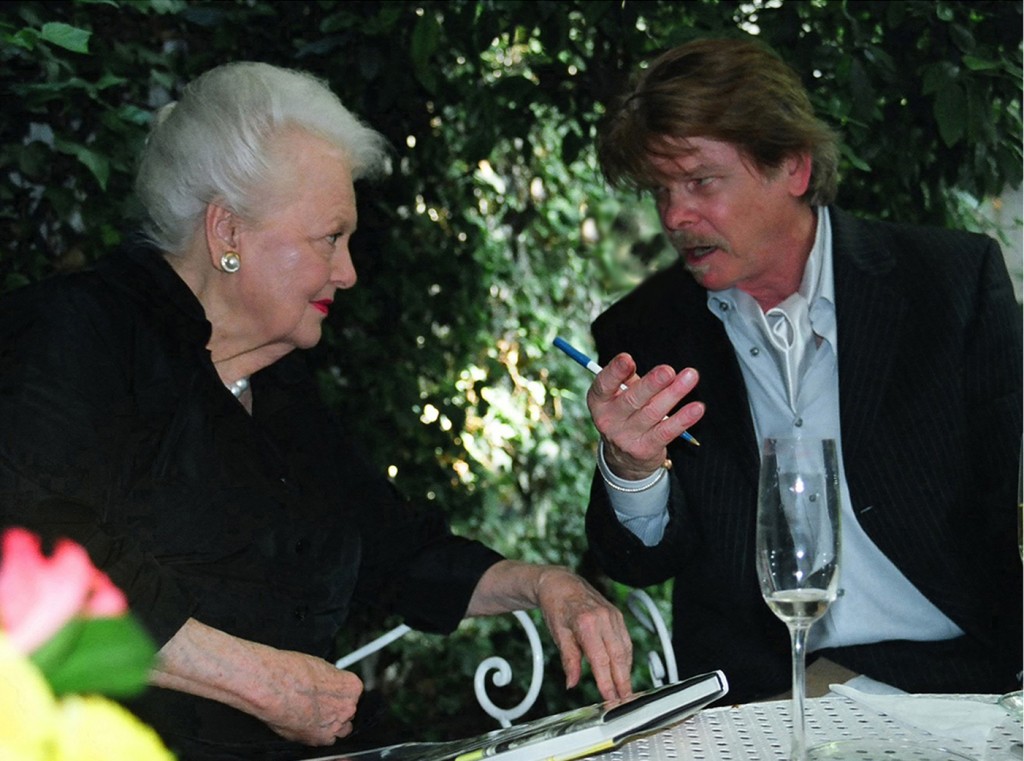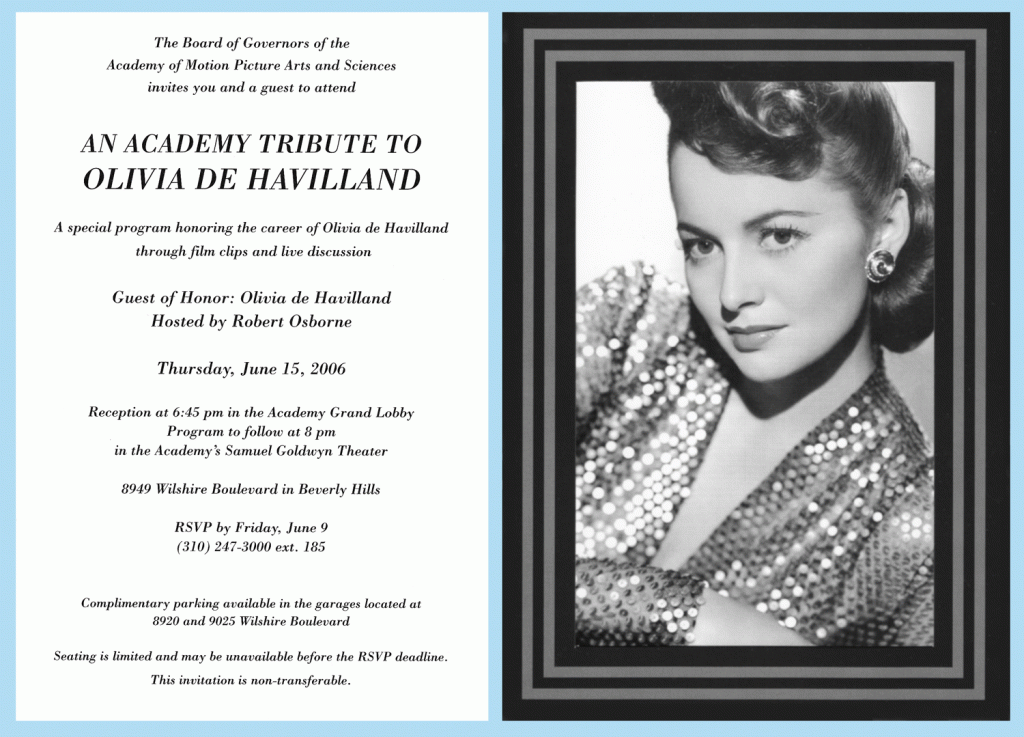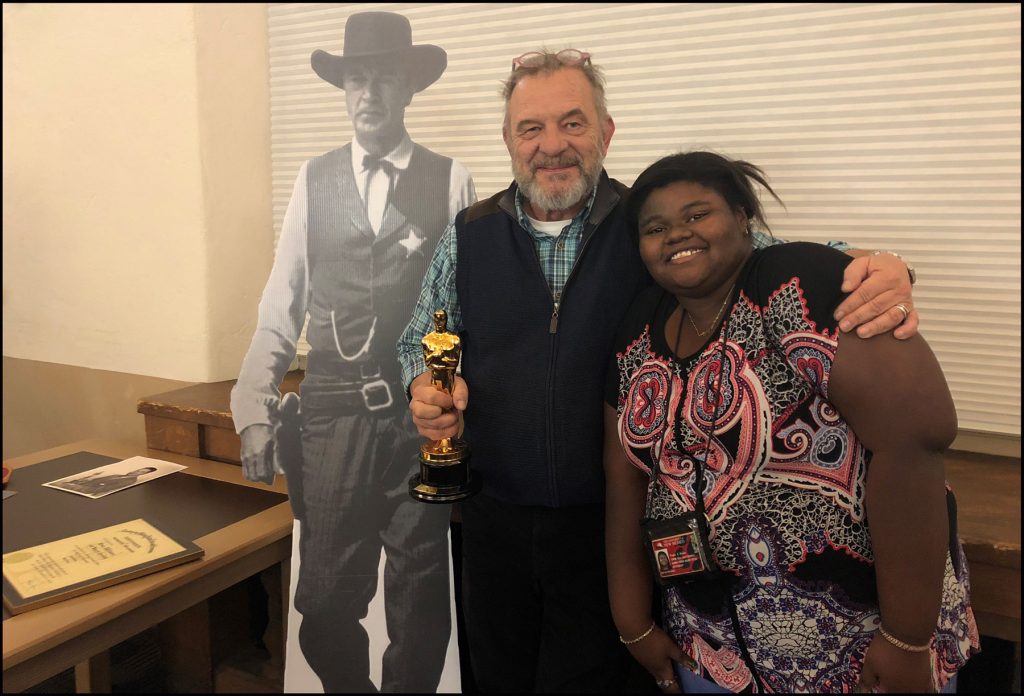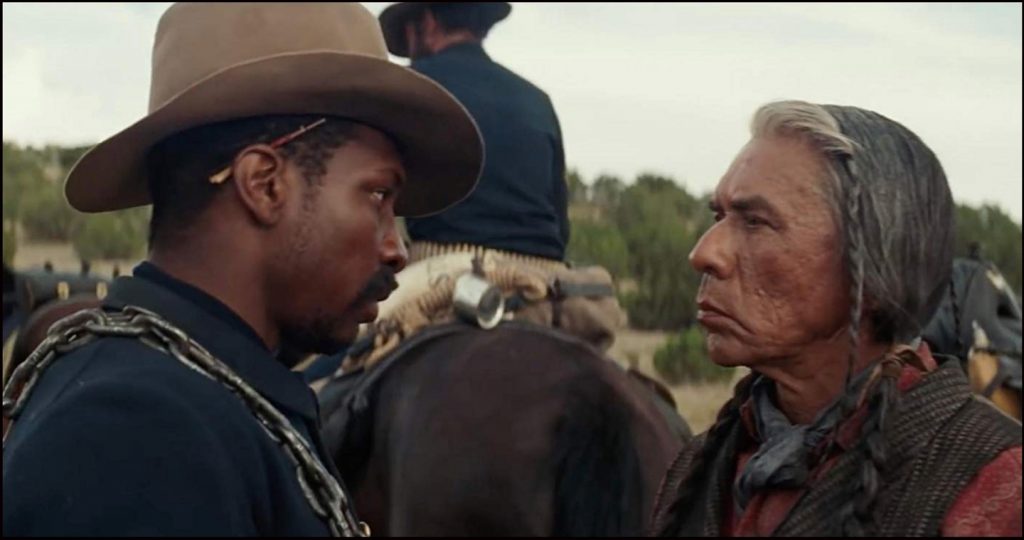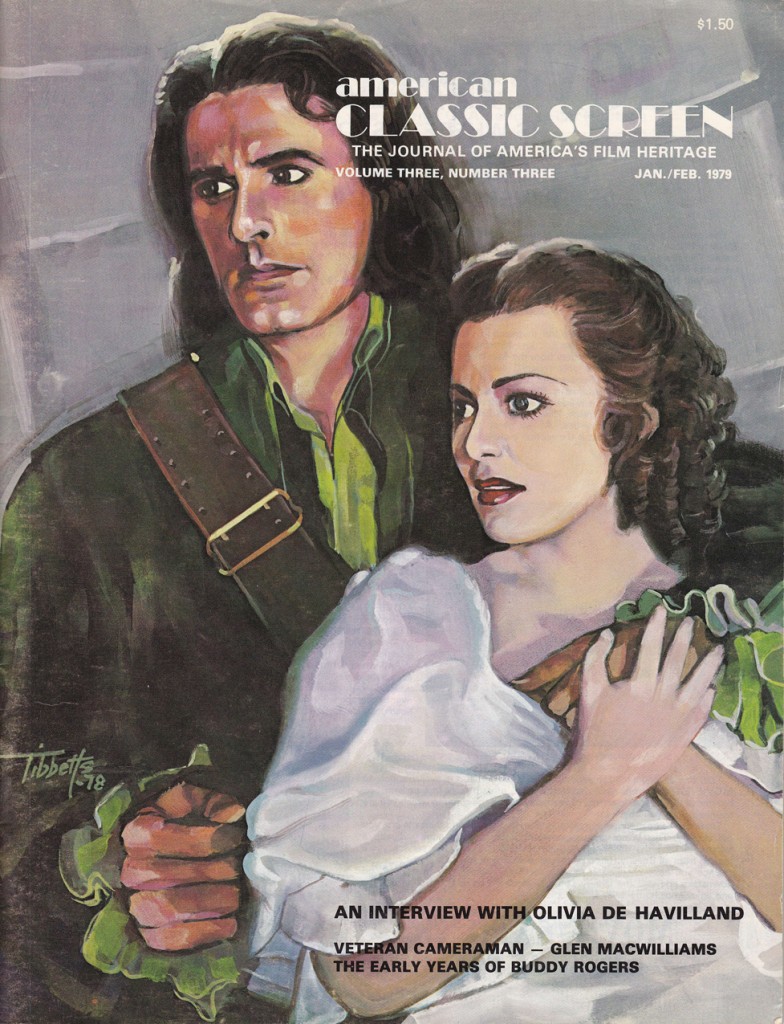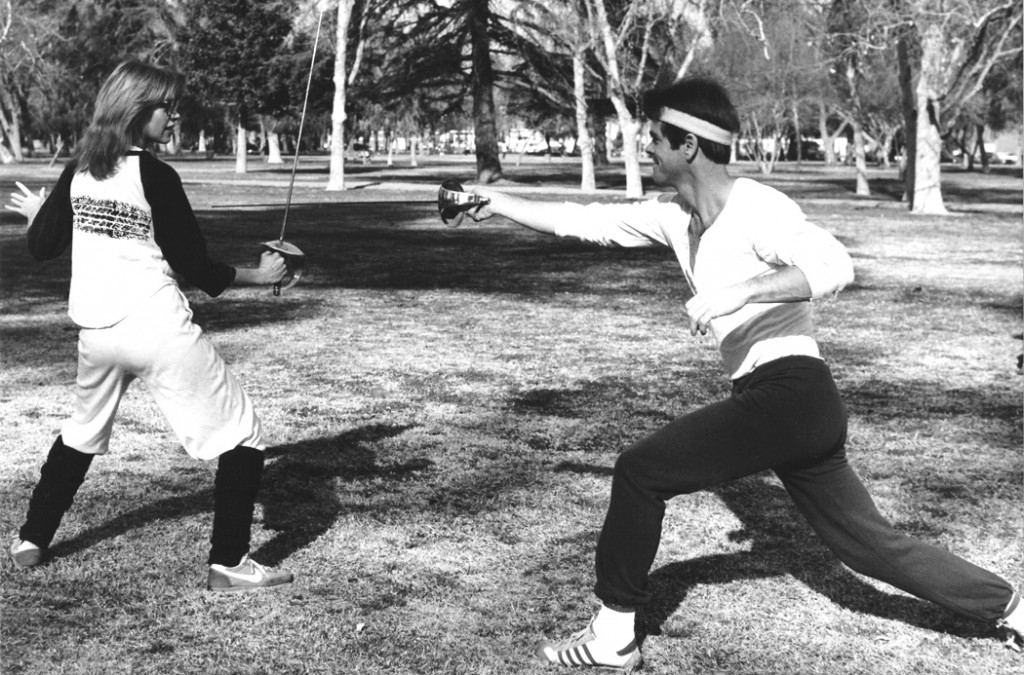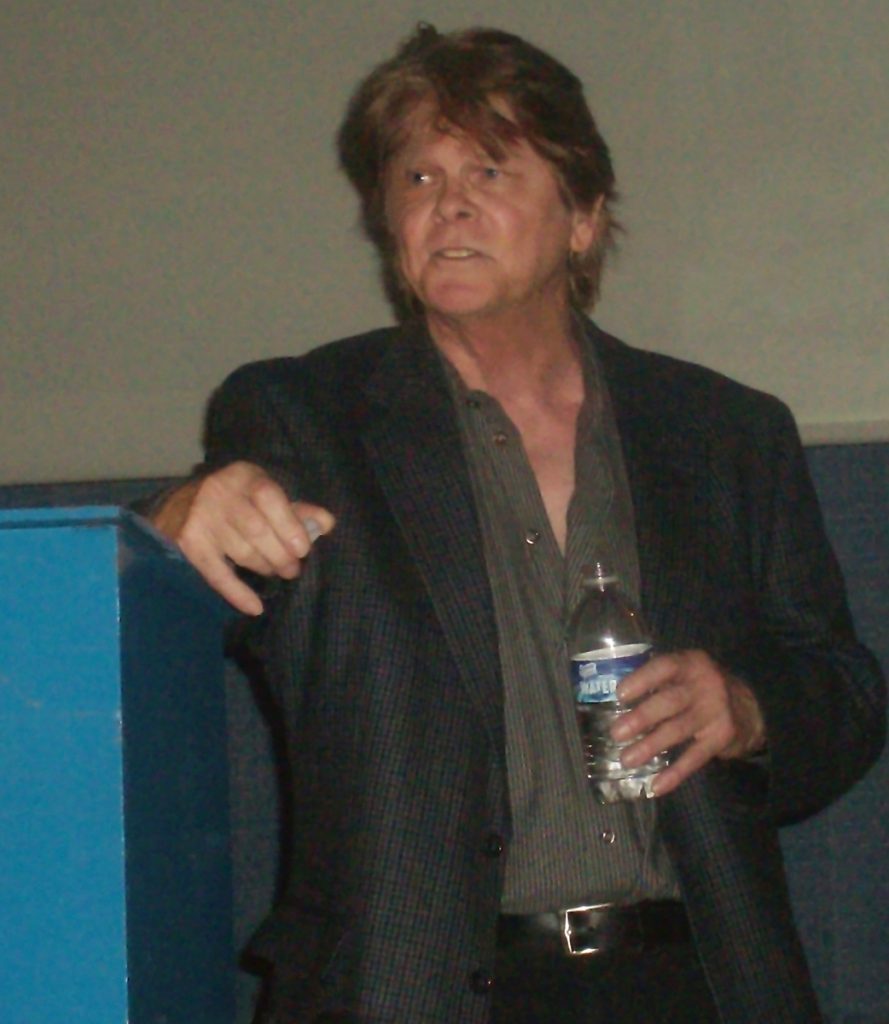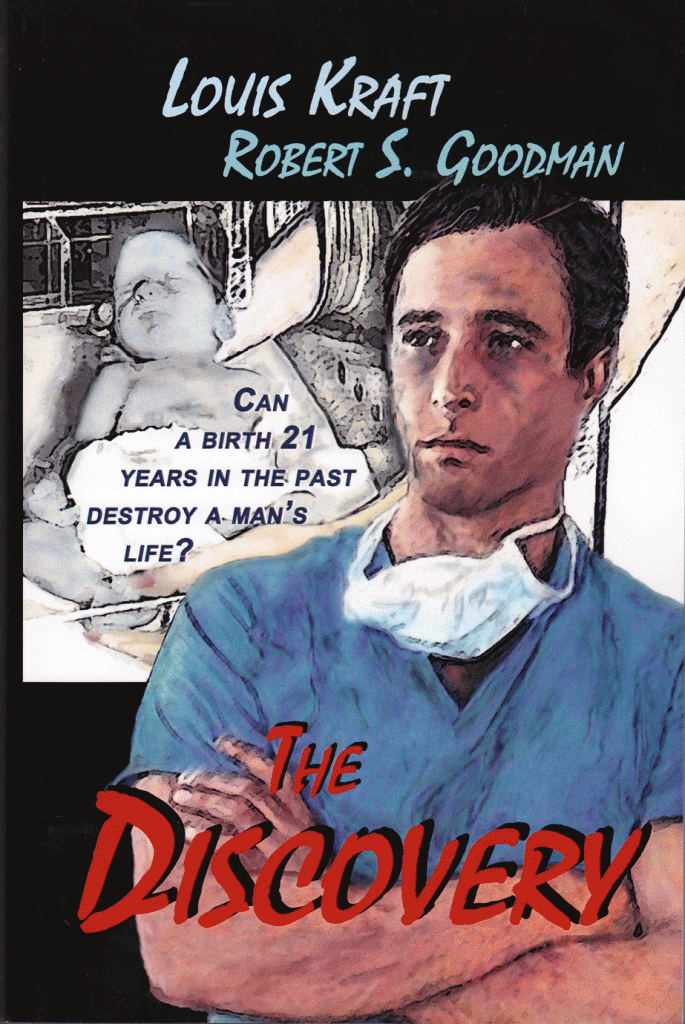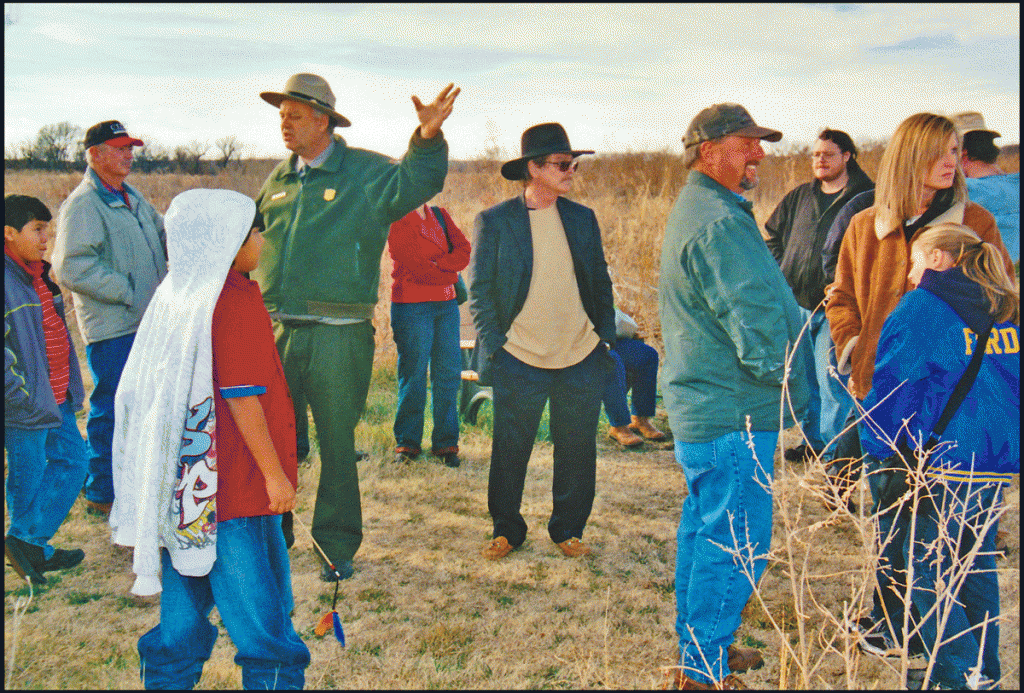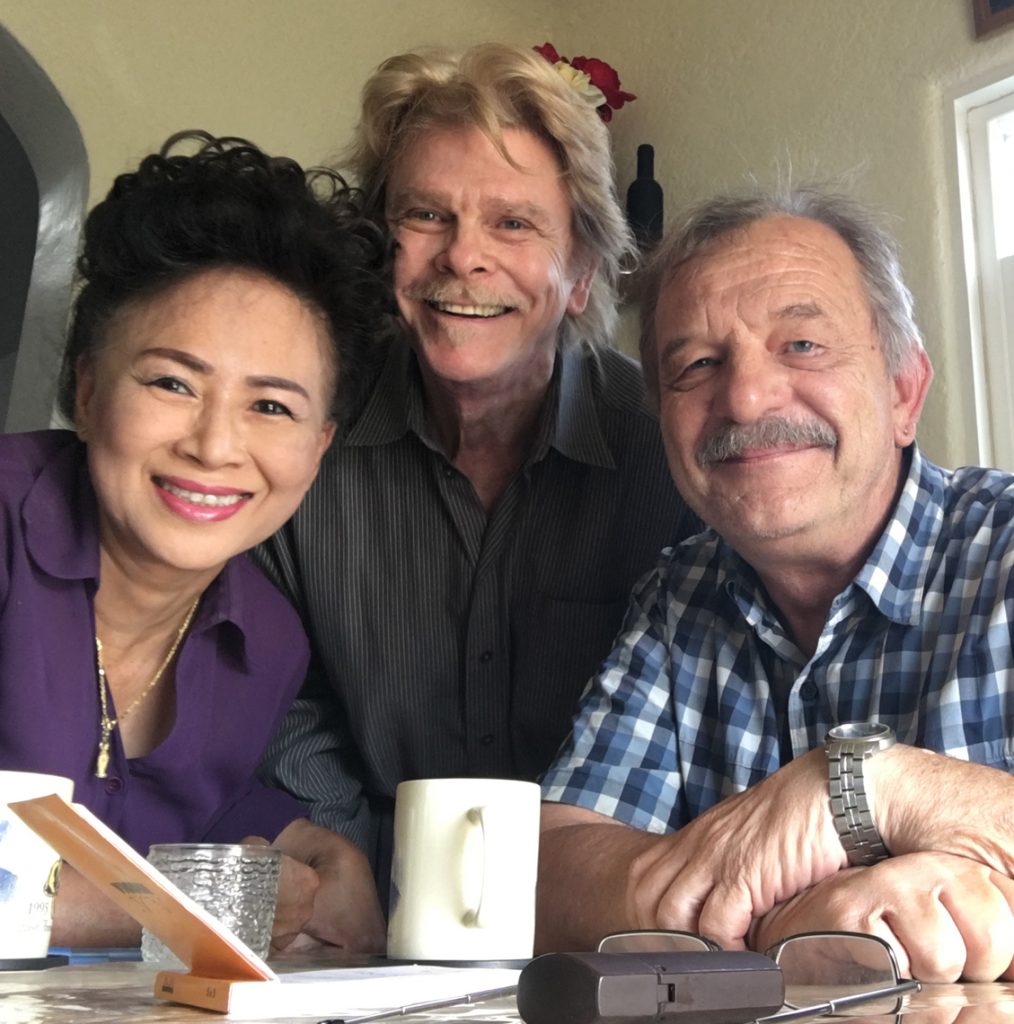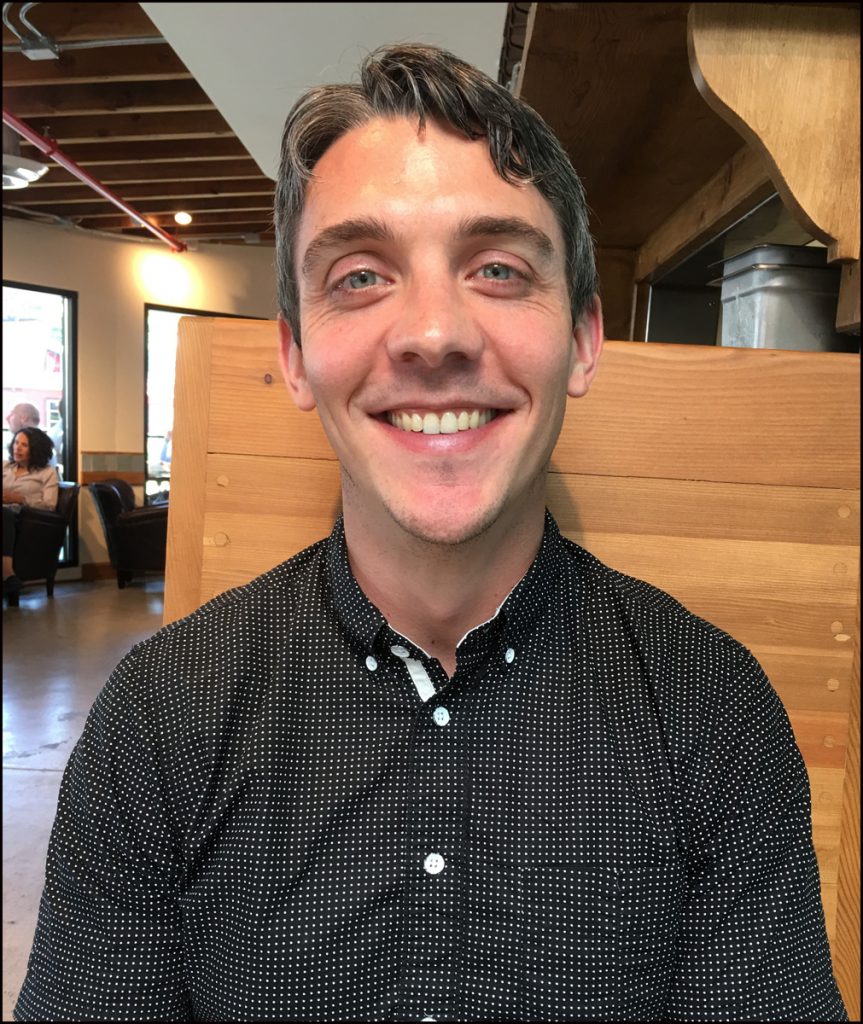Website & blogs © Louis Kraft 2013-2024
Contact Kraft at writerkraft@gmail.com or comment at the end of the blogs
First, an ad for Kraft’s next blog,
which, as usual, will be long and detailed
(that is not this blog, as it isn’t a book)
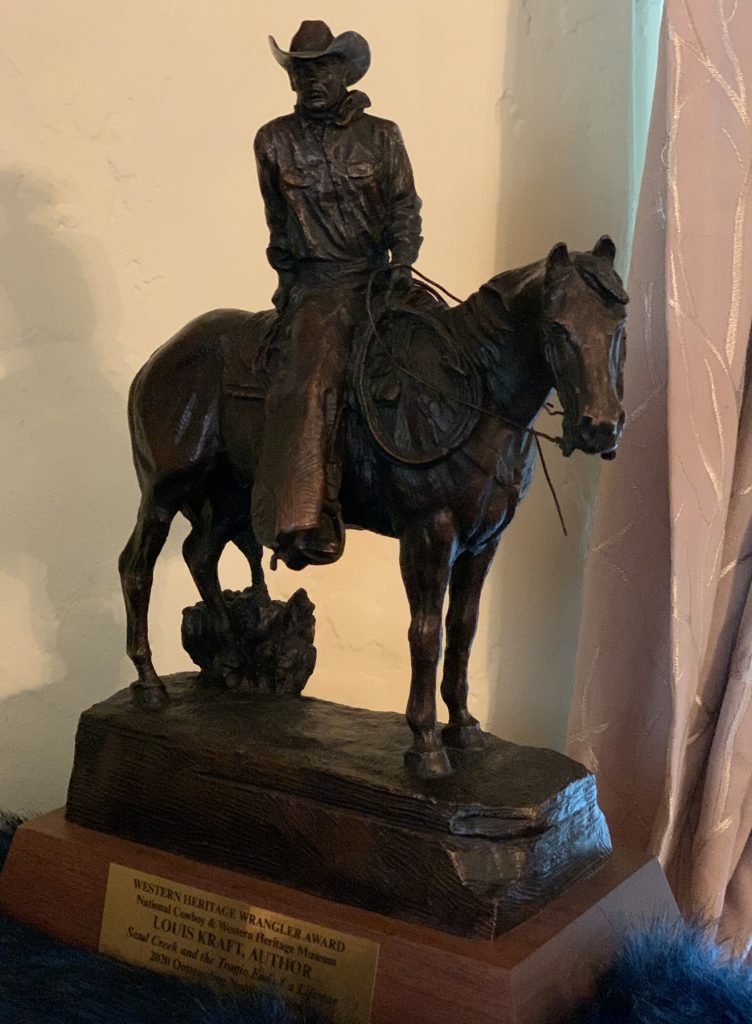
This is the 20-pound bronze Wrangler that LK won for Sand Creek and the Tragic End of a Lifeway in 2021. I won my first Wrangler Award in 2012. (photo © Louis Kraft 2022)
I haven’t written and posted a blog since September 2020 due to my ongoing work preparing for the first two deliveries to the new Louis Kraft Collection at the University of New Mexico’s Center for Southwest Research & Special Collections (UNM CSWR). Pailin and I made the first delivery in a large rented Dodge Minivan in June 2021. Tomas Jaehn is the director of this huge and unbelievable archive. He flew to SoCal in December 2021, and in a rented SUV picked up the second delivery. He will also pick up a third (and smaller) delivery on 25apr2022.
The scope of the LK Collection at UNM CSWR is unbelievable, and is by far the greatest honor this writer will ever receive.
It includes not only my writing life, but my entire life including family documents that date back the end of the 19th century, restored photos, and memoir material. The photos all have captions identifying people and events and are delivered as 8×10 inch glossies and digital copies.
But it doesn’t end with just myself, my family, and my professional life, for it also includes key people in my life as well as what I have collected over the years. This includes in part an 1856 daguerreotype of Ned Wynkoop when he was 16 as well as a small ivory calendar that he owned (he has played a huge role in my writing and later acting life); Chiricahua Apache mystic and war leader Geronimo’s signature; photos and art with signatures ranging from Brooklyn Dodgers baseball great Duke Snider and my favorite player of all time Bill Buckner to Tex Ritter and Alan Jackson to Errol Flynn to 20+ letters from Olivia de Havilland, and film stars Gong Li, Val Kilmer, and Olga Kurylenko, to mention a few (still to be delivered); as well as over 300 posters (one-sheets, half sheets, inserts, and lobby cards), many of which I had restored and mounted on linen. There is also an Errol Flynn and Olivia de Havilland Collection, and it grows with each delivery.
The year 2021 was also a great year for my last published book, Sand Creek and the Tragic End of a Lifeway (University of Oklahoma Press, 2020), as it won two best nonfiction awards:
- Western Heritage Museum’s Wrangler Award (which is major)
- Colorado Authors’ League Award
Photo of Pailin Subanna Kraft & Louis Kraft just before entering the second banquet at the National Cowboy and Western Heritage Museum’s Wrangler Awards four-day event on 18sept2021. During the first banquet on the 17th Bruce Boxleiltner sat with us at our table, and then introduced me on stage when I accepted the Wrangler for Sand Creek and the Tragic End of a Lifeway. We had hung out together in 2012 when I won my first Wrangler and he was inducted into the Western Heritage Cowboy Hall of Fame. (photo © Pailin Subanna Kraft & Louis Kraft 2021)
Sand Creek and the Tragic End of a Lifeway was life changing for me as former University of Oklahoma Press editor-in-chief Chuck Rankin said to me after it was published: “This is your masterpiece!” Regardless if it is or not, it felt good for after almost three years of us discussing how I wanted to write the manuscript he agreed. And it was a challenge to fit everything together in a linear fashion, bring the leading and supporting players to life, while completing a book wherein I delivered it with the final agreed upon word count. Not once, but twice I cut over 60,000 words from the manuscript.
I can’t tell you how many wanna-be historians stuff their error-riddled fabricated pieces of crap that they pack with fiction disguised as fact exist. One of these wanna-be she-wolves with bottle in hand will dance in the street in delight if I die before her … I mean him … oh hell, I don’t know what this she-wolf is.
I don’t know when my next blog will go live, but it won’t be soon. … Don’t worry for it won’t feature any she-wolves.
Now to this blog …
 My wonderful bro Glen Williams took this great image (right) of LK in May 2012. For me it represents exiting the past and walking into the future. In my dedication for Sand Creek and the Tragic End of a Lifeway (2020) I wrote: “For Glen Williams, my brother throughout time. Our friendship began in 1990 in a software company, and he soon became my best male friend ever. Our relationship has experienced a world of change that neither he nor I ever dreamed possible, but we have survived it. He is with me in life as he will be in death—forever linked.” Glen died on August 26, 2020, and my life has been a lot lonelier ever since.
My wonderful bro Glen Williams took this great image (right) of LK in May 2012. For me it represents exiting the past and walking into the future. In my dedication for Sand Creek and the Tragic End of a Lifeway (2020) I wrote: “For Glen Williams, my brother throughout time. Our friendship began in 1990 in a software company, and he soon became my best male friend ever. Our relationship has experienced a world of change that neither he nor I ever dreamed possible, but we have survived it. He is with me in life as he will be in death—forever linked.” Glen died on August 26, 2020, and my life has been a lot lonelier ever since.
(photo © Louis Kraft & Glen Williams 2012)
Perhaps an LK explanation would be nice
With my life, and my life expectancy, my upcoming books are my writing life. This portion of my future has been a long-time coming, and the shift in direction has been in my vision for decades. This means a number of things. ..
No more articles (I’m sick of my pitches being accepted and then an editor tells me he wants Gatewood, Geronimo, or Custer articles—that’s past tense, as I don’t write about them any longer … not quite true with Mr. Custer (see below). Most likely there will be no more talks unless I receive my former fee of $750.00 and all expenses; no more writing for the software world and they eventually paid me six figures (I’m still approached multiple times each week) as I’m no longer Scrooge McDuck (of Donald Duck and Walt Disney fame). … This said, and when I quit the entertainment world cold turkey in the mid-1980s, I made it clear that I’d never act again. Oops! “Never say never,” at least for me, for in the first decade of this century I wrote four versions of a one-man show on Ned Wynkoop that played in Kansas, California, Colorado, and Oklahoma, and then a full-length play, Cheyenne Blood, that played for five weeks in Southern California. … What’s in my future? I don’t know.
Hopefully Olivia de Havilland enjoyed—as much as possible—her 104th birthday. I have every intention of enjoying my 104th birthday.
Key questions
As the years flash by at lightning speed there are two things that I now always ask myself:
- Will I read the book or primary source material again for pleasure?
- Do I need the book or primary source material for research?
If the answer is not “yes” to either question, the book/publication or primary source material has to go.
The Louis Kraft book list
The first three books in this list are most likely in the correct order, but after that it will probably turn into a flip of a coin numerous times before the following story ideas are ordered correctly.
Errol & Olivia (nonfiction)
This book has been in development since the mid-1990s. In case you didn’t know it, I’m “slow Kraft.” During this time the scope of Errol & Olivia has grown. This is good, as this manuscript will now include key events in their lives during the 1940s that are important.
Bragging aside, I have more primary source information about Mr. Flynn and Ms. de Havilland than I have for any of my Indian wars race relation books. For the record I have a ton on George Armstrong Custer; Lt. Charles Gatewood/Geronimo/Apaches; Ned Wynkoop/Cheyennes; and the Sand Creek massacre including Cheyennes/Arapahos, whites who married into the tribes, their offspring, whites who craved Indian land at all costs, and the few whites who spoke out against the sexual mutilation of human beings books, … meaning I have an EF & OdeH goldmine.
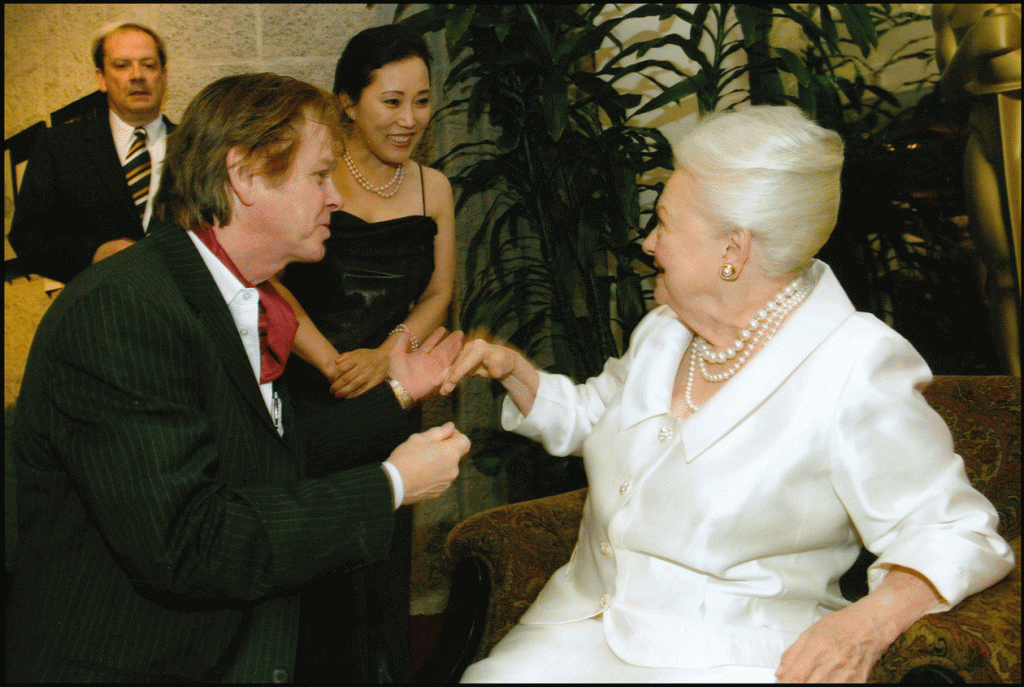
LK introducing my then girlfriend Diane Moon to Olivia de Havilland at the Academy of Motion Picture Arts & Sciences (Beverly Hills, California) on 15jun2006 that honored her life and film career. There’s a story here. Hell, there’s always story in LK’s life. Do I tell it here? No, for it will be in Errol & Olivia. (photo © Louis Kraft 2006)
I enjoyed a 20-year letter correspondence with Olivia, and she invited me to her Paris, France, home twice to spend time with her and to interview her, as well as inviting me to the Academy of Motion Pictures Arts & Sciences gala when they honored her life and career. A large portion of my research on her and Mr. Flynn (and I have more on EF) is now housed at the LK Collection at the University of New Mexico’s Center for Southwest Research & Special Collections (it is the largest collection of them in the USA).*
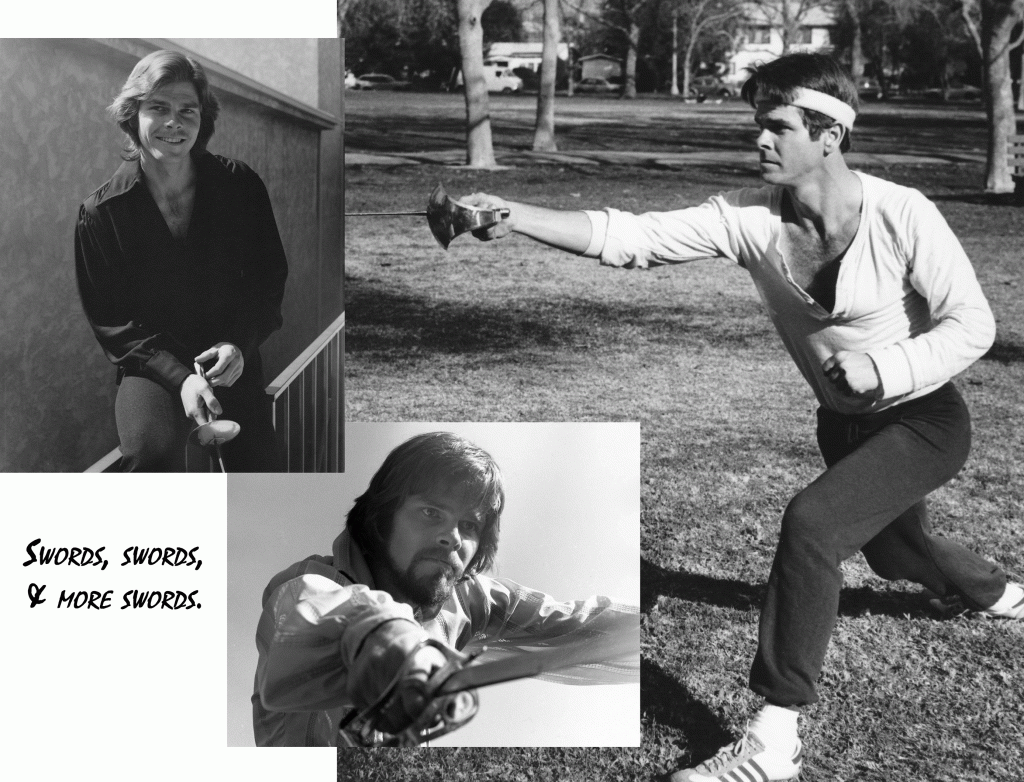
Oh yeah Kraft knows the sword. I had planned on using art of Errol Flynn here, but got tired seeing my art stolen and then see it all over the internet. No one’s going to steal this collage for they couldn’t give a bleep about Kraft handling a blade. I will deal with EF’s swordplay in the books. I know that some people aren’t interested in this. I am, so they lose. This line of thought didn’t last long, for there is art of EF directly below. (all images © Louis Kraft 1970s & 1982)
* Any archival information I have, such as from the USC Warner Bros. Archives (Los Angeles, California), Arizona Historical Society (Tucson), or Colorado Historical Society (Denver), and so on, including photocopies, PDFs, and photos, belongs to the archive that I obtained it from and it can never be in the Louis Kraft Collection at UNM CSWR (not catalogued or available to the public yet) or in the first Louis Kraft Collection at the Chávez History Library, Museum of New Mexico, Santa Fe (created in 2002).
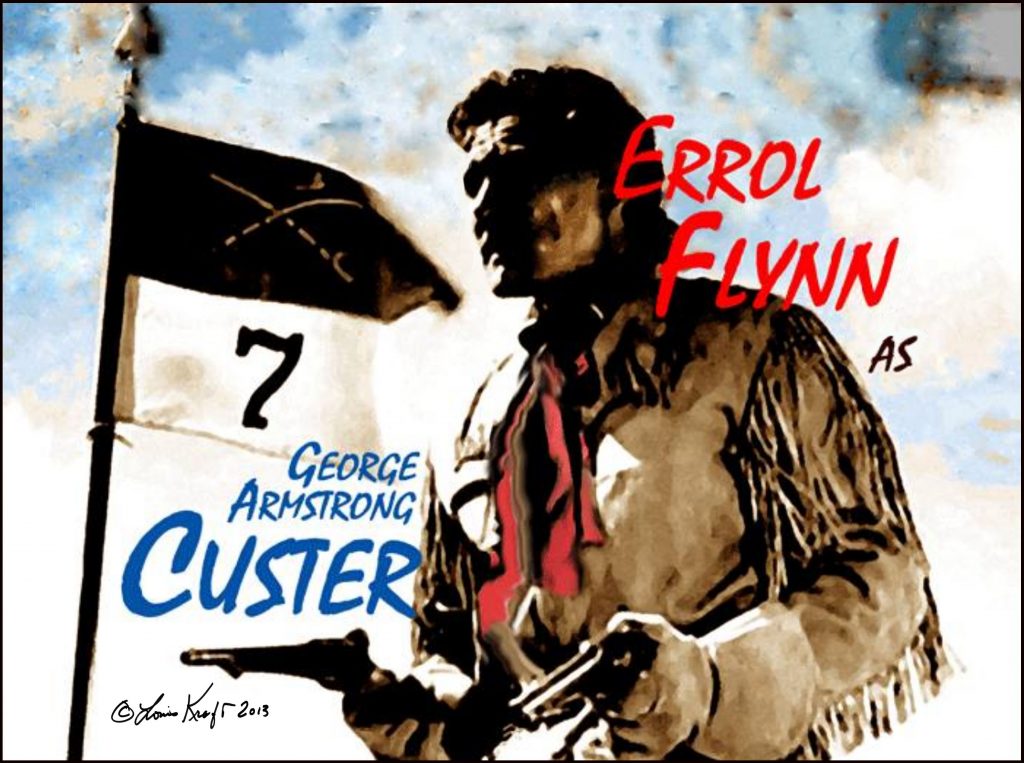
I changed my mind from the above caption as I’m certain that this image will not appear in my books. Flynn and Livvie (as Errol and others called Olivia) made their last film together in 1941—They Died with Their Boots On (Warner Bros.). Flynn played Custer and Olivia played Elizabeth Bacon Custer (“Libbie”). I have much to say about this film and their lives while working on it. (art © Louis Kraft 2013)
As with my last four Indian wars books Errol & Olivia will be published by a university press. The reason is simple: University presses strive to eliminate errors while including notes that allow their readers to locate and view the authors’ research whereas popular presses reprint errors ad nauseam while also printing new errors that will also be reprinted by writers too lazy to do real research.
My Flynn/de Havilland collection is locked down until this book and Errol Flynn: The Defining Decade are published or December 31, 2031, whichever comes first.
**********
The next book is fiction, and thereafter there is more fiction in my future than nonfiction (I know, pure heresy) but I’m a writer. I have written screenplays, plays, talks, articles, and books, not to mention 20 years writing for the software world. I have always been in control of my writing life (and even when writing technical documentation). Here’s two examples:
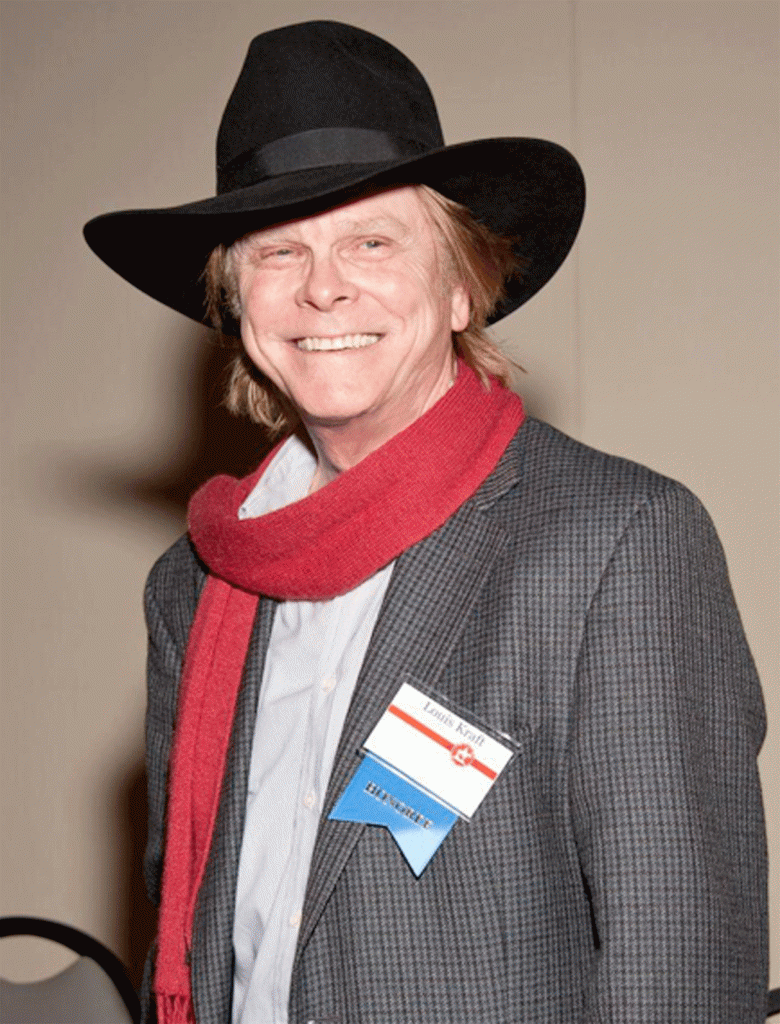
Louis Kraft at the Western Heritage Wrangler Awards event in April 2012. This photo was taken shortly before the book signing on the afternoon of the twentieth.
In 2011 Wild West magazine sent me a proof of my article, “When Wynkoop was Sheriff.” When I saw it I called photo editor Lori Fleming, and told her to enlarge my art of Ned Wynkoop on the first page of the article as it was dinky and the story was about him. She told me that the issue had already been designed and there was no room. I told her to remove one of the two images of Rocky Mountain News editor William Byers that I had supplied, and she told me “no.” “Fine,” I said, “kill the article for you will no longer publish it.” There was a long pause. “You call Greg, and talk to him!” she screamed and hung up. Greg was/is editor of Wild West, Gregory Lalire. I didn’t call. A few days later he called me and said, “I hear you have a problem.” “No, I don’t have a problem, but Lori does.” I told Greg what I wanted, and he said, “I’ll take care of it.” He did and “When Wynkoop was Sheriff” won my first Wrangler Award.
In 1990 when I landed my first writing job in the software world at Infonet Services Corporation I quickly realized that the only thing the other technical writer did was edit engineer copy when provided. Otherwise he spent his time on the phone with his girlfriend. I couldn’t believe what I saw. On my third day on the job I walked into documentation manager Howard Burnaugh’s office and told him that I needed the software for the product I’d be writing about on my computer. “Why?” “How can I write about a product when I don’t know how to use it?” I then added that I wanted a list of all the engineers that I’d be working with—two days later Howard provided both to me.
**********
Navajo Blood (fiction)
Before saying a word about this story that has been dormant since the mid-1990s, I was in the process of preparing yet another delivery to the LK Collection in the Chávez History Library, when I uncovered a polished draft of my novel and all the accompanying documentation.
I prepped it for that delivery, but it never happened as Tomas Jaehn’s pitch to create a second LK Collection ended my deliveries to Santa Fe. … Am I a traitor/deserter to the first LK Collection? Maybe, but the newly created LK Collection at UNM CSWR is, and will forever be, the greatest honor bestowed upon this writer who learned his craft by the seat of his pants.
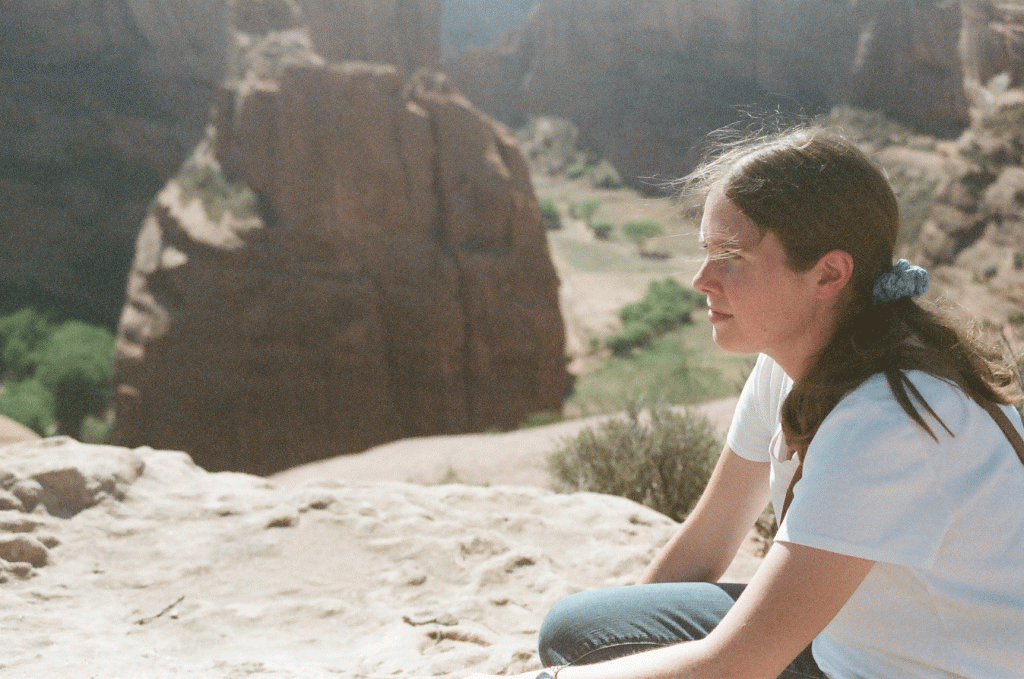
Marissa Kraft sitting near a ledge on the north side of the three canyons that are known as Canyon de Chelly on the Navajo Reservation on 7aug2012. In the background is Navajo Fortress Rock, which is a key set piece for Navajo Blood . This was her third, and my fourth extended trip to the Canyon de Chelly National Monument, and the only national monument not on USA land. (photo © Marissa & Louis Kraft 2012)
Changing focus, in June 2019 my daughter Marissa Kraft and I enjoyed a work and R&R trip to Tucson, Arizona, a city that I fell in love with in the 1970s, when my first wife and I spent a lot of time with her brother and his bride while he attended the University of Arizona. I can’t begin to tell you how much time I’ve spent there, but my research for the two Gatewood/Geronimo/Apache books kept me there for many months, and it is easily over six and a half months throughout the years. …
That 2019 June in Tucson Marissa and I saw and spent time with friend/literary agent Cherry Weiner at the Western Writers of America convention. We didn’t attend the event, but instead mingled with it at the hosting hotel. The polished genre draft of Navajo Blood was 65,000 words, and since discovering it I had been thinking about increasing its size by 35,000 words to make it an historical novel. Cherry totally agreed and might be interested. … The goal here is to add more Navajo words, culture, and mysticism, as well as more dialogue, character development, and action.
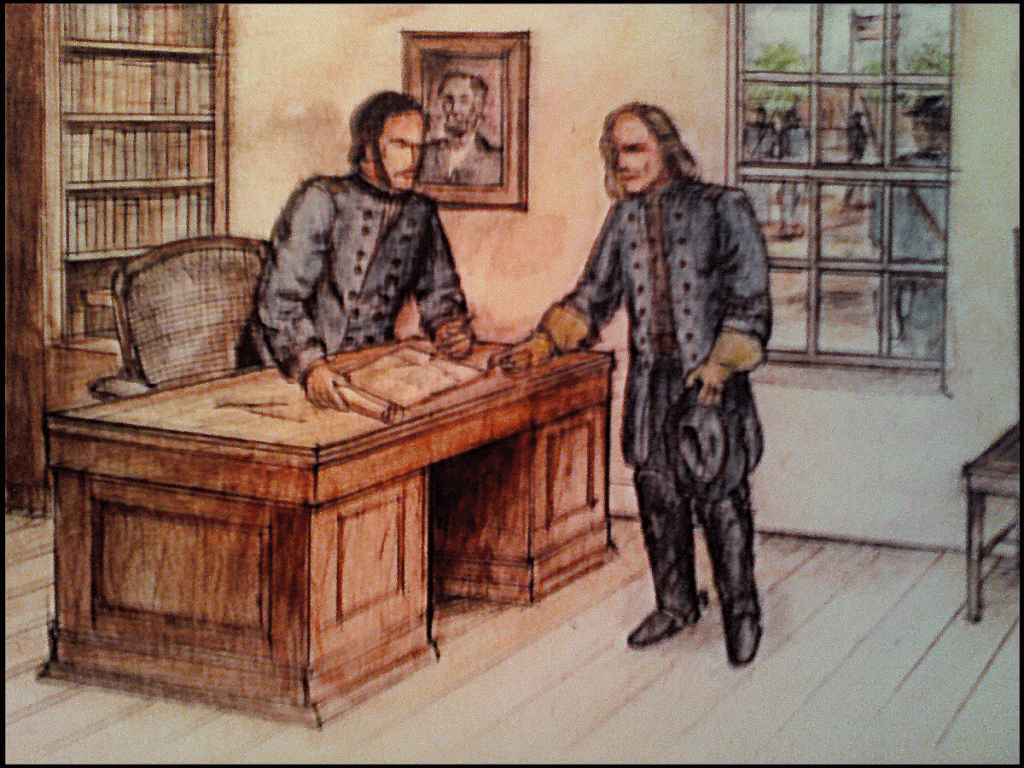
Colonel Kit Carson (right) receiving his orders from Brigadier General James Carleton in 1863 to launch a war against the Navajos, an assignment he didn’t want as the Diné were his friends. This is a detail of art displayed at the Bosque Redondo Memorial Museum in southeastern New Mexico. This museum is magnificent, and puts many national historic sites in the USA to shame.
The leading players are a Diné (as the Navajos call themselves) warrior, his granddaughter, Kit Carson, and his family during the early 1860s. I’ve shared more in the past, but not here. I will easily complete and polish a 100,000-word draft while continuing primary-source research on Errol Flynn: The Defining Decade.
Navajo Blood is also locked down at the Louis Kraft Collection, UNM CSWR, until it is published or December 31, 2031, whichever comes first, per my contract.
Errol Flynn: The Defining Decade (nonfiction)
I discovered Errol Flynn while in elementary school about two years before he died on 14oct1959. He grabbed my attention then, and believe it or not he has never let go. I’m going to say a few words that are probably in total disagreement with what has circled the news media, the internet, and in way too many publications since 1980 when Charles Higham’s heinous and untrue biography, Errol Flynn: The Untold Story, was published. In the United States you can defame the dead. In Canada you cannot defame the dead, meaning that in the USA Higham got away with murdering EF’s life and legacy. Not so in Canada where Higham’s despicable book was also published. Flynn’s two daughters Deidre and Rory with his second wife Nora Eddington sued him there. To avoid going to count Higham never again traveled to Canada during in his lifetime.
I hate to say it but there are other books as despicable as Higham’s or worse.
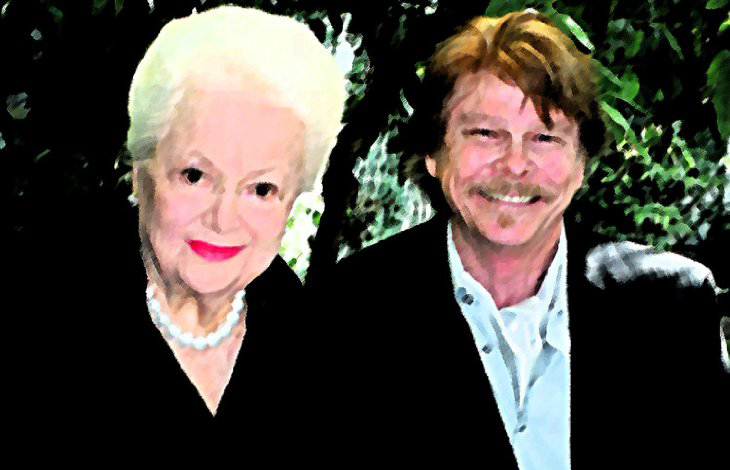
LK’s art based upon a 2009 photo taken at her home in Paris, France, in July 2009. Believe it or not years back a person accused me of creating this false piece of art us as I didn’t know Olivia. (art © Louis Kraft 2013)
For what it is worth, Olivia shared only a few thoughts about Higham’s book on EF or his book on her and her sister film star and Oscar winner Joan Fontaine. I share her thoughts on Higham in Errol & Olivia. Beyond that, she refused to talk.
As stated above more archival research is still needed and it is ongoing as time permits. The title says it all, and, God willing, I’ll see it published. Sorry, no more information at this point in time as there are thieves out there who would love to steal my story idea and publish long before I do.
My Flynn/de Havilland collection is locked down until this book and Errol & Olivia are published or December 31, 2031, whichever comes first.
Everything that follows will be determined when it is time to choose a follow-up book to Mr. Flynn. .. At the same time I’m wondering how much I can share of upcoming fiction without giving away too much of the plots.
LK Memoir (nonfiction)
This has been an announced project a decade or more back. Will it ever be written? I don’t know but hope so. There’s been a lot of failure, a lot of tragedy, a lot of special people, a lot of idiots (including a racist pig—my view of this piece of slim isn’t printable), a lot of incidents that will make you cheer or laugh or cry or scream or cringe. Say it “ain’t” so LK! Alas, ’tis so. …
The LK Collection at UNM CSWR includes a large section called “Louis Kraft Memoir,” and it grows with each delivery. It includes everything from notes documenting an event to historical documents, such as my father’s discharge from the U.S. Marine Corps on 1aug1946 to a package of hair with one word on the outside of the 8½ x 11″ manilla envelope that proclaimed “SHAME” in large red letters that made me thrilled that I lived on the West Coast while the lady who sent me the package lived on the East Coast as the threat was real.
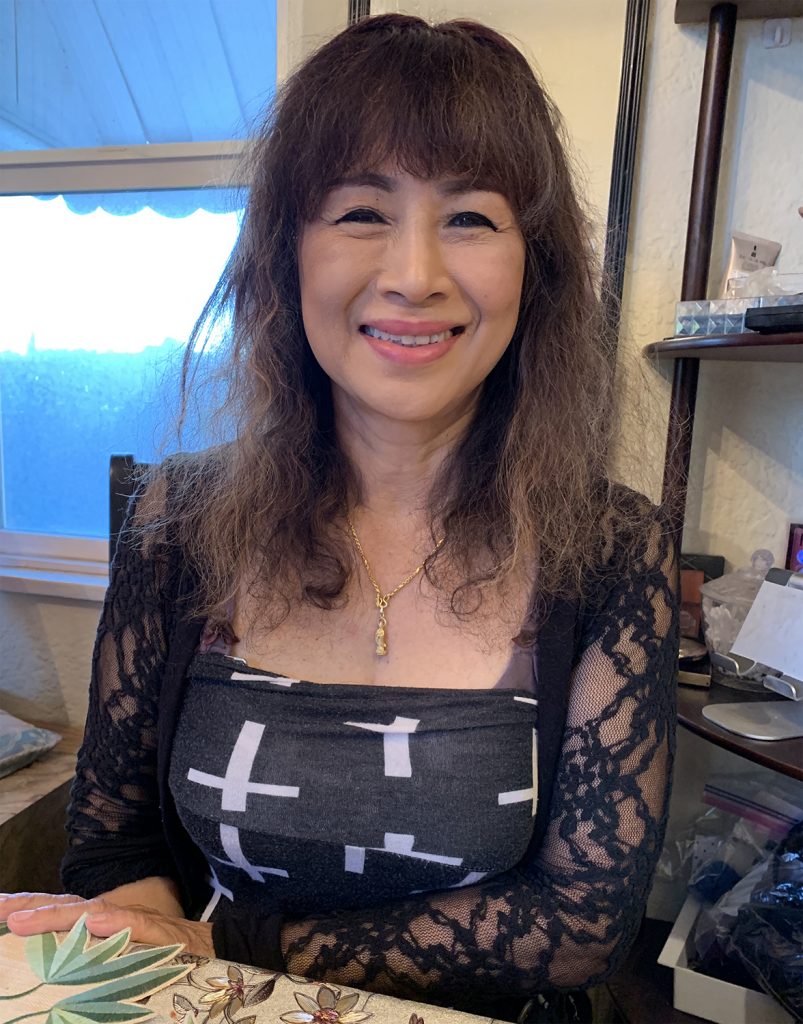
My beautiful wife Pailin Subanna Kraft at the end of our Thanksgiving dinner on 25nov2021. I have just completed preparing this image of her with a caption for the third delivery to the LK Collection at UNM CSWR on April 25. Oh, the second portion of the dedication in Sand Creek and the Tragic End of a Lifeway stated: “And for Pailin Subanna-Kraft, my lady, best friend, wife, and love, who has accepted my life and world without question. Without her I would have no life.” After she became a U.S. citizen in 2020 she removed the hyphen from her last name and made “Subanna” her middle name. (photo © Pailin Subanna Kraft & Louis Kraft 2021)
I was working on the third LK Collection delivery to UNM during the Oscar telecast on 27mar2022, but had a link for “Oscar Winners” on the internet so during breaks I could see what was happening. On live TV Jada Pinkett Smith was verbally insulted/attacked before a global audience. This was not an ad-lib by any stretch of the imagination. No! It was heinous in its intent and Will Smith walked onto the stage and slapped Chris Rock on the face and then returned to his seat where he later yelled: “Keep my wife’s name out of your fucking mouth!” Mr. Smith has since taken a lot heat. On April 1st he resigned from the Academy of Motion Picture Arts & Sciences. while humbly apologizing for his actions.
I understand his live apology when he accepted his Oscar for best actor, again the following day, online, and his announcement on April 1st. He’s a real human being, and I have nothing but praise for him. On April 8 the Academy banned Smith from all events (not their wording) for 10 years. Will Smith had the perfect response: “I accept and respect the Academy’s decision.” … When your lady, your wife, you loved one is verbally assaulted as Jada was, or as my beautiful wife Pailin has been, it is totally unacceptable. …
Pailin didn’t learn of Will Smith defending his wife until the following morning when she saw the news on a Thai broadcast. I was working on the delivery to UNM and was at my computer when she asked me what I would do? I followed her into the kitchen, and when she turned back to me I swung at an invisible figure with an open hand. She grabbed me with joy and we shared a long hug as I would defend her in the flesh against some of the heinous insults that have been directed at her and myself, and they will be in the memoir.
 In Errol Flynn’s great autobiography/memoir he attempted to tell the truth—good or bad—but it was mostly (not all; but mostly) from his memory. There are some errors (and not all were created by him; read his publisher or ghost writer). How many celebrity memoirs have you read? How many were total gloss-overs wherein the subject never cursed, never lied, never stole, never cheated, never did drugs, never was a racist? In other words they were God’s gift to humanity. The absolute perfect person. Errol got it right (however, if he had been living when it was published in late 1959 he could have been sued). If ever I write a memoir my goal will be to tell the truth.
In Errol Flynn’s great autobiography/memoir he attempted to tell the truth—good or bad—but it was mostly (not all; but mostly) from his memory. There are some errors (and not all were created by him; read his publisher or ghost writer). How many celebrity memoirs have you read? How many were total gloss-overs wherein the subject never cursed, never lied, never stole, never cheated, never did drugs, never was a racist? In other words they were God’s gift to humanity. The absolute perfect person. Errol got it right (however, if he had been living when it was published in late 1959 he could have been sued). If ever I write a memoir my goal will be to tell the truth.
Finally, and like Mr. Flynn, I need to be dead when this book is published as I don’t want to be confronted by a mob armed with guns, knives, bombs, and an army of lawyers.
Muse Eternal (fiction)
Archaeologist Olivia Mitchel uncovers a disturbing array of Anasazi bones at newly discovered ruins outside of Albuquerque, New Mexico. Close examination leads her to believe what she has found could be an example of ritualistic cannibalism. As this is heresy she keeps her discovery to herself.
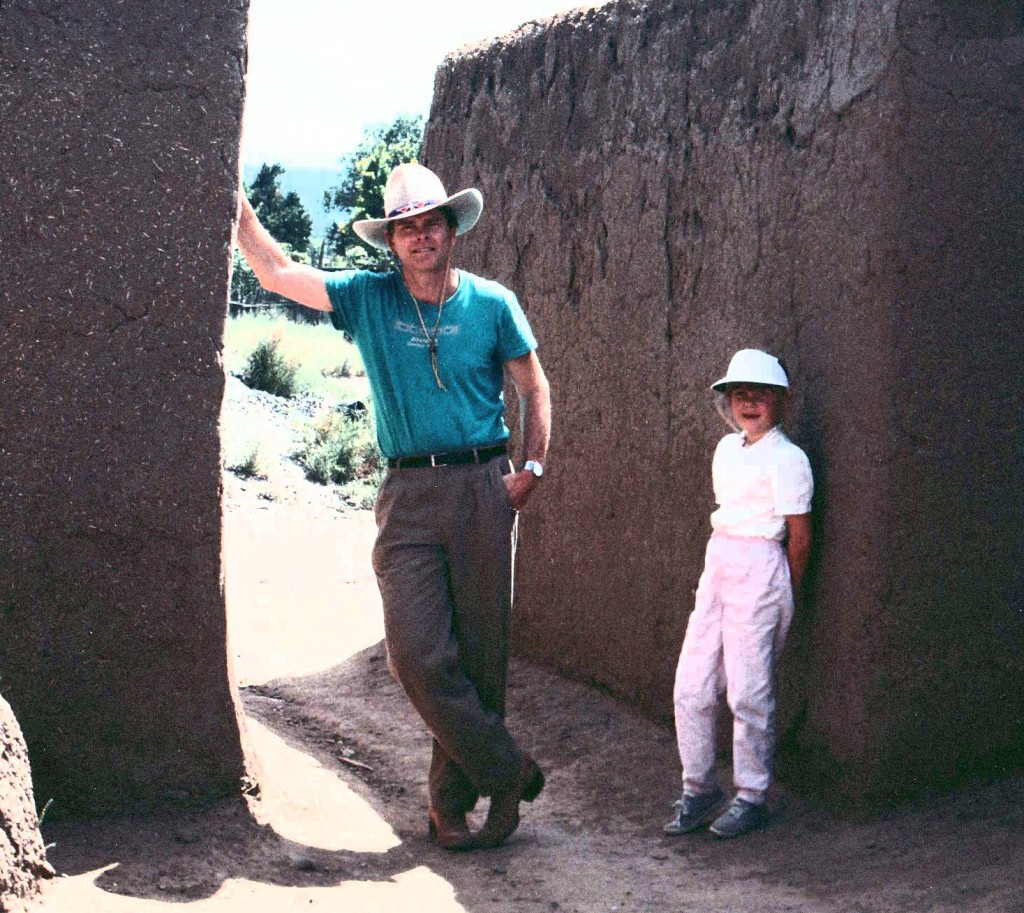
This image was taken on 8sept1989 at Taos Pueblo, New Mexico. In this image my daughter Marissa is six and a half years old. At this point in time I may make Elsa, Olivia’s daughter, six while also considering making her 10 or 12. This decision is still floating on the wind. (photo © Marissa & Louis Kraft 1989)
Olivia, her daughter Elsa, and renown archeologist Charles Fairbanks go to Albuquerque for a weekend of R&R. Charles is Olivia’s mentor and lover. During their three days of partying Charles is invited to a banquet wherein the keynote speaker is a noted Indian wars historian. The evening of the event begins fabulously but ends on a sour note in the after hours when the writer named Jon Werner wins over Elsa while Olivia and Charles party with the elite of New Mexico. Later that night Olivia hesitantly presents her mutilated bone theory to Charles. He warns her that she is treading on dangerous ground. Many in the archeological field prefer the status quo of the Anasazi—that of the peaceful, sedentary people of legend. Olivia discounts the warning as little more than hidden jealousy.
The above is just a tad of what I already have in place with what could be a story that hopefully pops off the pages. Originally Werner was set to be a song writer/country singer but recently I changed him to a historian, as that will ease him into the plot with a personal interest in what is, or is not, happening.
This story is close to me; real close in ways I can never disclose. Because of this, Muse Eternal currently will become reality before The Land of the Heathen (at least at this moment). My view, these are two novels that I must complete and see published.
Land of the Heathen (fiction)
Land of the Heathen is based upon the Chinese presence on the Monterey peninsula and Stockton, California, in the 19th century. It deals with race relations during the 1880s, and yes it is a western. I have a lot of research already in-house, including an outline, synopsis, and character descriptions.
Sheep herder Wade Hardin, brother Will, and his wife Emma defend their flock from white rustlers, but Will and his infant son are wounded. Hardin travels to Stockton to get a doctor and sell their sheep. To calm himself enters a saloon. Ling Cheng, a Chinese fisherman who was visiting friends, is pushed around by cattlemen. Normally, Hardin wouldn’t interfere, but still seething over the attack on his sheep he does and stands down the mob. Cheng departs, but Hardin is now seen as a Chinese lover and the town physician will not attend to his relatives and he receives no offers on the sheep.
When Hardin returns to camp, his young nephew is dead. Soon after cattle baron William (Billy) Johnson appears and offers a lowball amount of cash to buy the sheep. Although Johnson looks familiar Hardin accepts. He, Will, and Emma break camp and move south. At another Delta town, Hardin goes in alone for supplies. A celebrating Johnson is present and tells the sheep man, “I should have never paid for something I could have for free.” Hardin realizes that Johnson had raided his flock, and as he flees the cattle baron shouts out that Hardin “is in cahoots with the Chinese.”
Hardin finds Will murdered and Emma in shock. They flee toward Arizona but are tracked down. Hardin is shot, robbed, and beaten. Just before Emma is raped she guts her attacker with a knife only to be shot to death. That night Hardin kills his guard and vanishes into the night on a stolen horse.
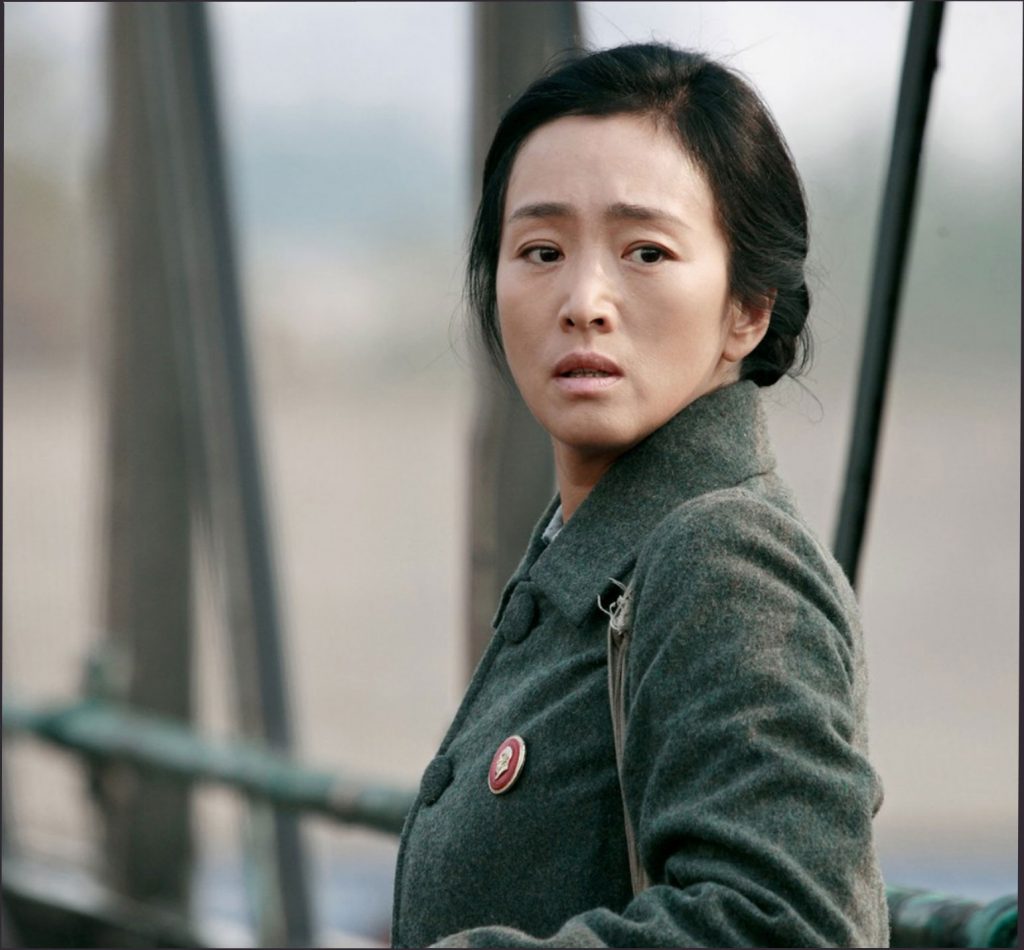
This image of Gong Li is from Zhou Yu’s Train (2004). Along with Olga Kurylenko, she is one of my top two actresses of all time. Mainly because both listen, react, and then speak. Way too many actors don’t do this. I’m using Li for my physical image of Tama.
Changing direction the wounded man rides toward the California Coast, eventually stumbling into a wooden shanty in Point Aloma, a Chinese enclave on the Monterey Peninsula. His arrival causes an uproar as the Chinese consider this white man a heathen, a devil, same as they do with all whites. Cheng arrives with news that the white devils hunt this heathen and that they make a gift of him.
An old man stands up for Hardin, as earlier he had seen him protect Cheng in the Stockton saloon. This brings the wrath of his Chinese brethren on him, but surprisingly Cheng agrees when white devils are seen riding toward the village.
Cheng hides Hardin in his house. But not all is good. The Chinese are wary of the devil within their midst and keep their distance. Hardin’s recovery is slow, and he has a difficult time adjusting to the cultural barriers. However, as he regains his strength, he attempts to fit in. Cheng’s children, and Tama, his sister, respond. The elders do not, and Cheng warns Hardin to keep to himself, as he is only welcome until he heals.
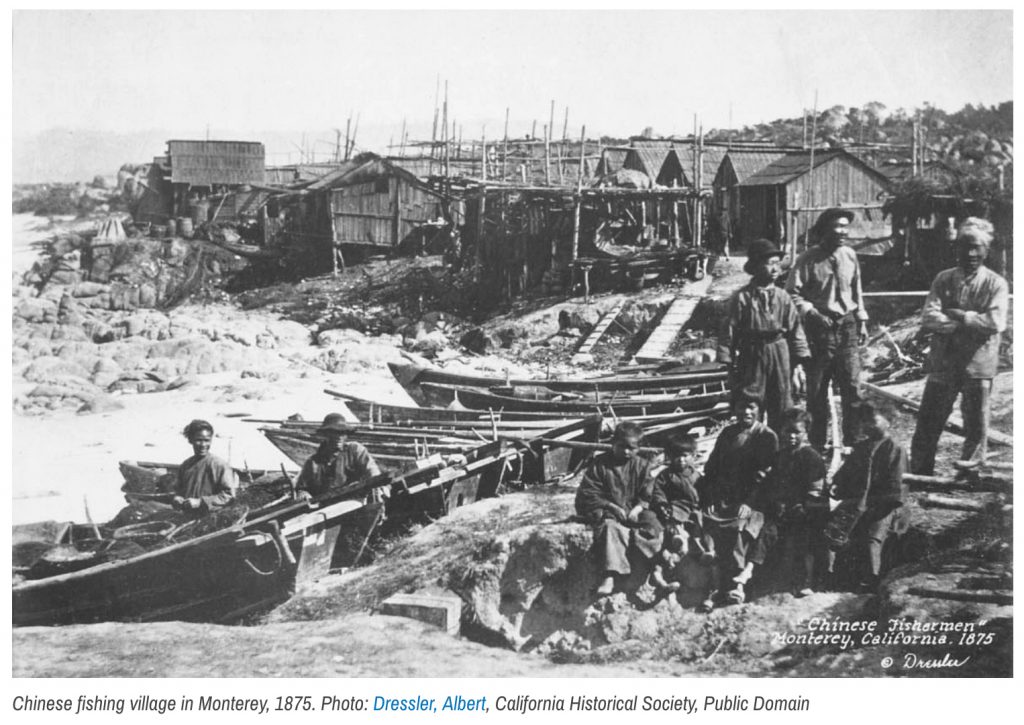
This is what a Chinese fishing town looked like on the Monterey coast about 10 years prior to Land of the Heathen.
When Cheng and the other men are at sea fishing whites invade Point Alones. Their assault includes rape of old and young. Hardin has recovered enough to step out from hiding and intervene, but Tama physically stops him. That night, after fishing, Cheng burns for revenge, but knows this cannot be. Then he sees the flicker of a relationship between Tama and Hardin. He takes Hardin aside and tells him that Tama is a rarity in the land of the heathen, the white man—a Chinese female who is not married and who isn’t a whore in the Devil’s world. She will marry one of her own. It’s simple: if Hardin touches her, he will die. … This is the beginning of the story.
Obviously this story is close to my life, and is a coin flip with Muse Eternal for which novel will be first. Best of all, and like Muse Eternal, I have a lot of research in house.
Reenter Howard Burnaugh,
LK’s documentation manager
at Infonet Services Corporation in El Segundo, California
I ought to say something here. In 1995 there was a major software convention in San Francisco that was free. …. Howard had hired me as a technical writer in 1990 with zero experience (my background consisted of design and freelance writing).
I asked him if I could attend the convention, pitching that it would expand my knowledge on how to improve the look and feel of the books I currently wrote and designed. Without hesitation he said, “Yes.” … Before I left his his office he told me that he’d only pay for the airfare. The quotes I obtained were high. When Howard saw them he said, “No, instead I’ll pay your gasoline.” … That night I called great friends Tony and Cindy Graham, who lived in Santa Cruz, and asked if I could stay with them while I attended the convention. They said yes. I told them that I’d arrive on Wednesday evening and return home early Sunday morning. Tony and Cindy were oh-so key in my brother Lee’s life. Their children Sarah and Anthony were very young at this time. … On Sunday I detoured to explore Monterey, and stumbled upon a photographer’s shop that featured Chinese photos from the nineteenth century that he restored, printed, and sold. I spent three or four hours with him and bought Chinese Gold before I continued my drive south. All I could think about were the Chinese. By the time I got home I had a story idea.
On Monday I handed my gasoline bill to Howard. At that time I drove a 1982 F-150 Ford pickup (which he knew), and it didn’t get good mileage. When he looked at the cost I thought that he would faint, but then his face turned beet red. It was a struggle not to laugh. “If you had agreed to the air flight,” I said, “I would have stayed in an expensive hotel in downtown San Francisco that I couldn’t afford, but you didn’t. I stayed with friends in Santa Cruz.”
Untitled Kit Carson/Indians (nonfiction)
This untitled, and most-likely my last nonfiction book that deals with race relations and American Indians on the frontier, will focus on Kit Carson.
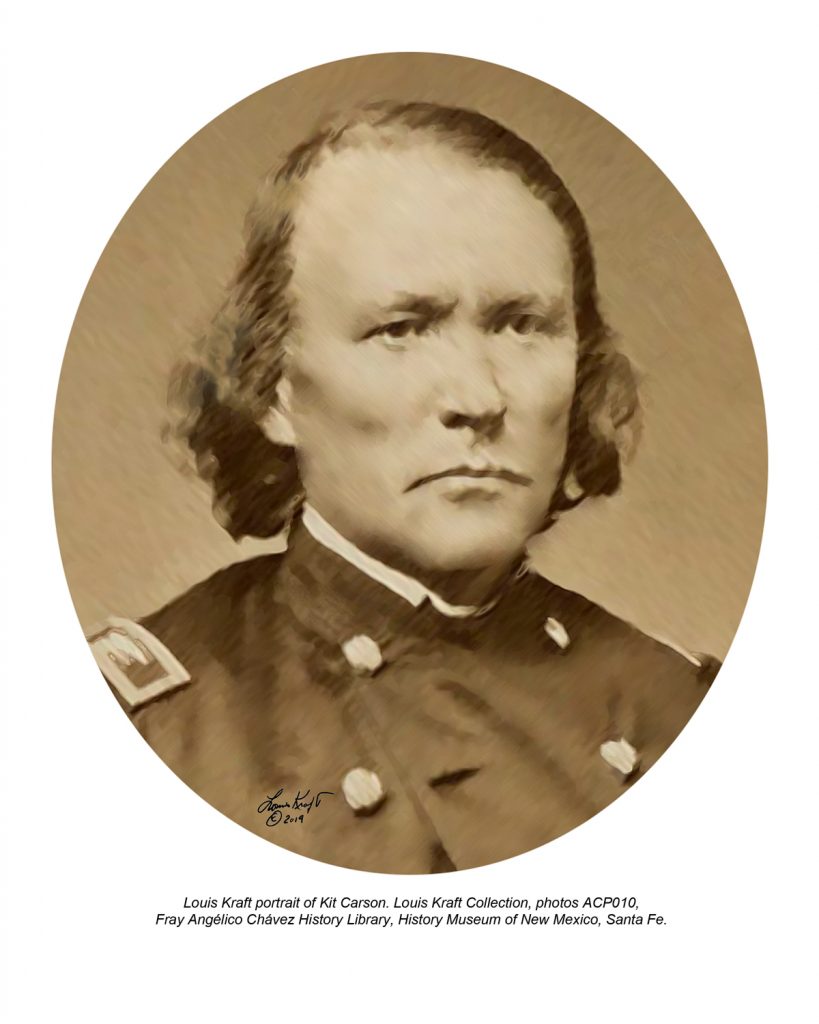
As the caption in the photo of this LK art of Kit Carson states, it is already in the first LK Collection at the Chávez History Library, and it is copyrighted art. … The art shows how Carson appeared in the first portion of the 1860s. This portion of Carson’s life may or may not be in my nonfiction manuscript. Research will be the determining factor.
This manuscript has been in the works for a long-long time, and is of great importance to me. And doubly so, for like my previous Indian wars books, it is a story that has never been told as I hope to tell it, and then with only a paragraph or three that shares nothing or is so fictional or biased that it should have never been printed. Shame on the publishers!
As always I have a lot of information that is already in-house, and much of it is primary research. But it is not enough. More primary source research is required, and it is mandatory to proceed with this manuscript. If I can’t discover and mine what is necessary it will be a tragedy for then my last nonfiction Indian wars book will have already been published.
For the record, if I am lucky, obtain long lost information, and draft a decent manuscript, my publisher of choice will be the University of Nebraska Press. If this happens, the reasons will be shared.
The Pirate Drake (fiction)
“The Pirate Drake” is mostly what I call Francis Drake, but I doubt if it will ever be a book title. … A lot about the pirate Drake needs to be said (but not here). This said, I should begin with director Richard Steele Reed, who was my acting manager in1976-1977. Unfortunately Richard is long gone, that is he no longer walks Mother Earth. After I had returned to Los Angeles after a summer of dinner theater in Lubbock, Texas, we contracted. It was a good working relationship, but it wouldn’t last. During this time we partnered on a novel dealing with Drake’s early piratical voyages to the New World. I wrote, and even then I had all the books published on Drake to that point in time, while Richard, who knew nothing about the pirate, edited. Alas, this story went on hiatus in 1977, which was good for me as my future life as a writer had just exploded although I wouldn’t realize this for years. This sounds like fiction—unpublished Kraft fiction—but it isn’t.
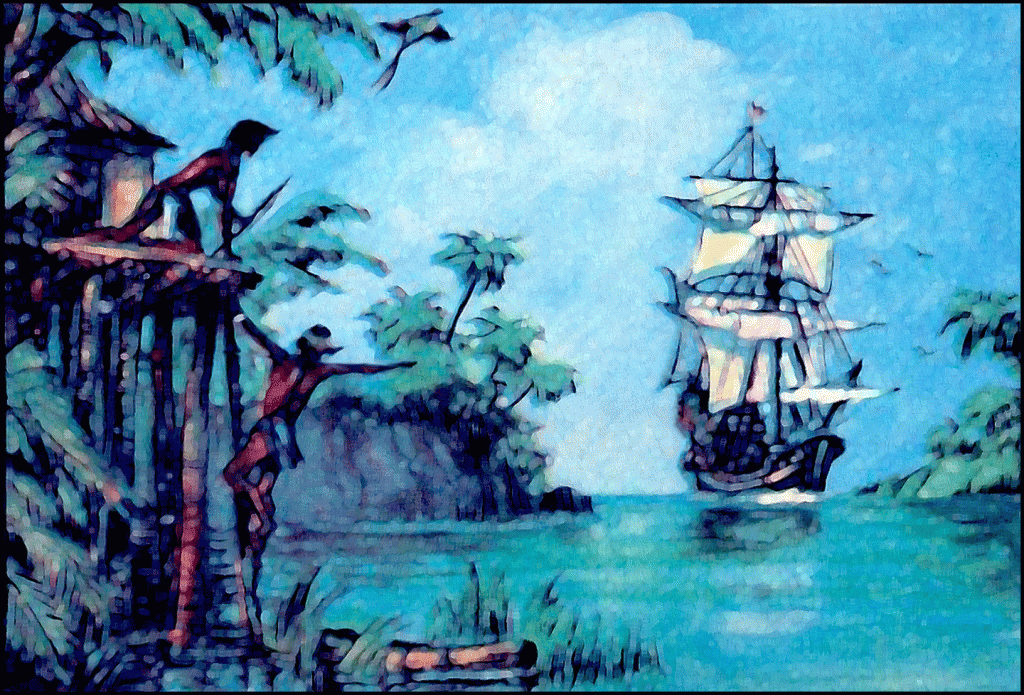
This image shows Drake’s ship entering a small harbor. His vessels were much smaller at the end of the 1560s and into the early 1570s. It was during this time he befriended the Cimarrons, mixed-blood African slaves who escaped from the Spaniards and married indigenous people who lived in Panama. The art is in the Louis Kraft Collection in Santa Fe.
This portion of Drake’s life isn’t well documented as there isn’t much documentation at this time of his life as he lived in obscurity. He sought revenge against the Spaniards who had promised that John Hawkins’ damaged fleet a safe harbor to repair vessels but then attacked and destroyed all the English ships save two: a small vessel named the Swan that Drake captained and another that Hawkins had boarded after his ship was engulfed in flames. … As soon as possible Drake made exploratory trips to the Caribbean Sea and the Spanish mainland to decide how he would begin his private war against Spain. During this time he wooed and won Mary Newman, who became his wife in 1569. The pirate Drake’s war against Spain began in 1572.
The Pirate Drake (nonfiction)
… And he has the potential of jumping to the top of this list in a heartbeat but it won’t happen. This is no joke. No joke. Francis Drake has been with me since early childhood, but for some reason has always been pushed to the back of my writing life.
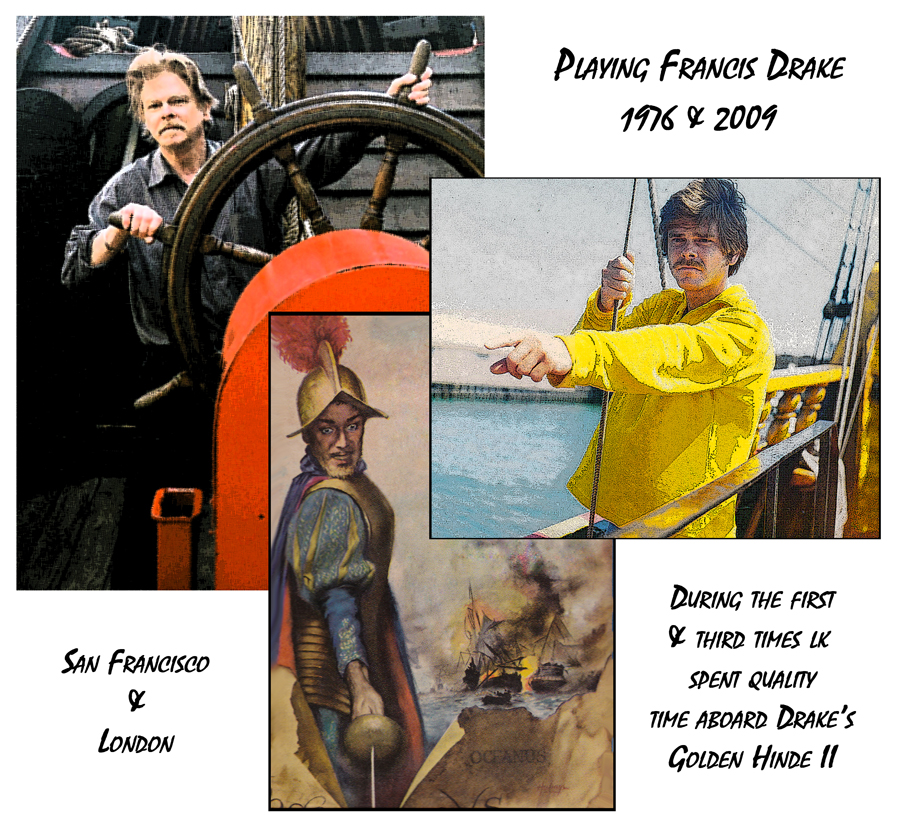
The second time was when the Golden Hinde II was docked in Oxnard, California, but I only have photos of the vessel and not of me on it.
For the record, I’ve always been a pirate, and have always walked shoulder to shoulder with Francis Drake. I’ve made a point of exploring the Golden Hinde II as this was the vessel in which he circumnavigated the globe (1577-1580). Folks, this was a major accomplishment.
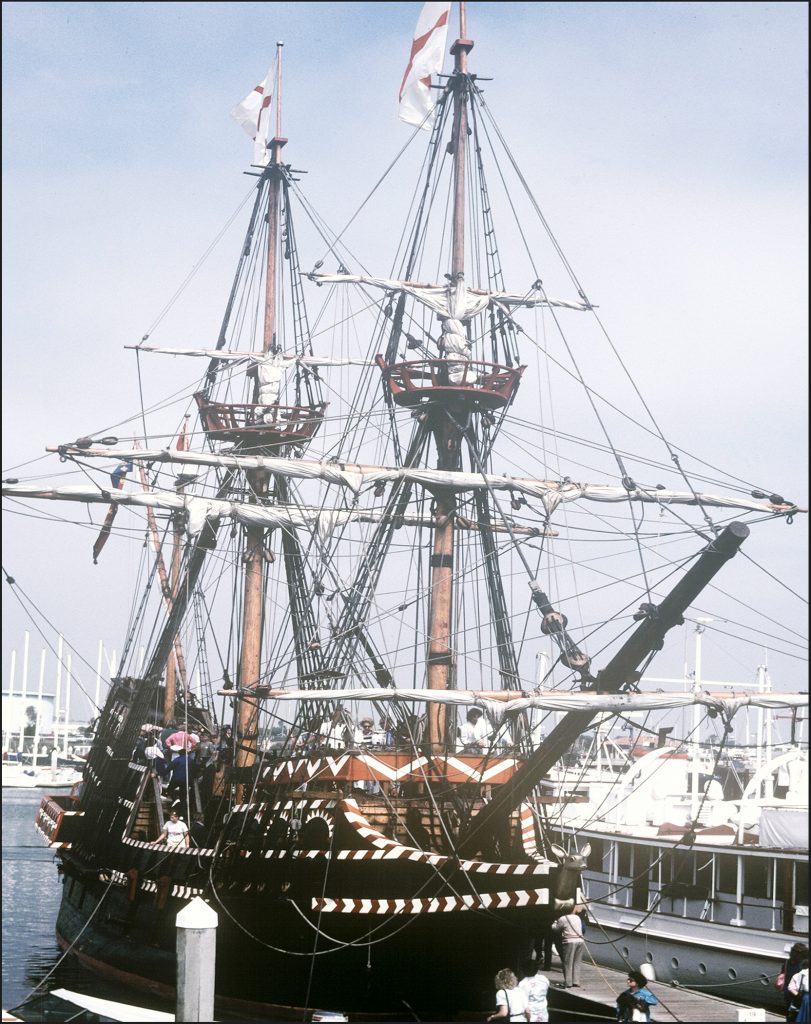
LK photo of the replica of the pirate Francis Drake’s Golden Hinde II in Oxnard, California (June 1988). Unlike my first and third times aboard his vessel I didn’t have it to myself, as his ship was jammed with people. (photo © Louis Kraft 1988)
Francis Drake was an exceptional human being. If you study the second half of the sixteenth century and are aware of the racial and religious hatred that were predominant, and more the brutal and at times the savage butchery of human beings at this time, you may understand my attraction to Drake the pirate.
Yes, he was a pirate, and the Spaniards considered him a pirate during his entire life even though he was knighted by Queen Elizabeth I of England after the circumnavigation. But he wasn’t the typical bloodthirsty pirate who butchered other human beings. Instead he treated them with respect (even though he hated Spain for their heinous murder of indigenous people in the New World and Protestants whenever captured). By the end of my college years Drake had hooked me, and thereafter I have purchased everything on him that I could find.
What’s this book going to be about? I’m not sure yet, but it will not deal with anything in my novel about him. For more on the pirate Drake see: https://www.louiskraftwriter.com/2017/05/20/the-pirate-francis-drake-and-louis-kraft/.
Phraya Phichai Dap Hak, the soldier with the broken sword (fiction)
I discovered Phraya Phichai on my second full day in Thailand in November 2014 after I joined Pailin in her homeland, and it was her first visit since leaving in 2004. We mostly stayed with family and friends (one cottage on my first night after joining Pailin and one hotel on our next to last night). Pailin’s good friend Colonel Daranee Konsin (retired) opened her home to us in Lampang. Her statue was the same as I would see time and again. Next we lived with Not and Font Subanna (they are Pailin’s sister and brother-in-law). We spent nine or eleven days with them in Uttaratt and the trip to Bangkok.
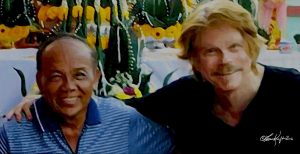
Art of Font Subanna & LK at his home in Uttaradit, Thailand, on his birthday (27nov2014). I created the painting in 2016. (art © Louis Kraft & Font Subanna 2016)
Sabrina Subanna, Not and Font’s daughter, and Pailin’s niece is her only relative in the USA. Luckily Sabrina and her hubby Carlos Castillo live near us as Pailin and Sabrina are sisters. Sabrina’s sister Lek and her husband Sophon, who live walking distance from her parents, gave us a tour of their city, and as I learned it featured Phraya Phichai. This included a huge museum that housed three paintings of him and finally the Temple where there is a huge statue of him (that the small ones replicate) plus a museum that featured him.
A boy named Choi (which meant “little one”) was born in 1741. While still a boy Thai boxing grabbed hold of his life and would not let go. Without his parents knowledge he studied it. At an unknown date he met Thiang, a master trainer who saw his potential. Although unknown at the time, their connection was key to the boy’s future. When twenty years old and now known as Thong Di he was in the town of Tak during an annual festival that included boxing matches. An unknown in the boxing world, he entered the contest but refused to fight anyone but the best. Arjarn Nai Hao, the town’s master agreed to the fight anticipating an easy victory. To the crowds’ surprise, the upstart defeated the master. Phraya Tak, who hosted the boxing matches and was an officer in the Thai army, asked Thong Di to enlist. He did.
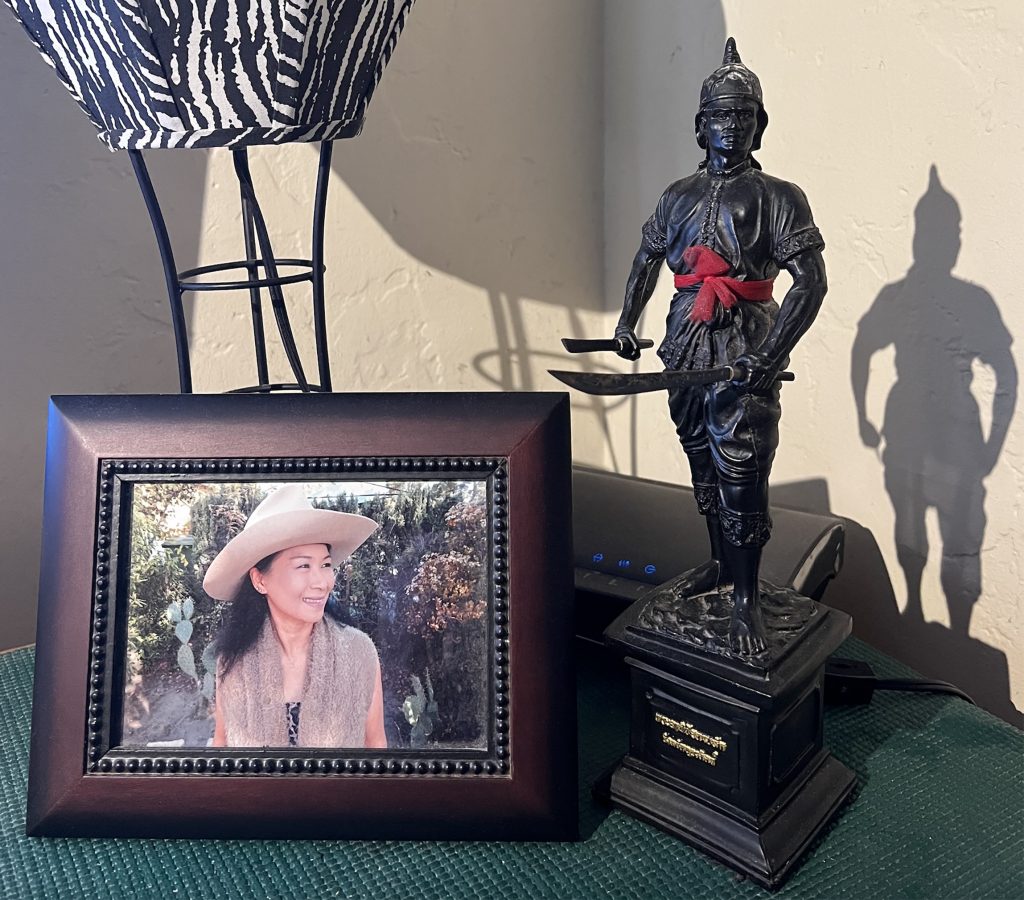
Who says they don’t raise cowgirls in Thailand? Not true and I have photos to prove it. What you see here is Pailin Subanna in the front yard of Tujunga House in 2013. My bro in Thailand Font Subanna gave me his statue of Phraya Phichai in 2016 when Pailin visited. The soldier with the broken sword has been on my desk ever since. (photo © Louis & Pailin Kraft 2022)
Years passed, and Phraya Tak became King Taksin, “the great of Thonburi.” During all this time Thong Di never lost a boxing match. This impressed King Taksin and he asked him to become his bodyguard. But King Taksin’s kingdom was only a portion of Siam, much of which was under Burmese control. Between 1766 and 1769 Kao Tsung, the emperor of China, invaded Burma four times to stop its aggression but failed.
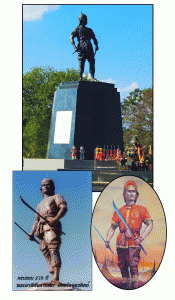
LK took the photo of the monument to Phraya Phichai Dap Hak. Lek and Sophon spent one perfect day with Pailin and myself in 2014, and it concluded here. They purchased the postcard (left) for me. The art at right was created by a monk (I have his name and need to find it). (photo © Louis Kraft 2014)
During this time Phraya Tak/King Taksin saw an opportunity and began a revolt with 500 followers including Thong Di. at one point Taksin was forced to flee to the East Coast of Siam. It was here that due to Thong Di’s prowess in battle and leadership abilities Taskin made him commander-in-chief of the military. Total war was declared against Burma. Thong Di, who fought with two swords, at the front of his army, hadn’t broken his sword yet. When he did it would turn him into a legend.
With Pailin I am lucky to enjoy many video phone calls to family and friends in Thailand. I enjoy our talks with TookTa (Monrumpha Subanna), Pailin’s sister, who I didn’t meet when I visited their homeland. During a recent conversion with my lady and TookTa she asked about my projects. I told about “Phraya Phichai Dap Hak,” the soldier with the broken sword and of my desire to hire a Thai historian who was fluent in English to do primary source research with me when next I travel to a country that has welcomed me with open arms.
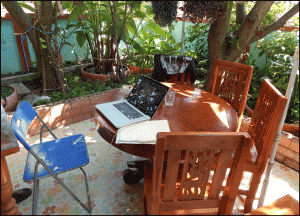
LK’s office in the backyard of Not and Font Subanna’s home in Uttaradit on 26nov2014. (photo © Louis Kraft 2014)
TookTa told me that there isn’t much known about him. I replied that was what I thought. If true, and I totally strike out, it would eliminate any chance doing a nonfiction book on his life. Still hope burns eternal.
I have dueled with sabres in competition, I have learned swashbuckling/stage combat and have choreographed and fought duels on stage. When I return to Thailand I want to learn how to duel with two Thai swords.
Thai culture, language, religion, dialogue, action, character development and Phraya Phichai Dap Hak’s life will make a great novel.
LK’s future writing life has arrived.

